A Lowly Crocus Cheers Me Up On A Windy Day
Tuesday, March 31, 2009
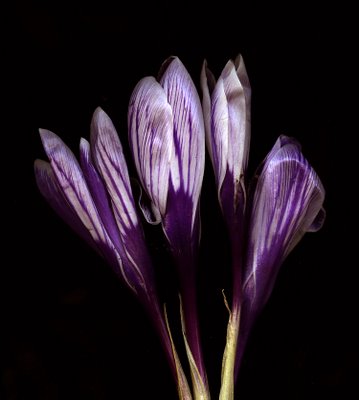
The name crocus comes from the Greek krokos (κρόκος), which like the Hebrew karkōm, Aramaic kurkama, Persian and Arabic kurkum means saffron or saffron yellow.
The genus Crocus is in the iris family (Iridaceae). They grow from corms and are mainly hardy perennials, and are found in a wide range of habitats, including woodland, scrub and meadows. There are about eighty species of crocus (of which approximately 30 are cultivated). Their cup-shaped, solitary, salverform flowers taper off into a narrow tube. The spice saffron is obtained from the stigmas of Crocus sativus, an autumn/fall-blooming species.
Pruning my dead or dying roses even on a bright sunny day is not a cheerful task particularly as it was windy and cold. Many of my plants do not look all that good. Perhaps it is too early in spring to make an opinion. There is a slim possibility that in a few weeks I might see some new growth from underneath the dead canes of my roses.

In the middle of my round rose bed I spotted the mauve crocuses. Rosemary swears at them in late spring. After they flower they send up mounds of green leaves that mess up the tidiness of the rose bed. She gets on her knees and cuts them off in late spring. Our crocuses are either volunteers or someone planted them before we came to the house. They are cheerful and give colour when nothing much is in colour. You have to separate the petals to look on the bright orange (saffron yellow?) stigmas. In their own way my crocuses made my day.
Counting My Blessings - A Is For Zebra
Monday, March 30, 2009

This morning I photographed a prosperous lawyer from Vancouver’s largest tax law firm. I had last photographed him 20 years ago and he was in need of a new photograph for his firm’s web page. We spoke at length as to what we had done since we last met in the studio all those years ago. I was floored when he told me that he had two sons in their 20s and that both had muscular dystrophy. It seems that both inherited it yet as far as my subject lawyer could recall nobody in his family had ever had the disease. I looked at my subject’s face lines (many but a handsome man indeed) with a different light.
I called a friend after my shoot. We had a chat and a coffee at the Sears Starbucks. My friend has a teenage son with an active version of autism. I was thinking of my Maserati Biturbo when he told me of his travails with his son. I remember one day that I was driving my maroon Maserati on the ramp leading to the Granville St Bridge. I applied to the gas pedal enough pressure “to clean the sparkplugs” as my friend Sean Rossiter would say. My passenger was rocker/journalist John Armstrong. He was wowed as his head stuck to the seat at the sudden surge of the twin turbos. I remember telling Armstrong, “This car is rarely without some mechanical malady but when it is just right it soars and the noise from the tailpipes is pure music.”
The only problem is that whenever I voice this or even think of it, something breaks and I have to spend a lot of money. A couple of days after the bridge incident my car developed a transmission clunk. I finally gave up trying not to think or to tell anybody what a pleasure it was to drive my Maser because I was emptying my bank account and transferring all of the funds to one very happy and ever richer Girolamo Clemente, my lucky mechanic. I parked the car and it lies forgotten in my garage.
I was thinking of my Maserati because I was thinking of my family and how none of my daughters have any diseases or health issues. Our granddaughters, Lauren and Rebecca are healthy, too and pretty to boot. Could things be any better? Is this a Maserati situation where I should keep my mouth shut and not even think of it?
My friend at coffee said something like, “I am jealous of you but happy for you. Take advantage of it.” He need not have said it as I am now fully aware of my luck.
I told my Hilary and my granddaughters at the table tonight (Rosemary was away taking a computer course) how I savoured the moment we had together and if it meant I had to cook for them (something I always do when they come over) I would do it gladly. I told them that if I was suddenly diagnosed with some sort of lethal cancer I would not be fazed as anything past half a century is just extra. I have almost 17 years of extra time. When I mentioned that dying at this point would not upset me in the least it was Lauren (6) who said, “You should not be talking about these things at the dinner table.” Rebecca added, "You must live one day at a time and enjoy it." I am sure that at her age (11) I would have never thought of such "rubbish" or even dared to have uttered the recommendation to my grandmother.
After our dinner Rebecca and Lauren invited us to a puppet show. One puppet (Rebecca as a dog) would say, “A is for airplane.” Lauren, the rabbit would repeat, “A is for zebra.” The dog would get furious and make the rabbit repeat it correctly. The next time around the rabbit would again say, “A is for zebra.” And on it on it went and I laughed!
Thinking about Art Bergmann’s concert on Thursday I had a look at all my Bergmann records, tapes and CDs. There was one I had forgotten about, Art Bergmann –Design Flaw where he plays a 6 string and a 12 string acoustic guitar while being accompanied by Chris Spedding on electric guitar. There was no drum, no bass, nothing to distract from the lyrics and that unique Bergmann voice. As I listened to my fave, the Hospital Song, Hilary read the very complete liner notes of the Zulu release Young Canadians – No Escape which is all about Art Bergmann’s early career.

Tonight has been about as perfect a night as I could possibly imagine. I found this picture of Hilary taken with my Widelux, swivel lens panoramic camera. I asked Hilary a few questions. She was 17 and it was late spring. She was in grade 11. She had been invited to the graduation of one Thomas Chromey who was graduating from Kitsilano High School. Hilary is wearing Rosemary’s Mexican colorín jewelry. I asked Hilary about the dress. “I borrowed the dress from Ale (her older sister) who had many formal dresses because she went to York House (a Vancouver private school for girls).” I looked at the picture. We had moved to Athlone three years before, in 1986. The three conifers on the right are all gone. They succumbed to root rot. The garden is changed. But we are still happily here.
I am thankful and appreciative that we are.
Sunday, March 29, 2009
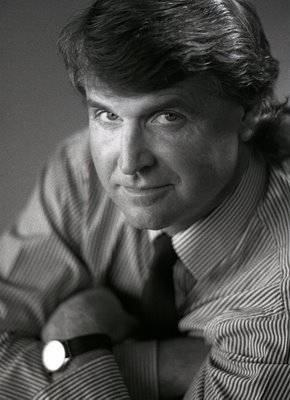
I have been a bit miffed with the Vancouver Sun for their oversight in not running either an obituary or a memorial piece on the March 6 death of Vancouver choreographer Lola Maclaughlin. You can imagine my anger on seeing a full page obituary on the Sun lawyer and media law expert Barry Gibson in the Saturday Sun. Why would we care?
I was wrong. I noticed that the obituary writer was David Baines (left). I then read and was fascinated since many of the people mentioned in the piece crossed my path, too. The one page obituary is a fascinating history of important events in Vancouver’s past. Barry Gibson as described by Baines was a gem. We have lost an important personality who in many ways, by defending the Vancouver Sun (and other papers and magazines) from libel law suits and to gain information blocked by judges, has helped us in knowing the truth on events that have shaped our city. This obituary deserves wider dissemination. Read it here.
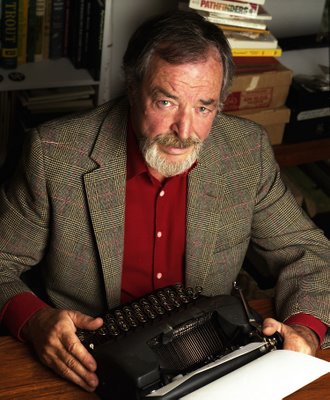
After reading this fine obituary which mentioned that Barry Gibson inherited the beat from that other expert libel lawyer, Peter Butler I remembered a story that I heard from both sides (writers Lyndon Grove and Ben Metcalfe) that involved libel, the media and Peter Butler.
In the early 70s the previous incarnation to Malcolm Parry's Vancouver Magazine was Vancouver Life which was published by Dick MacLean. I met Dick MacLean and his son while renting cars for Tilden Rent-A-Car on Alberni Street because his son washed cars for us. By then Dick Maclean was publishing something called Dick Maclean's Guide which listed events and restaurants in our city. But Vancouver Life was not a bad city magazine. A couple of writers I subsequently worked for, Lyndon Grove and Ray Torresan worked for Dick Maclean's Vancouver Life. Lyndon Grove (who was also a most competent radio announcer with a voice just like Walter Cronkite's) was assigned to write a feature story on Vancouver critics. Grove wrote the piece and submitted it to MacLean. Between submission and the magazine going to press some changes and additions were made to Grove's article without Grove knowing about it. The article asserted that CBC theatre critic Ben Metcalfe, top, right, had the habit of reviewing plays that he had not personally attended. The magazine went to press and the next day Dick MacLean was served a scary document signed by one called Peter Butler. Few knew then or now that Butler was Metcalfe's brother-in-law.
Ben Metcalf died in 2003. Yesterday I called his widow, Dorothy for some sort of corroboration of the story. Grove had told me that he had not written the offending sentence and that his editor had an ax to grind with Metcalfe. Dorothy Metcalfe told me on the phone, "Did you call me to rile me up, Alex?" The writer should have demanded a retraction by the magazine (I do not know if a retraction was made). Writers have to defend their honour and sense of ethics. As she told me I thought of one occasion (and there were others) when an editor of Western Living trashed a story I had written in its entirety and published something he/she wrote but still kept my name. I attempted to defend my honour by calling the editor and saying, "Thank you so very much. You made me sound like Shakespeare." The answer to my cynical remark was a pleasant, "You are welcome." I was unable to make Dorothy Metcalfe understand that loud complaining can blackball a freelance writer and photographer so that work will be impossible to obtain.
Dorothy Metcalfe told me that the direct result of Butler's libel document was, "They settled at the steps of the law courts."
I worked with Ben Metcalf on many stories for what became the next incarnation of Vancouver Life. Vancouver Magazine was published by Ron Stern and edited by Malcolm Parry.
Ben Metcalfe told me many stories. One of them happened when he was a reporter for the Province which at the time was published by Thomson and competed with the Vancouver Sun which was part of the Southam empire. It seems that a group of Mafioso that Metcalf wrote about kidnapped him and kept him for several weeks. I have forgotten how Metcalf escaped his predicament. In another story he told me, "There was this short funny girl who came to pick up my copy at my desk at the paper. Her name was Pat Carney."
Many years later Malcolm Parry assigned writer Mark Budgen to write a profile on MP Pat Carney. In a show of ethics that would have brought a smile on Dorothy Metcalfe's face, Budgen told Parry that he (Budgen) did not agree with the policies of Carney and of her party and that he was not accepting the assignment. Parry then assigned the story to Metcalfe's partner in Greenpeace, Robert Hunter and I took the picture.
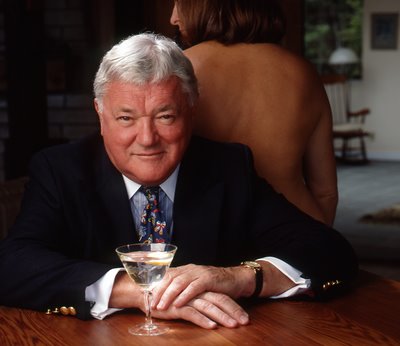
Another player in my libel memories was Allan Fotheringham, left, a man I photographed many times. It happened in 1986. I remember that it all happened in an Air Canada jet and that Fotheringham was sitting behind two lawyers and overheard their conversation. He lost the much publicized libel suit. In a 1984 Macleans column he'd stated that the two Vancouver lawyers, both associates of Liberal leader John Turner, were "cementing their connections through the tennis club circuits and the wife-swapping brigades". Despite two printed apologies, the court awarded the lawyers $10,000 each in damages. One of my favourite moments with Dr Foth, as Fotherigham was affectionately called, happened in the 1986 Socred Convention in Whistler that was ultimately won by Bill Vander Zalm. It was nine in the morning and I spied Fotheringham enter with a large brown bag under his arm. I followed him up some stairs. He sat down at his cubicle and pulled a case of beer. He took out a can and opened it. As he began to sip it I took my photo. Alas the colour transparency is not currently in my Fotheringham file!
The last time I photographed him was for a profile in Toronto Life. I was dispatched to some nearby island (Bowen, I believe) and he kindly posed with a martini and his perfectly nude mistress behind him.
For some reasons that I will not go into here I can point out that Fotheringham and Metcalfe did not like each other. Sometime in the early 80s, in his Georgia Straight column, Metcalfe hinted that Fotheringham was having a homosexual affair with the scion of the Southam publishing fortune, Harvey Southam who at the time had started a business magazine called Equity. Southam's office was not far from Malcolm Parry's as they shared a publisher, Ron Stern. Equity quickly became a much better business magazine than BC Business which to my mind featured questionable edtorial content.
One day, a few months after Metcalfe's offensive Straight column, I was returning with Harvey Southam in his white Mercedes from a trip to Whistler. We had gone there to interview (and for me to photograph) Peter Brown, below, who had recently purchased a restaurant there. We were munching chocolate covered expresson beans (not a good snack when navigating tight curves with only one working headlight.
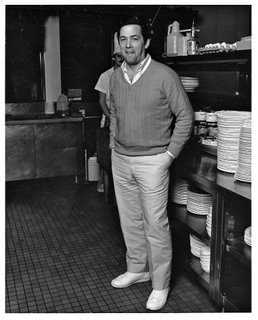
We were chatting about magazines and I decided that I would give Southam a suggestion. "Harvey, I think you should hire some literary writers to write about manly things for your magazine. I would think that Ben Metcalfe would be a good beginning." With a kind smile on his face Southam looked at me and said, "I really admire Ben's writing and his literary capabilities. At this moment, I think I will pass on your suggestion." And that was it. Southam had class and seemed to harbour no animosity to the man. I was impressed. I learned to love the man and we had a fond business relationship.
After Harvey Southam left Equity (in the questionable hands of Mike Campbell, the Premier's brother) Equity ran several covers that would not have passed muster in our more careful times. I wonder what Barry Gibson would have said of a cover (the most infamous of them all) that featured Premier Mike Harcourt and his Finance Minister Glen Clark dressed (courtesy of Photoshop) in Nazi brown shirt uniforms? I know that Harvey Southam would have never allowed it.
Addendum by Lyndon Grove on October 18, 2009
The addendum was preceded by Grove's e-mail
The other evening I stumbled upon one of your blog entries recounting
the tale of the Ben Metcalfe libel suit. Ben is now, I believe, pleading
his case in a higher court. Entertaining story--at this remove--but not
entirely accurate. If you'd like what I believe (Rashomon like) to be
the true story, send an e-message.
Incidentally, I have recently, as a form of cerebral exercise, launched
a blog of my own: here
Trust this finds you enjoying a pot of tea and some mellow jazz.
Regarding the Metcalfe/Grove libel case:
The magazine involved was not Dick MacLean's Vancouver Guide (to which I had contributed the odd piece, and I remember with fondness MacLean's very attractive wife at the time, Carole Stewart, whom I had known at CHQM and later as public relations director at the Hyatt Regency--but that, of course, is not the story).
No, the magazine was Vancouver Life & About Town, launched into life by the flamboyant former Vancouver Sun publisher Don Cromie (who later purchased Palm Springs Life and set into motion Toronto Life). And, in this period, I served as editor (number two or three out of an ultimate six).
The article at the centre of the case was titled "Gentlemen, This Time the Heat's On You." It was intended to be a criticism of Vancouver's reigning critics in all areas of the arts. Through the efforts of Nelles Hamilton, then assistant editor, we were able to draw all of the critics into a studio and photograph them gathered around a stepladder, the significance of which is lost to memory.
To write the article, we commissioned the urbane Bill Phillips, and he turned in the story as required. And that's when the problems began. Some of us felt the piece needed more zip, and, as I had Bill's notes, I began adding material from them to the story, without consulting the writer. Serious error. Among his notes was a comment from Malcolm Black, then artistic director of the Playhouse Theatre Company, who was said to have said something like this: How can Vancouver Life criticize critics when its own critic reviews a play without even seeing it?
I thought this was a charming bit, and threw it into the mix. Ben Metcalfe was then Vancouver Life's theatre critic, and if I had been more than six years old, I would have called him, too. But I didn't. Instead, his lawyer called us. And he wasn't alone. We had a call as well from a lawyer representing Jonathan Baker, a sometime music critic for The Province, a flautist, and a civic official. Both Metcalfe and Baker sued. Metcalfe's case was helped by Black's denial of the words attributed to him. I cannot remember Baker's complaint. In any event, his suit was minor, and Cromie said, "Pay him his two dollars and fifty cents and let him go."
The Metcalfe suit reached the trial stage, and the magazine's eminent and enormously skillful lawyer George Murray, who, like a great football player, could work both offence and defence, was convinced Vancouver Life could win. Indeed, Metcalfe's lawyer, Peter Butler, had approached Murray with a settlement offer. But it happened that a pro-am golf tournament was about to take place at Point Grey, and Cromie had a chance to play on a foursome that could include Palmer or Nicklaus. "How long would I have to be here?" he asked. "A day or two," said Murray. "Well, I can't miss the game. Let's give him the money and go."
And that's what happened. Phillips and I went to Sir Walter Raleigh and had a lunch that lasted the entire afternoon, as Ruben Kopp continued to pour Slivovitz.
I must confess, that almost fifty years later, I have some nervousness in telling this story, worrying that some complainant and his lawyer may leap up out of the past and launch another libel suit. In which case, I say this: this is entirely fiction.
Lyndon Grove.
David Baines
More David Baines
And More David Baines
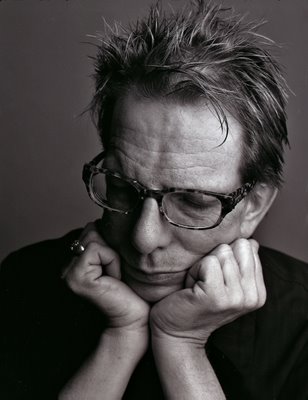
As the amateur that I am, I can assert without any compunction that the best rock guitarist I have ever heard is Art Bergmann. His unusual voice (like listening to someone talk on a faulty cassette tape recorder with wow) is secondary in my appreciation of the man. On the other hand there is his music. There are his lyrics.
An Art Bergmann performance without his guitar playing is an Art Bergmann performance diminished by more than half. While Bergmann has little respect for such mundane objects as microphones (he demolished one in this Thursday’s performance at Richards on Richards), perhaps he vented his anger at not being physically capable of playing the guitar on the microphone and its uncooperative stand. As I watched Tony Balony (a.k.a. Anthony Walker) play his guitar most competently and even with some touch of virtuosity I noticed how he stood and how he hammed it up. Bergmann always treated his instrument with respect even if he banged it here and there. The guitar was nothing to make fun of. With a guitar in hand Bergmann dominated the stage. With Jim Bescott on bass and Bary Taylor on drums the K-Tels/Young Canadians of 1979/1980 were the finest rock band I ever heard. Later Art Bergmann bands were tolerable and sometimes even wonderful as long as Bergmann sang and played that guitar.
Thursday Night I was right under Bergmann’s microphone leaning on a monitor. Few are aware that paradoxically the closer you are to the middle of a very loud rock band the less loud it is. Next to me was former Los Popularos bassist Tony Bardach and his lovely trophy daughter Alexa with painted red lips and a look reminiscent of Moev’s Madeleine Morris. Behind me was Ingrid (an old flame of Bud Luxford) and Solei (Soledad) an early old flame of Bergmann’s. I felt much at home.
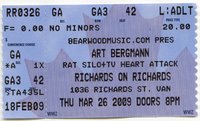
I am keenly aware that there was no way that Bergmann could have played his guitar. He managed, more or less, to sing. Halfway through the performance he either decided to ignore the intense pain of his back and of his knees because he suddenly stood almost straight. In my studio, the day before, he had fallen face first when he leaned too far forward in my posing chair. While he insisted that everything was fine I am sure that was not the case.
Bergmann walked around the Richards on Richards stage without falling in spite of not wearing the glasses he almost stepped on. Few of the crowd would have known that Bergmann was pretty well blind without glasses back in 1980!
I watched young girls around me with constant smiles in their faces dance while Bergmann sang Our Little Secret. “What a lovely tune. What a lovely pop song this is,” they must have thought as I pondered on the fact that the song in question was about incest. As I drove home I experienced the instant satisfaction of listening to Lost Art Bergmann, the previously unreleased CD mixed by Bob Rock. It’s smooth, it’s lively, it’s clear; the tunes sound like pop songs. This is Bergmann at his best pop-song-best. Can that be possible? Am I getting so old that it sounds like stuff I could play to my granddaughters?
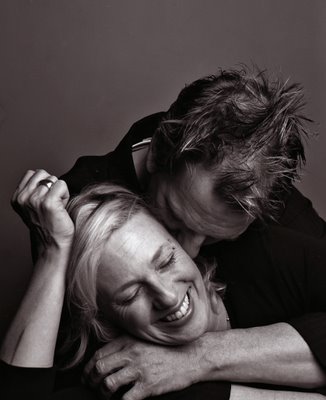
But then there are the lyrics. And there is that guitar. Art Bergmann did not play his guitar on Thursday. But his guitar was in my head and that was more than enough.
Outside, after the concert, I ran into Gord Nichol who played with Bergmann in Los Popularos. "Alex did you ever think in a million years that this would happen?" "No," I answered. He did not have to say what we both thought. This would never happen again as we smiled at our mutual good fortune of having been there.

I have been a bit miffed with the Vancouver Sun for their oversight in not running either an obituary or a memorial piece on the March 6 death of Vancouver choreographer Lola Maclaughlin. You can imagine my anger on seeing a full page obituary on the Sun lawyer and media law expert Barry Gibson in the Saturday Sun. Why would we care?
I was wrong. I noticed that the obituary writer was David Baines (left). I then read and was fascinated since many of the people mentioned in the piece crossed my path, too. The one page obituary is a fascinating history of important events in Vancouver’s past. Barry Gibson as described by Baines was a gem. We have lost an important personality who in many ways, by defending the Vancouver Sun (and other papers and magazines) from libel law suits and to gain information blocked by judges, has helped us in knowing the truth on events that have shaped our city. This obituary deserves wider dissemination. Read it here.

After reading this fine obituary which mentioned that Barry Gibson inherited the beat from that other expert libel lawyer, Peter Butler I remembered a story that I heard from both sides (writers Lyndon Grove and Ben Metcalfe) that involved libel, the media and Peter Butler.
In the early 70s the previous incarnation to Malcolm Parry's Vancouver Magazine was Vancouver Life which was published by Dick MacLean. I met Dick MacLean and his son while renting cars for Tilden Rent-A-Car on Alberni Street because his son washed cars for us. By then Dick Maclean was publishing something called Dick Maclean's Guide which listed events and restaurants in our city. But Vancouver Life was not a bad city magazine. A couple of writers I subsequently worked for, Lyndon Grove and Ray Torresan worked for Dick Maclean's Vancouver Life. Lyndon Grove (who was also a most competent radio announcer with a voice just like Walter Cronkite's) was assigned to write a feature story on Vancouver critics. Grove wrote the piece and submitted it to MacLean. Between submission and the magazine going to press some changes and additions were made to Grove's article without Grove knowing about it. The article asserted that CBC theatre critic Ben Metcalfe, top, right, had the habit of reviewing plays that he had not personally attended. The magazine went to press and the next day Dick MacLean was served a scary document signed by one called Peter Butler. Few knew then or now that Butler was Metcalfe's brother-in-law.
Ben Metcalf died in 2003. Yesterday I called his widow, Dorothy for some sort of corroboration of the story. Grove had told me that he had not written the offending sentence and that his editor had an ax to grind with Metcalfe. Dorothy Metcalfe told me on the phone, "Did you call me to rile me up, Alex?" The writer should have demanded a retraction by the magazine (I do not know if a retraction was made). Writers have to defend their honour and sense of ethics. As she told me I thought of one occasion (and there were others) when an editor of Western Living trashed a story I had written in its entirety and published something he/she wrote but still kept my name. I attempted to defend my honour by calling the editor and saying, "Thank you so very much. You made me sound like Shakespeare." The answer to my cynical remark was a pleasant, "You are welcome." I was unable to make Dorothy Metcalfe understand that loud complaining can blackball a freelance writer and photographer so that work will be impossible to obtain.
Dorothy Metcalfe told me that the direct result of Butler's libel document was, "They settled at the steps of the law courts."
I worked with Ben Metcalf on many stories for what became the next incarnation of Vancouver Life. Vancouver Magazine was published by Ron Stern and edited by Malcolm Parry.
Ben Metcalfe told me many stories. One of them happened when he was a reporter for the Province which at the time was published by Thomson and competed with the Vancouver Sun which was part of the Southam empire. It seems that a group of Mafioso that Metcalf wrote about kidnapped him and kept him for several weeks. I have forgotten how Metcalf escaped his predicament. In another story he told me, "There was this short funny girl who came to pick up my copy at my desk at the paper. Her name was Pat Carney."
Many years later Malcolm Parry assigned writer Mark Budgen to write a profile on MP Pat Carney. In a show of ethics that would have brought a smile on Dorothy Metcalfe's face, Budgen told Parry that he (Budgen) did not agree with the policies of Carney and of her party and that he was not accepting the assignment. Parry then assigned the story to Metcalfe's partner in Greenpeace, Robert Hunter and I took the picture.

Another player in my libel memories was Allan Fotheringham, left, a man I photographed many times. It happened in 1986. I remember that it all happened in an Air Canada jet and that Fotheringham was sitting behind two lawyers and overheard their conversation. He lost the much publicized libel suit. In a 1984 Macleans column he'd stated that the two Vancouver lawyers, both associates of Liberal leader John Turner, were "cementing their connections through the tennis club circuits and the wife-swapping brigades". Despite two printed apologies, the court awarded the lawyers $10,000 each in damages. One of my favourite moments with Dr Foth, as Fotherigham was affectionately called, happened in the 1986 Socred Convention in Whistler that was ultimately won by Bill Vander Zalm. It was nine in the morning and I spied Fotheringham enter with a large brown bag under his arm. I followed him up some stairs. He sat down at his cubicle and pulled a case of beer. He took out a can and opened it. As he began to sip it I took my photo. Alas the colour transparency is not currently in my Fotheringham file!
The last time I photographed him was for a profile in Toronto Life. I was dispatched to some nearby island (Bowen, I believe) and he kindly posed with a martini and his perfectly nude mistress behind him.
For some reasons that I will not go into here I can point out that Fotheringham and Metcalfe did not like each other. Sometime in the early 80s, in his Georgia Straight column, Metcalfe hinted that Fotheringham was having a homosexual affair with the scion of the Southam publishing fortune, Harvey Southam who at the time had started a business magazine called Equity. Southam's office was not far from Malcolm Parry's as they shared a publisher, Ron Stern. Equity quickly became a much better business magazine than BC Business which to my mind featured questionable edtorial content.
One day, a few months after Metcalfe's offensive Straight column, I was returning with Harvey Southam in his white Mercedes from a trip to Whistler. We had gone there to interview (and for me to photograph) Peter Brown, below, who had recently purchased a restaurant there. We were munching chocolate covered expresson beans (not a good snack when navigating tight curves with only one working headlight.

We were chatting about magazines and I decided that I would give Southam a suggestion. "Harvey, I think you should hire some literary writers to write about manly things for your magazine. I would think that Ben Metcalfe would be a good beginning." With a kind smile on his face Southam looked at me and said, "I really admire Ben's writing and his literary capabilities. At this moment, I think I will pass on your suggestion." And that was it. Southam had class and seemed to harbour no animosity to the man. I was impressed. I learned to love the man and we had a fond business relationship.
After Harvey Southam left Equity (in the questionable hands of Mike Campbell, the Premier's brother) Equity ran several covers that would not have passed muster in our more careful times. I wonder what Barry Gibson would have said of a cover (the most infamous of them all) that featured Premier Mike Harcourt and his Finance Minister Glen Clark dressed (courtesy of Photoshop) in Nazi brown shirt uniforms? I know that Harvey Southam would have never allowed it.
Addendum by Lyndon Grove on October 18, 2009
The addendum was preceded by Grove's e-mail
The other evening I stumbled upon one of your blog entries recounting
the tale of the Ben Metcalfe libel suit. Ben is now, I believe, pleading
his case in a higher court. Entertaining story--at this remove--but not
entirely accurate. If you'd like what I believe (Rashomon like) to be
the true story, send an e-message.
Incidentally, I have recently, as a form of cerebral exercise, launched
a blog of my own: here
Trust this finds you enjoying a pot of tea and some mellow jazz.
Regarding the Metcalfe/Grove libel case:
The magazine involved was not Dick MacLean's Vancouver Guide (to which I had contributed the odd piece, and I remember with fondness MacLean's very attractive wife at the time, Carole Stewart, whom I had known at CHQM and later as public relations director at the Hyatt Regency--but that, of course, is not the story).
No, the magazine was Vancouver Life & About Town, launched into life by the flamboyant former Vancouver Sun publisher Don Cromie (who later purchased Palm Springs Life and set into motion Toronto Life). And, in this period, I served as editor (number two or three out of an ultimate six).
The article at the centre of the case was titled "Gentlemen, This Time the Heat's On You." It was intended to be a criticism of Vancouver's reigning critics in all areas of the arts. Through the efforts of Nelles Hamilton, then assistant editor, we were able to draw all of the critics into a studio and photograph them gathered around a stepladder, the significance of which is lost to memory.
To write the article, we commissioned the urbane Bill Phillips, and he turned in the story as required. And that's when the problems began. Some of us felt the piece needed more zip, and, as I had Bill's notes, I began adding material from them to the story, without consulting the writer. Serious error. Among his notes was a comment from Malcolm Black, then artistic director of the Playhouse Theatre Company, who was said to have said something like this: How can Vancouver Life criticize critics when its own critic reviews a play without even seeing it?
I thought this was a charming bit, and threw it into the mix. Ben Metcalfe was then Vancouver Life's theatre critic, and if I had been more than six years old, I would have called him, too. But I didn't. Instead, his lawyer called us. And he wasn't alone. We had a call as well from a lawyer representing Jonathan Baker, a sometime music critic for The Province, a flautist, and a civic official. Both Metcalfe and Baker sued. Metcalfe's case was helped by Black's denial of the words attributed to him. I cannot remember Baker's complaint. In any event, his suit was minor, and Cromie said, "Pay him his two dollars and fifty cents and let him go."
The Metcalfe suit reached the trial stage, and the magazine's eminent and enormously skillful lawyer George Murray, who, like a great football player, could work both offence and defence, was convinced Vancouver Life could win. Indeed, Metcalfe's lawyer, Peter Butler, had approached Murray with a settlement offer. But it happened that a pro-am golf tournament was about to take place at Point Grey, and Cromie had a chance to play on a foursome that could include Palmer or Nicklaus. "How long would I have to be here?" he asked. "A day or two," said Murray. "Well, I can't miss the game. Let's give him the money and go."
And that's what happened. Phillips and I went to Sir Walter Raleigh and had a lunch that lasted the entire afternoon, as Ruben Kopp continued to pour Slivovitz.
I must confess, that almost fifty years later, I have some nervousness in telling this story, worrying that some complainant and his lawyer may leap up out of the past and launch another libel suit. In which case, I say this: this is entirely fiction.
Lyndon Grove.
David Baines
More David Baines
And More David Baines
Art Bergmann Plays Air Guitar In My Head
Saturday, March 28, 2009

As the amateur that I am, I can assert without any compunction that the best rock guitarist I have ever heard is Art Bergmann. His unusual voice (like listening to someone talk on a faulty cassette tape recorder with wow) is secondary in my appreciation of the man. On the other hand there is his music. There are his lyrics.
An Art Bergmann performance without his guitar playing is an Art Bergmann performance diminished by more than half. While Bergmann has little respect for such mundane objects as microphones (he demolished one in this Thursday’s performance at Richards on Richards), perhaps he vented his anger at not being physically capable of playing the guitar on the microphone and its uncooperative stand. As I watched Tony Balony (a.k.a. Anthony Walker) play his guitar most competently and even with some touch of virtuosity I noticed how he stood and how he hammed it up. Bergmann always treated his instrument with respect even if he banged it here and there. The guitar was nothing to make fun of. With a guitar in hand Bergmann dominated the stage. With Jim Bescott on bass and Bary Taylor on drums the K-Tels/Young Canadians of 1979/1980 were the finest rock band I ever heard. Later Art Bergmann bands were tolerable and sometimes even wonderful as long as Bergmann sang and played that guitar.
Thursday Night I was right under Bergmann’s microphone leaning on a monitor. Few are aware that paradoxically the closer you are to the middle of a very loud rock band the less loud it is. Next to me was former Los Popularos bassist Tony Bardach and his lovely trophy daughter Alexa with painted red lips and a look reminiscent of Moev’s Madeleine Morris. Behind me was Ingrid (an old flame of Bud Luxford) and Solei (Soledad) an early old flame of Bergmann’s. I felt much at home.

I am keenly aware that there was no way that Bergmann could have played his guitar. He managed, more or less, to sing. Halfway through the performance he either decided to ignore the intense pain of his back and of his knees because he suddenly stood almost straight. In my studio, the day before, he had fallen face first when he leaned too far forward in my posing chair. While he insisted that everything was fine I am sure that was not the case.
Bergmann walked around the Richards on Richards stage without falling in spite of not wearing the glasses he almost stepped on. Few of the crowd would have known that Bergmann was pretty well blind without glasses back in 1980!
I watched young girls around me with constant smiles in their faces dance while Bergmann sang Our Little Secret. “What a lovely tune. What a lovely pop song this is,” they must have thought as I pondered on the fact that the song in question was about incest. As I drove home I experienced the instant satisfaction of listening to Lost Art Bergmann, the previously unreleased CD mixed by Bob Rock. It’s smooth, it’s lively, it’s clear; the tunes sound like pop songs. This is Bergmann at his best pop-song-best. Can that be possible? Am I getting so old that it sounds like stuff I could play to my granddaughters?

But then there are the lyrics. And there is that guitar. Art Bergmann did not play his guitar on Thursday. But his guitar was in my head and that was more than enough.
Outside, after the concert, I ran into Gord Nichol who played with Bergmann in Los Popularos. "Alex did you ever think in a million years that this would happen?" "No," I answered. He did not have to say what we both thought. This would never happen again as we smiled at our mutual good fortune of having been there.
Friday, March 27, 2009
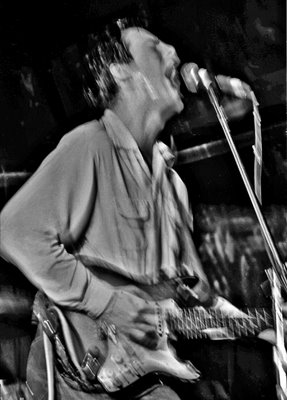
From the late 70s until the beginning of the 90s I worked with Les Wiseman in contributing photographs to his Vancouver Magazine rock column In One Ear. This was the era of the all powerful record label rep and we had to deal with them to get access to the likes of Joan Jet and The Police. While I photographed many concerts the bulk of the pictures that ended up with In One Ear where either back stage photographs or posed sessions with the musicians in their hotel rooms, usually right after Wisman's interview.
In those years I wrestled with the idea of taking original concert photographs. It soon became evident that no matter how much I tried my pictures looked liked everybody else's. If the other person did not have front stage access and I did, then my pictures were "good" only because they were so.
It was in the mid 80s that Wiseman and I traveled to New York City to try to get magazine work. I wrote about that here. We both called Rolling Stone for interviews. I talked to the art director. She asked me on the phone, "Do you have concert photographs?" I immediately answered, "No. I have back stage and hotel room photos." On the strength of my answer she gave me a coveted interview that went for naught as our only rocker of fame at the time was Red Rider. Rolling Stone was not interested in Red Rider. At Esquire Adam Moss told Wiseman, "You have a great portfolio. In Canada you have a prime minister called Joe Clark. We are not interested in him." And that was the end of our hopes for work in New York.
I never forgot my lesson about concert photographs and the difficulty of making them original. Through the years I have developed a style which is dependant on a one-on-one relationship in my studio with my subject. I like to be very close so I never used long focus lenses. This relationship is impossible at a concert.
Last night at the concert featuring Art Bergmann at Richards on Richards several persons either shouted into my ear (it was loud last night), "Where is your camera?" or they gesticulated with their hands to imitate the firing of a camera. I could not really explain and didn't.
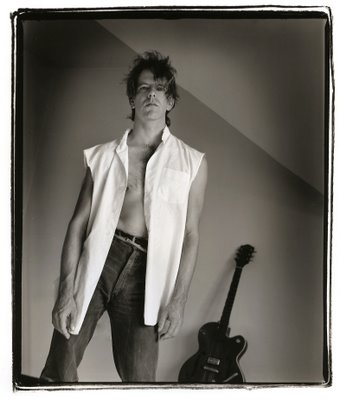
What you see above is a photograph of Art Bergmann, sometime in the 80s at Gary Taylor's Rock Room. I remember that the bass player was the Modernettes' Mary Jo Kopechne. I don't remember the circumstances as to why she was the bass player. In those days my attempt to rock concert originality was to use an extremely slow shutter and a flash at the same time. I believe that the noise and the excitement of a concert rarely is transfered on to a photographic image. The photo on the right is of Art Bergmann in the late 80s taken in my style.
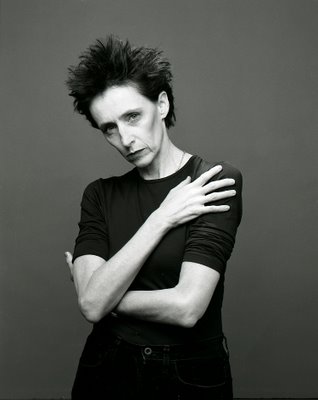 March 1, 1952, March 6, 2009
March 1, 1952, March 6, 2009
While reading today’s Vancouver Sun entertainment section Life I noticed what had to be a typo:
Discover Dance: Lola Dance
Scotiabank Dance Centre
Described as the late choreographer Lola MacLaughlin’s most stunning dance creation, Provincial Essays is…
“The late choreographer Lola Maclaughlin,”I said to myself. "That cannot be true.I never read about it." Since I never watch local TV news and my only source of local news is the Vancouver Sun or CBC Radio, when I am in the car, I had somehow missed this important tragedy in Vancouver's dance community.
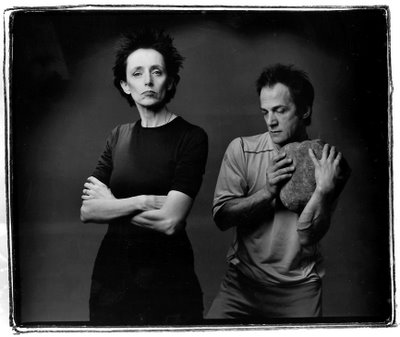
A former Vancouver Sun dance critic confirmed that the Vancouver Sun had run a paid obituary when Lola MacLaughlin died March 6 of ovarian cancer. A Vancouver Sun staffer confirmed this on the phone and had no explanation for the oversight. I checked the web and noticed that the Province ran a large obituary as did the Globe & Mail. Max Wyman wrote an obituary here/
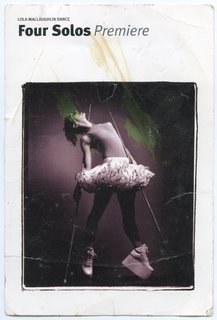
In 1998 I received a call from Lola Maclaughlin asking me if I could take the promotional pictures for her new dance, Four Solos. I explained to Maclaughlin that I knew how to take portraits but did not have a clue how to shoot dance. She was persuasive on the phone, "Alex I know you can do this and besides I will be there to help you." Four Solos involved four different cities in Europe. The dancers were Fiona MacDonald (Venice), Susan Elliott, Jennifer Murray and Hope Terry.
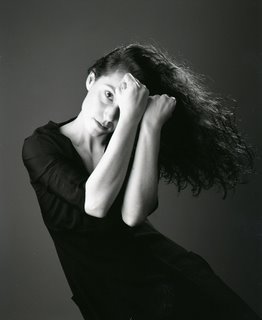


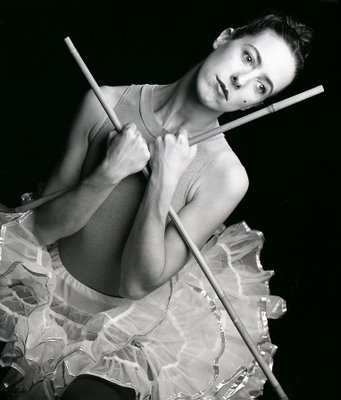
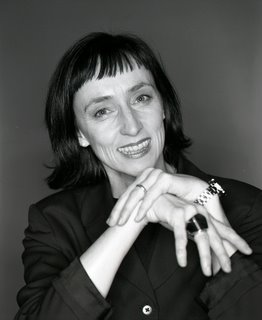 In my files I found one promo piece card, with Fiona Macdonald on it, that seemed to have been stepped on! It's all I have besides all those fine negatives that Lola Maclaughlin somehow knew I had in me to take. The picture of Maclaughlin with the male dancer is with Cornelius Fischer-Credo. I will miss Lola Maclaughlin and I feel ashamed. I am ashamed that our city newspaper missed giving her the tribute that she so deserved for her contribution to the cultural wellbeing of our existence.
In my files I found one promo piece card, with Fiona Macdonald on it, that seemed to have been stepped on! It's all I have besides all those fine negatives that Lola Maclaughlin somehow knew I had in me to take. The picture of Maclaughlin with the male dancer is with Cornelius Fischer-Credo. I will miss Lola Maclaughlin and I feel ashamed. I am ashamed that our city newspaper missed giving her the tribute that she so deserved for her contribution to the cultural wellbeing of our existence.
Addendum
I miss Lola so much. Thank you for your thoughts and words on the passing of my dear friend. I hope you can join us on April 6th at the Dance Centre, a celebration of her life 4:30-6:30pm.
The other dancers in the show were: Andrea Gunnlaugson: Vienna (replacing Fiona Macdonald,) Jen Murray as Berlin, myself as Brussels and Hope Terry as Venice.
all my best,
Susan

Dear friend now in the dusty clockless hours of the town when the streets lie black and steaming in the wake of the watertrucks and now when the drunks and the homeless have washed up in the lee of the walls in alleys or abandoned lots and cats go forth highshouldered and lean in the grim perimeters about, now in these sootblacked brick or cobbled corridors where the lightwire shadows make a gothic harp of cellar doors no soul shall walk save you.
Sutree, Cormac McCarthy, 1979
I reminded the man behind the trifocals facing my camera, that he had borrowed and read and, returned my entire Cormac McCarthy collection. The man behind the trifocals acknowledged this. "My fave," I told him, "was Sutree." "Mine, too," said the man behind the trifocals.
It was sometime shortly after the Berlin wall fell in 1989 when science fiction writer William Gibson was in a hotel in what had been West Berlin. He was going on a tour of East Berlin but could not get himself out of the room because of a book. Gibson was reading a most remarkable novel. He postponed his tour so he could finish it. When Gibson returned to Vancouver he gave me a call, "Alex I read this book in Berlin and...it's called Sutree. Read the first two and a half page preface. It is beautiful." Gibson was right.
I am not all that sure that the man behind the trifocals will be able to manage a guitar tomorrow night. He is in too much pain. Perhaps the excitement of being on stage with an electric guitar will give him the impetus to play and forget the pain. He might sing.
The voice is still unmistakable, the warmth is there. The thick trifocals cannot mitigate the penetrating intelligence. The man behind the trifocals has made me a social call. Can I be so lucky?
Perhaps some day when he is not feeling too well (worse than he was feeling today) I will suggest:
Maybe later
we'll get together
learn how to relax
maybe later
we'll get together
and have a relapse.
The Hospital Song, Art Bergmann
I think that would be lot's of fun.

From the late 70s until the beginning of the 90s I worked with Les Wiseman in contributing photographs to his Vancouver Magazine rock column In One Ear. This was the era of the all powerful record label rep and we had to deal with them to get access to the likes of Joan Jet and The Police. While I photographed many concerts the bulk of the pictures that ended up with In One Ear where either back stage photographs or posed sessions with the musicians in their hotel rooms, usually right after Wisman's interview.
In those years I wrestled with the idea of taking original concert photographs. It soon became evident that no matter how much I tried my pictures looked liked everybody else's. If the other person did not have front stage access and I did, then my pictures were "good" only because they were so.
It was in the mid 80s that Wiseman and I traveled to New York City to try to get magazine work. I wrote about that here. We both called Rolling Stone for interviews. I talked to the art director. She asked me on the phone, "Do you have concert photographs?" I immediately answered, "No. I have back stage and hotel room photos." On the strength of my answer she gave me a coveted interview that went for naught as our only rocker of fame at the time was Red Rider. Rolling Stone was not interested in Red Rider. At Esquire Adam Moss told Wiseman, "You have a great portfolio. In Canada you have a prime minister called Joe Clark. We are not interested in him." And that was the end of our hopes for work in New York.
I never forgot my lesson about concert photographs and the difficulty of making them original. Through the years I have developed a style which is dependant on a one-on-one relationship in my studio with my subject. I like to be very close so I never used long focus lenses. This relationship is impossible at a concert.
Last night at the concert featuring Art Bergmann at Richards on Richards several persons either shouted into my ear (it was loud last night), "Where is your camera?" or they gesticulated with their hands to imitate the firing of a camera. I could not really explain and didn't.

What you see above is a photograph of Art Bergmann, sometime in the 80s at Gary Taylor's Rock Room. I remember that the bass player was the Modernettes' Mary Jo Kopechne. I don't remember the circumstances as to why she was the bass player. In those days my attempt to rock concert originality was to use an extremely slow shutter and a flash at the same time. I believe that the noise and the excitement of a concert rarely is transfered on to a photographic image. The photo on the right is of Art Bergmann in the late 80s taken in my style.
Lola Maclaughlin Almost Made Me A Dance Photographer
Thursday, March 26, 2009
 March 1, 1952, March 6, 2009
March 1, 1952, March 6, 2009While reading today’s Vancouver Sun entertainment section Life I noticed what had to be a typo:
Discover Dance: Lola Dance
Scotiabank Dance Centre
Described as the late choreographer Lola MacLaughlin’s most stunning dance creation, Provincial Essays is…
“The late choreographer Lola Maclaughlin,”I said to myself. "That cannot be true.I never read about it." Since I never watch local TV news and my only source of local news is the Vancouver Sun or CBC Radio, when I am in the car, I had somehow missed this important tragedy in Vancouver's dance community.

A former Vancouver Sun dance critic confirmed that the Vancouver Sun had run a paid obituary when Lola MacLaughlin died March 6 of ovarian cancer. A Vancouver Sun staffer confirmed this on the phone and had no explanation for the oversight. I checked the web and noticed that the Province ran a large obituary as did the Globe & Mail. Max Wyman wrote an obituary here/

In 1998 I received a call from Lola Maclaughlin asking me if I could take the promotional pictures for her new dance, Four Solos. I explained to Maclaughlin that I knew how to take portraits but did not have a clue how to shoot dance. She was persuasive on the phone, "Alex I know you can do this and besides I will be there to help you." Four Solos involved four different cities in Europe. The dancers were Fiona MacDonald (Venice), Susan Elliott, Jennifer Murray and Hope Terry.




 In my files I found one promo piece card, with Fiona Macdonald on it, that seemed to have been stepped on! It's all I have besides all those fine negatives that Lola Maclaughlin somehow knew I had in me to take. The picture of Maclaughlin with the male dancer is with Cornelius Fischer-Credo. I will miss Lola Maclaughlin and I feel ashamed. I am ashamed that our city newspaper missed giving her the tribute that she so deserved for her contribution to the cultural wellbeing of our existence.
In my files I found one promo piece card, with Fiona Macdonald on it, that seemed to have been stepped on! It's all I have besides all those fine negatives that Lola Maclaughlin somehow knew I had in me to take. The picture of Maclaughlin with the male dancer is with Cornelius Fischer-Credo. I will miss Lola Maclaughlin and I feel ashamed. I am ashamed that our city newspaper missed giving her the tribute that she so deserved for her contribution to the cultural wellbeing of our existence.Addendum
I miss Lola so much. Thank you for your thoughts and words on the passing of my dear friend. I hope you can join us on April 6th at the Dance Centre, a celebration of her life 4:30-6:30pm.
The other dancers in the show were: Andrea Gunnlaugson: Vienna (replacing Fiona Macdonald,) Jen Murray as Berlin, myself as Brussels and Hope Terry as Venice.
all my best,
Susan
The Man Behind The Trifocals Pays Me A Social Call
Wednesday, March 25, 2009

Dear friend now in the dusty clockless hours of the town when the streets lie black and steaming in the wake of the watertrucks and now when the drunks and the homeless have washed up in the lee of the walls in alleys or abandoned lots and cats go forth highshouldered and lean in the grim perimeters about, now in these sootblacked brick or cobbled corridors where the lightwire shadows make a gothic harp of cellar doors no soul shall walk save you.
Sutree, Cormac McCarthy, 1979
I reminded the man behind the trifocals facing my camera, that he had borrowed and read and, returned my entire Cormac McCarthy collection. The man behind the trifocals acknowledged this. "My fave," I told him, "was Sutree." "Mine, too," said the man behind the trifocals.
It was sometime shortly after the Berlin wall fell in 1989 when science fiction writer William Gibson was in a hotel in what had been West Berlin. He was going on a tour of East Berlin but could not get himself out of the room because of a book. Gibson was reading a most remarkable novel. He postponed his tour so he could finish it. When Gibson returned to Vancouver he gave me a call, "Alex I read this book in Berlin and...it's called Sutree. Read the first two and a half page preface. It is beautiful." Gibson was right.
I am not all that sure that the man behind the trifocals will be able to manage a guitar tomorrow night. He is in too much pain. Perhaps the excitement of being on stage with an electric guitar will give him the impetus to play and forget the pain. He might sing.
The voice is still unmistakable, the warmth is there. The thick trifocals cannot mitigate the penetrating intelligence. The man behind the trifocals has made me a social call. Can I be so lucky?
Perhaps some day when he is not feeling too well (worse than he was feeling today) I will suggest:
Maybe later
we'll get together
learn how to relax
maybe later
we'll get together
and have a relapse.
The Hospital Song, Art Bergmann
I think that would be lot's of fun.
Tuesday, March 24, 2009

In preparation to taking pictures of Art Bergman and his wife Sheri in my studio tomorrow morning I have been looking at my extremely thick files on Bergmann. In an envelope marked Art Bergmann at home (no date) I found these. There are also pictures of Art and Sheri in bed that are as beautiful. I thought to myself, "What can I possibly write about them?" I thought of one of my most favourite jazz records of all time, Gerry Mulligan's 1959 What Is There To Say? (with Art Farmer on trumpet, Bill Crow on bass and Dave Bailey on drums) The beautiful song that starts this record, What is there to say? is credited to Jarburg, Duke and it was recorded in New York City January 15, 1959. I cannot possibly write anything about this photograph except to say how lucky I was.
Gerry Mulligan's liner notes:
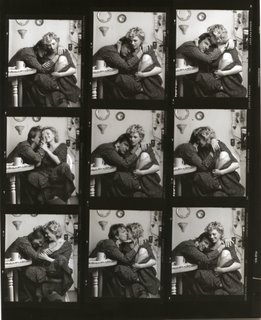
What is there to say? Actually, there's no need to say very much on cover notes beyond the names of the songs and the players. (I like to see the dates of the recordings also, myself.). But I notice a lot of jazz albums these days (some of my own included) whose notes go pretty far afield, with hardly a mention about what's inside (sometimes no mention at all).
I will now go far afield.
Jazz music is fun to me. All music can be fun for that matter, but what I mean is we usually have a hell of a good time playing and listening to each other.
But some of the people who do the most talking about jazz (that may even be the basic problem, right there!) don't seem to get any real fun out of listening to it. It seems to me that all the super-intellectualizing on the technics of jazz and the lack of response to the emotion and meaning of jazz is spoiling the fun for listeners and players alike.
So if the critics haven't got everyone scared with a lot of high-flown technical talk and Jack Kerouac hasn't got everyone impressed with the beauties of numbness and hipness for hipness' sake, maybe we could launch a little enthusiasm and restore fun to its rightful place in jazz.
Now, inside this jacket is a record (or should be!) into which we (meaning the Quartet and the people from Columbia) put a great deal of work to make as good an album as we could. And at the risk of sounding indecent, I'd like to say we all had a lot of fun making it.

Now we just hope you have a share in our fun.

In preparation to taking pictures of Art Bergman and his wife Sheri in my studio tomorrow morning I have been looking at my extremely thick files on Bergmann. In an envelope marked Art Bergmann at home (no date) I found these. There are also pictures of Art and Sheri in bed that are as beautiful. I thought to myself, "What can I possibly write about them?" I thought of one of my most favourite jazz records of all time, Gerry Mulligan's 1959 What Is There To Say? (with Art Farmer on trumpet, Bill Crow on bass and Dave Bailey on drums) The beautiful song that starts this record, What is there to say? is credited to Jarburg, Duke and it was recorded in New York City January 15, 1959. I cannot possibly write anything about this photograph except to say how lucky I was.
Gerry Mulligan's liner notes:

What is there to say? Actually, there's no need to say very much on cover notes beyond the names of the songs and the players. (I like to see the dates of the recordings also, myself.). But I notice a lot of jazz albums these days (some of my own included) whose notes go pretty far afield, with hardly a mention about what's inside (sometimes no mention at all).
I will now go far afield.
Jazz music is fun to me. All music can be fun for that matter, but what I mean is we usually have a hell of a good time playing and listening to each other.
But some of the people who do the most talking about jazz (that may even be the basic problem, right there!) don't seem to get any real fun out of listening to it. It seems to me that all the super-intellectualizing on the technics of jazz and the lack of response to the emotion and meaning of jazz is spoiling the fun for listeners and players alike.
So if the critics haven't got everyone scared with a lot of high-flown technical talk and Jack Kerouac hasn't got everyone impressed with the beauties of numbness and hipness for hipness' sake, maybe we could launch a little enthusiasm and restore fun to its rightful place in jazz.
Now, inside this jacket is a record (or should be!) into which we (meaning the Quartet and the people from Columbia) put a great deal of work to make as good an album as we could. And at the risk of sounding indecent, I'd like to say we all had a lot of fun making it.

Now we just hope you have a share in our fun.
Monday, March 23, 2009
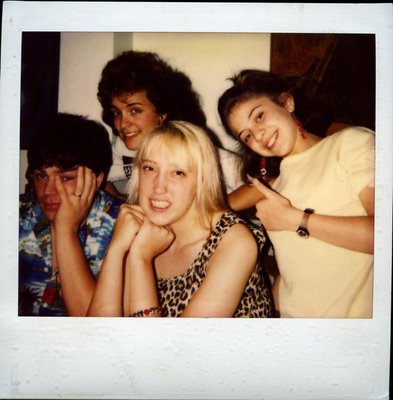
Polaroids have been on my mind of late. I wrote about Polaroids here and today I had one more reason to think about them.
I was telling Rebecca about my excitement of being able to see Art Bergmann perform (in spite of the fact that he has not played his guitar in over 5 years because of terrible arthritis) this Thursday at Richards on Richards. I further explained to her that I had photographed Art many times through the years (at least 20) and that Art was going to pose for me in my studio on Wednesday.
I brought Rebecca to the computer and I played Hawaii. This version of the quintessential (and in my opinion the only Vancouver song) tune by Art Bergmann and performed by his band of 1979, The Young Canadians, is so much fun in so many ways. One of them has a direct connection to Rebecca. The beautiful go-go girl with the lovely legs in the video, is Modernettes' bassist Mary Jo Kopechne. To the left of my computer is a book case. From it I retrieved a Polaroid taken so many years ago. In it from left to right is Buck Cherry (John Armstrong) my daughter Ale, Mary Jo and to the right Rebecca's mother, Hilary who is my younger daughter. I had invited Buck and Mary for dinner one day and I took this Polaroid.
Art Bergmann's concert
Killer version of Hawaii

While watching John Boorman’s 1987 film Hope and Glory Sarah Miles as Grace, and her three sisters Faith, Hope and Charity play a string quartet. They entertain themselves and their family during the waning days of the London Blitz on a house on the Thames. Rebecca said to me, “They had to entertain themselves because they had no TV.”
As a little boy my parents used to take me to visit relatives. I remember one visit in particular because of the smells. We went to visit my father’s older brother Harry and his wife Winnie at their home in Acassuso in the outskirts of Buenos Aires. Uncle Harry drank a lot and he always smelled of whisky and tobacco. It was the Hayward smell. From my vantage point by the kitchen table (I remember really looking up so I must have been 8) I watched Uncle Harry prepare some Colman mustard from scratch. I remember my surprise at watching him put a spoonful of sugar into his mixture. “How odd, “I thought. After dinner Auntie Winnie served us tea in beautiful bone china and I noticed her twisted arthritic hands.
These visits were not as frequent as those where my relatives came to our house. This was so because we had a garden. Uncle Tony, his son Wenci and my Tía Sarita would come on Saturdays and Uncle Tony would bring his U-control airplanes that he would fly in the nearby GE Field. One weekend it might be a beautiful Curtiss P-40 with the shark face on the engine cowling, and a beautiful sky blue under body paint with the standard camouflage on the top. On another week it was Focke-Wulf FW 190 but my favourite was a big, black, Stuka Ju87. Uncle Tony once built it with an authentic bent wing instead of the usual U-control straight wing. The Stuka was so un-maneuverable that it soon crashed. Uncle Tony poured the engine fuel over the wreckage and ritually burn it. We would go home for lunch and he would tell us, with a smile on his face, that he would build and even more beautiful Stuka. Uncle Tony also had the habit of dumping his pets (he lived in an apartment) on us. That is how we inherited over the years a Collie, a giant brown poodle, many turtles and assorted cats.
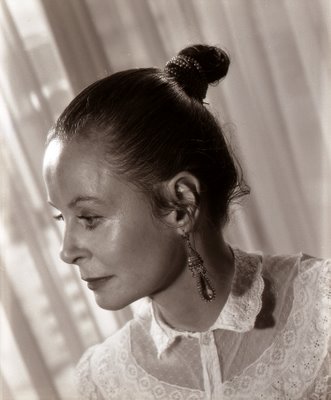
I remember those days fondly as I was growing up. Uncle Tony had taught me that things were things and no matter how valuable they could always be replaced if lost. Somehow Uncle Harry had challenged my idea that salty was salty and sweet was sweet and they could never convivir.
Today was such a day. It was sunny and I was able to garden. In spite of so many dead roses and shrubs I shrugged it off as my Uncle Tony would have. Rebecca arrived for her piano lesson at noon and Lauren accompanied me in the garden as I sprinkled alfalfa meal and Epsom salts on my roses. When Lauren asked me why I told her, “Plants eat just like we do and the Epsom salts will help them eat better. The alfalfa will (and we don’t know exactly why) induce the roses, even the dead ones, perhaps, to send up new growth.”
For lunch we had angel hair pasta the way Rebecca likes it. I chop up half an onion, a put in a cup of frozen peas over the angel hair. Lauren helps to grate the Parmesan. This time we pleased Lauren and instead of having a fresh fruit shake we had ginger ale with grenadine.
After lunch I went to Videomatica to choose a film for the afternoon. I go straight to the British movie section. It is here where I always find something good. I find something that will entertain the children without boring us. I find something with special effects, violence and destruction. Of the latter today’s film had lots of it as it was John Boorman’s Hope and Glory. This is an autobiographical film he wrote, produced and directed. It is a perfect Sunday afternoon movie to watch with one’s grandchildren. We all laughed when the little boy’s father teaches the boy to bowl a googly (In cricket a googly, is a type of delivery bowled by a right-arm leg spin bowler.)
We had not finished the film when Rebecca and Lauren’s parents arrived. I had prepared a pork loin on the barbecue, saffron rice and Rosemary had taken care of the mixed salad. We drank a blender mix of papaya, mango and orange and for dessert we had cherry Jell-O with canned peaches (Lauren’s favourite and Island Farms Chocolate Mint Burst ice-cream (my favourite).
The only thing that marred the perfect day was that I forgot to spoon some sugar into my Colman’s mustard. It was odd to see myself in the moody grandfather of the film played by Ian Bannen and my visiting relatives as the ones in whom my plans for the day will become someday their fond (I hope) memories.
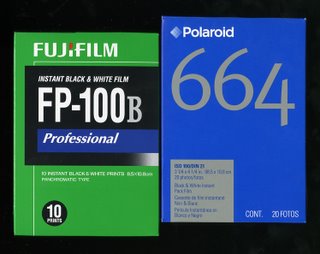
I recall a sunny day in Santa Fe, N.M.[1944], when my little daughter [Jennifer, 3] asked why she could not see at once the picture I had just taken of her. As I walked around the charming town I undertook the task of solving the puzzle she had set me. Within an hour, the camera, the film and the physical chemistry became so clear to me.
Edwin Herbert Land
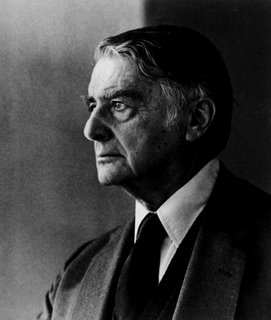
When I look at pictures of Edwin Land he is to me the personification of the brilliant inventor who had a soft spot for the desires of a child. This picture was taken by art photographer Naomi Savage who was a model for Man Ray.
That excitement that I first felt when I bought my Poloroid Land SX-70 in the middle 70s and the further delight of buying a Polaroid back for my Mamiya RB-67 in the 80s is a thrill that has not been matched by the purchase of any other photographic equipment since. And more so now. I have been lent a Canon EOS 20D digital single lens reflex camera of a month. I stare at it and feel frustrated that I cannot seem to be able to set the shutter speed and f-stops to my liking without reading the thick manual I will have to download from the web. All the other camera features are mostly useless to me. The camera is innert like a rare gas. It does not affect me emotionally. I feel distanced to it.
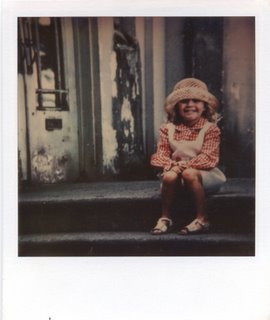
But I do understand now that the little LCD screen on the back of the camera that shows the "just taken" image may one day have to replace the Polaroid I have used all these years. My Polaroids have helped me make my subjects relax while assuring me that my camera and studio lights are all working in unison and correctly. The box you see here is the last from my supply. The film is now discontinued and I will replace it with the Fuji version.

I always smiled when I read in my National Geographic how some explorer/writer in the middle of head-hunting tribe in darkest Borneo would save himself from the pot by handing over a Polaroid. Would it be the same to show the back of your camera? Can you keep that image? Of course Polaroid is marketing a digital camera that does just that. It will print a little picture from a built-in printer.
Until the advent of the digital camera one of the biggest users of Polaroid cameras and film where the continuity people in movies. They would photograph the set and the costumes of the actors at the end of the day so they would not make mistakes on the next. Those Polaroids were then stuck in the actors' trailers or in the makeup booths. For years I have been giving away my Polaroids telling my subjects to put them up on their fridge.
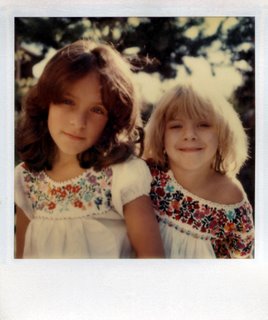
It seemed appropriate that my subjects after posing for me would somehow take something of me with them home. Not all their soul was left as a latent image on my film. It felt good. Alas, Polaroid is no more! Will I now call them Fujiroids or stick to Edwin Land's memory and vision and call them Polaroids?
These are SX-70 Polaroids that I took between 1975 and 1977. The first is Hilary at the door of an old school on Cambie that was demolished soon after. That's Rosemary at the Space Needle in Seattle in 1975 and Ale and Hilary pose in their Mexican tops outside our house in Burnaby in the late 70s. That's me taken with a Polaroid back on my Mamiya. I don't recall the date nor who pressed the shutter.

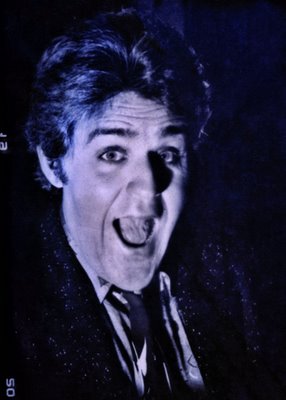
Rosemary not working any more in combination with a Toshiba laptop that she uses in bed has made her a different person (much more fun) from the one that I have known for the last 41 years.
Around 11:15 last night she told me from upstairs, “I want to watch Obama on that show. Is it called the Tonight Show? When does it start?” Neither Rosemary nor I have ever seen Jay Leno (the closest I ever go to Leno was in this picture I took of him in 1987 backstage at the Queen Elizabeth Theatre). And I do believe neither of us ever saw the Johnny Carson Show. Since we arrived in Canada in 1975 I never ever saw The Beachcombers. But I will proudly admit watching Gilligan’s Island with my two daughters. And prior to 1975 I was addicted to La Odisea del Espacio (Star Treck) in Mexico City.
Because of our TV illiteracy we never keep the TV magazine that comes with our Vancouver Sun. I told Rosemary to look up the Tonight Show on Google. We found the schedule. Our next problem was to figure out which Seattle TV channel on our box was NBC. With some back and forth flicking of the remote we did prevail and Rosemary got her wish.
If you have never seen a late night TV show, most of the concept is alien. It was for us. I particularly noticed Leno’s tacky desk and plants. The only class in the joint was the President himself.
But now both Rosemary and I can claim true passage into the 21st century. But perhaps not quite, “Alex what do they mean by network television?” she asked me. I did not consider her question all that relevant to our times so I gave her a perfunctory answer.
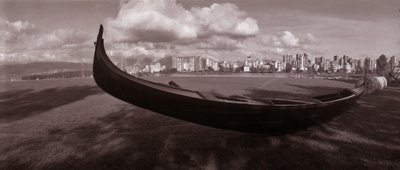
Venice has been painted and described many thousands of times, and of all the cities of the world it is the easiest to visit without going there.
Italian Hours, Henry James
‘I'm starving,’ she said. ‘I’ll put the pasta water on.’
Zen followed her out to the kitchen. On the table a stoppered litre bottle of red wine, a packet of spaghetti, a fat clove of purple-skinned garlic, a small jar of oil which was the opaque green of bottle glass abraded by the sea, and a twist of paper containing three wrinkled chillis the colour of dried blood.
‘Aglio, olio e peperoncino,’ he said.
‘I told you it was nothing fancy.’
Dead Lagoon, Michael Dibdin
Rosemary and I sat in the den for lunch yesterday. I had made a gruyere, ham and fresh tomato omelette. Rosemary turned on the TV. My large plate felt hot on my lap. We will not admit to the realization that we sometimes watch TV while eating and we will not acknowledge this culinary aberration by resorting to a TV dinner tray. On CNN I saw that picture of Natasha Richardson and her husband Liam Neeson. It seems it’s the only image the media could rustle up in our age of the all-knowing and all seeing image bank, Getty or Corbis. I got up.
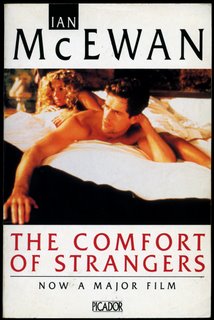
I went to a corner in the den where I had piled some books in a recent rearranging of my library. It was a pile of softcover books. From the pile I retrieved Ian McEwan’s second novel (1982) The Comfort of Strangers and I showed it to Rosemary. “Here is the Natasha Richardson they are talking about.” I had also seen this great little movie. The novel does not ever state nor confirm the reader’s suspicion that the novel is set in Venice.

For Mary the hard mattress, the unaccustomed heat, the barely explored city were combining to set loose in her a turmoil of noisy, argumentative dreams which, she complained, numbed her waking hours; and the fine old churches, the altar-pieces, the stone bridges over the canals, fell dully on her retina, as on a distant screen.
The film directed by Paul Schrader is firmly set in Venice. The only other film on Venice with the same pull on my memory, as good, scary and strange as Schrader's was Nicholas Roeg’s Don’t Look Now. The film was based on a Daphne du Maurier story, and cast Julie Christie and Donald Sutherland. The Comfort Of Strangers boasted an unusually excellent cast, Natasha Richardson, Rupert Everrett, Christopher Walken and Helen Mirren. Harold Pinter’s screenplay is the creamy icing on the cake.

In McEwan's 1990 novel The Innocent a man cuts up a body and quietly and calmly fits it into a suitcase. The almost unemotional McEwan style forces me to read his books in one sitting but not often. They are so cold and uninviting. The Comfort of Strangers is such a film. It is a film you can only see once even if you never forget it. In spite of the colourful Venice it is cold and gothic. But not as scary as the novella of the same name:

While they were out, and not only in the mornings, a maid came and tidied the beds, or removed the sheets, if she thought that was necessary. Unused to hotel life, they were inhibited by this intimacy with a stranger they rarely saw. The maid took away used paper tissues, she lined up their shoes in the cupboard in a tidy row, she folded their dirty clothes into a neat pile on a chair and arranged loose change into little stacks along the bedside table.

Rapidly, however, they came to depend on her and grew lazy with their possessions. They became incapable of looking after one another, incapable in this heat, of plumping their own pillows, or of bending down to retrieve a dropped towel. At the same time they had become less tolerant of disorder. One late morning they returned to their room to find it as they had left it, simply uninhabitable, and they had no choice but to go out again and wait until it had been dealt with.
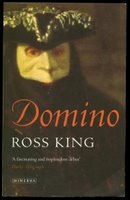
Near the end of the novella McEwan writes:
‘Very well,’ Robert said and reached Colin’s arm, and turned his palms upward. ‘See how easy,’ he said, perhaps to himself, as he drew the razor lightly, almost, playfully, across Colin’s wrist, opening wide the artery. His armed jerked forward, and the rope he cast, orange in this light, fell short of Mary’s lap by several inches.
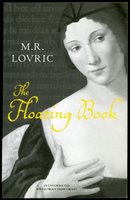
After I saw the film, Natasha Richardson was indelibly engraved in my brain as Mary in The Comfort of Stranger’s Colin and Mary and with two other films featuring pairs, Peter Yates’ 1969, John and Mary (Dustin Hoffman and Mia Farrow) and Frank Perry’s 1962 David and Lisa with Keir Dullea and Janet Margolin.
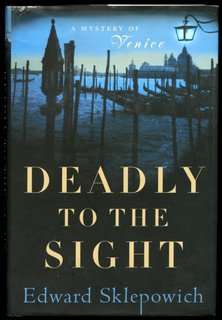
On further thought of the death of Natasha Richardson I scoured my library and found quite a few books on Venice. There are many more than I show here as I have all of Donna Leon’s Commisario Brunetti, all eight of them.
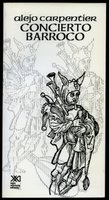
It was not too long ago that I decided to read a pocket book I used to prop up a bookcase. The cover was so terrible I decided the book was not worth reading. I can report that if I were to read it again perhaps my melancholy over the death of Mary (Natasha Richardson) might be dispelled just a bit.
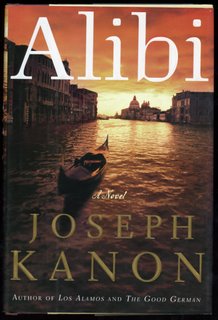
But that will not happen. I will probably re read the best Venice novel in my library, Michael Dibdin's Aurelio Zen police procedural, Dead Lagoon. Set in a freezing Venetian winter it is gloomy and depressing. I can feel the decay of Aurelio Zen's city of birth in shivers during every reading. I have begun to understand that Henry James was correct. On the other hand I will have to correct my oversight in not having yet read Thomas Mann's Death in Venice.
And no Natasha Richardson did not die in Venice. It was in Manhattan but my memory of her will always live and die in Venice.
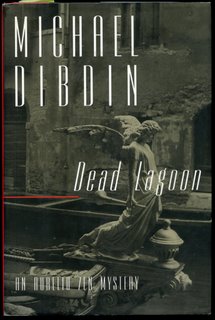

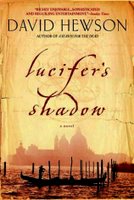
 Long may thy worthiness thy name advance
Long may thy worthiness thy name advance
Amongst the virtuous and deserving most,
Who herein hast forever happy proved:
In life thou lived'st, in death thou died'st beloved.
A Funeral Elegy for Master William Peter, William Shakespeare
If you don't garden you probably don't understand the concept of a perennial. These plants come back year after year. Some don't need proper care, others do. But with just a bit of garden knowledge perennials can return year after year. Hostas in particular are long-lived perennials and can please you for half a century. What is important to hardy perennials is that they get a winter rest. There are several types of hardy perennials. Some can thrive in Vancouver but die in Edmonton and Winnipeg. Perennials are given hardiness ratings so that those growing them in different areas of Canada will not suffer too many dissapointments. Perennials like humans need a period of rest to recoup energy. Hostas will not grow in Florida because they need a winter dormancy period. Smart Floridians still manage to grow hostas by popping their plants into the fridge for a couple of months. The cold signals the plants to go to dormancy.
Roses are shrubs or small trees and they follow, in most cases the, practice of dormancy. Roses in Vancouver will welcome cold Christmas and January weather as they sleep in preparation for a spring jump into botanical awareness. But if the weather should warm up in February the rose bushes will shift out of dormancy. This is what they did this year and then with our subsequent cold weather and snow roses were caught when they least expected it. I must report lots of dead or dying roses in my garden. The telltale sign is a cane top with lots of pink buds but as you look down the canes you notice the browning. As the canes die the buds whither. If there are no other healthy canes then the rose has gone to its maker. There are some possible (slime) Lazarus situations where come spring the "dead" rose will send up some new canes. I can only hope this will happen. I will help induce the moribund bushes by watering (as soon as it gets a bit warmer) the roses with a mixture of water and alfalfa meal. Alfalfa meals seem to jolt roses into action. My hard to grow but ever so beautiful Rosa 'Baron Girod De'Lain' had one remaining cane over the fall. It is dead. There are perhaps five or six more roses but the one whose death breaks my heart is Rosa 'William Shakespeare'. It wasn't an easy rose and it never really did all that well. But for years Rebecca has been growing up to enjoying in the garden with its deep crimson blooms that are extremely scented. The blooms themselves fade into glorious purples. It will be difficult to replace it as the rose was de-listed by David Austin and he launched an "improved" Rosa 'William Shakespeare 2000'. I will have to ask Rebecca if we should buy it or just glory in the memory of William Shakespeare, a plain William Shakespeare.
William Shakespeare
William Shakespeare again
 But the man who comes back through the Door in the Wall will never be quite the same as the man who went out. He will be wiser but less cocksure, happier but less self-satisfied, humbler in acknowledging his ignorance yet better equipped to understand the relationship of words to things, of systematic reasoning to the unfathomable Mystery which it tries, forever, vainly, to comprehend.
But the man who comes back through the Door in the Wall will never be quite the same as the man who went out. He will be wiser but less cocksure, happier but less self-satisfied, humbler in acknowledging his ignorance yet better equipped to understand the relationship of words to things, of systematic reasoning to the unfathomable Mystery which it tries, forever, vainly, to comprehend.
The Doors of Perception, Aldous Huxeley
La cucaracha, la cucaracha,
Ya no quieres caminar,
Porque no tienes,
Porque le falta,
Marihuana que fumar.
La Cucaracha
I have spent most of my life avoiding or turning down people who want to get me high, drunk or both. We all know that there is nothing worse than to tell a nervous person, "Why don't you learn to relax?" People have come up to me at parties and whispered in my ear, "Alex, just let go and you will see how much fun it is."
In the mid 80s Gary Taylor used to host battle of the bands contests at his Rock Room on Hornby. He invited me often to be one of the judges for a very good reason. I was a cheap judge. He kept me happy all night with free Perrier. The other judges indulged on hard liquor and white powders.
On my father's side of the family there has been an unusual incidence of alcoholism so I must have some built-in aversion to any addiction (except one I might as well confess right now, the German brand of fruit juice bears sold at London Drugs).
In my grade 11 at St. Ed's High School in Austin, my roommate, Maurice Badeaux went to town on a Saturday evening. I think we might have had a midnight curfew. While he was gone I decided to find out what it was like to get drunk and I emptied his bottle of bourbon. We were not supposed to have liquor in our rooms. When Badeaux returned I was oblivious to everything. He began to kick me, "How could you finish my personal bottle of Bourbon?" I felt no pain.
Sometime around 1982 another Maurice, Maurice Depas, lead singer of a Vancouver pop band, Maurice and the Clichés and I were on Wreck Beach soaking the sun in our birthday suits. "Alex I have this great hashish. You seem to be immune to all of the stuff. Give it a try." He put some in my beautiful Peterson Irish pipe (he ruined it forever) and lit it. After a few minutes he asked me to pass him the sun tan lotion. I realized I could not move. I was frozen solid. That was the first and last time I tried the stuff.
Some years before, my Yorkshire friend Andrew Taylor had purchased some peyote in a Mexico City herb market. We both had read Aldous Huxley's The Doors of Perception and Heaven And Hell. He came over to my house and persuaded me to try the stuff while he watched me with a stop watch. Nothing ever happened. Either I was immune to peyote or they had fooled him at the market.
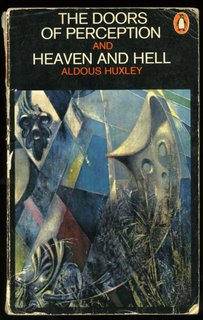
On another occasion at Gary Taylor’s Rock Room a large woman came up to me. I had never seen her before in my life. She said, “Alex open the palm of your right hand. She then dumped a pile of white powder on it and watched me. I did what I was supposed to do. She returned a few minutes later and asked, “And, how was it?” My answer must have confused her even though I thought it was most accurate, “I felt like I was walking up the stairs from the hot and stuffy Buenos Aires subway in the middle of the summer and suddenly I was hit by a rush of fresh air.”
While teaching high school in Mexico City around 1974 my students asked me what my opinion on taking drug was. I told them a couple of stories. In 1967 I had gone to visit my friend Robert Hijar in San Francisco. He lived in the then most fashionably high neighbourhood of Haight-Ashbury. I stayed for a couple of months. My hair was extremely long and I wore an Army Surplus jacket ( peace sign button on the lapel)seae with a sewn-up bullet hole that must have rendered its previous owner impotent. For laughs I once went to the park to try a Digger's stew. At the time I was feeling very Argentine so I drank a lot of mate from my gourd. The hippies who lived below one day asked me what it was. Most of the time they were high on some substance but this time they looked fine. “This is an Argentine tea called mate. Want to try some?” They answered, “Not a chance it seems to be habit forming since you always have that thing in your hand.”
The second story involved my attendance of a concert of the Jefferson Airplane. In a darkish corner during the concert I spotted a beautiful girl with a Joan Baez long, dark and straight hair. She was huddled in a corner staring at a little glass of what must have been crème de menthe. She seemed to be fascinated by the colour.
I further explained that when Rosemary and visited my mother in Veracruz we would drive through the semi-tropical city of Xalapa (home of jalapeño peppers). The landscape was a strange pristine green that was the greenest green I had ever seen. “It was an absolute green. It was a green that would define and prove Plato’s idea that everything we ever see with our senses is imperfect, a mere shadow of the world of essences. Xalapa was glimpse into this world. The girl at the concert was staring at what she perceived to be absolute green.”

But I knew that I had to give my class an answer or I was in trouble. I told them that there were two ways to enjoy a tomato. One was to buy a greenish pale tomato in the super market and take it home. Then with a salt shaker, and a touch of MSG the tomato would be surprisingly delicious. The other way was to go to the garden, pick a ripe tomato and give it a big bite. “Both tomatoes are delicious. My preference is for the garden variety.”
In Mexico marijuana, in Spanish it has two allowed spellings, mariguana or marihuana, there is still a more obvious differences between social classes than in Canada. One who smokes marijuana is called a marihuano or mariguano. It can be used as an insult and its meaning is but a notch up in class from a zombie of the cannibal-in-the-mall variety.
The woman in the portrait is Shelley Francis a.k.a. Sister Icee who in 1998 owned and ran the Cannabis Café on West Hastings. I photographed her for an article, August 20, by Anthony De Palma for the New York Times.
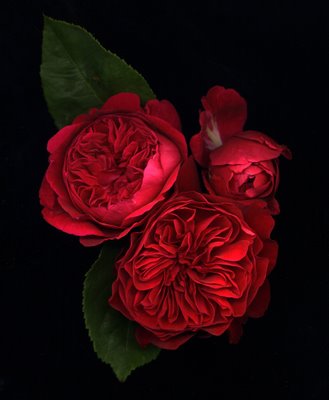
'She said that she would dance with me if I brought her red roses,' cried the young Student; 'but in all my garden there is no red rose.'
From her nest in the holm-oak tree the Nightingale heard him, and she looked out through the leaves, and wondered.
'No red rose in all my garden!' he cried, and his beautiful eyes filled with tears. 'Ah, on what little things does happiness depend! I have read all that the wise men have written, and all the secrets of philosophy are mine, yet for want of a red rose is my life made wretched.'
The Nightingale and the Rose
Oscar Wilde
'What a silly thing Love is,' said the Student as he walked away. 'It is not half as useful as Logic, for it does not prove anything, and it is always telling one of things that are not going to happen, and making one believe things that are not true. In fact, it is quite unpractical, and, as in this age to be practical is everything, I shall go back to Philosophy and study Metaphysics.'
So he returned to his room and pulled out a great dusty book, and began to read.
The Nightingale and the Rose
Oscar Wilde
The poor student in Oscar Wilde's story does manage to find a white rose with the help of the nightingale but to no avail as love does not triumph as the story finishes. The Nightingale and the Rose pits love versus philosphy and logic. In the end it would seem that philosophy and logic win.
In 1953 Texan born Charles L. Harness, a lawyer and patent attorney, wrote a famous science fiction novella, The Rose. It appeared first in Authentic Magazine in England but did not appear in book form until 1969 in the pocket book form I purchased in 1970. Both The Rose and Theodore Sturgeon's More Than Human (1953) were books of my youth that influenced me because part of being young is to be aware that one is walking potential and the future appears to be a blank and open book. Both novels explored the next step in man's potential, an evolution where the body stopped changing and it all shifted to the expansion of our mind. More Than Human was an easier read. The Rose was more complicated because Harness shifted Wilde's conflict between love and logic and philosophy to one between the arts and science. But I understood enough to understand with much excitement that some day soon we would have big huge heads containing brains like those aliens in This Island Earth. In youth I had some potential but I was naive, too!
One of the supporting characters in The Rose says: "‘I repeat,’ said Bell, ‘we are watching the germination of another Renaissance. The signs are unmistakable, and should be of great interest to practising sociologists and policemen.’" Charles L. Harness stresses the power of the opposition: not the scientists themselves, but the National Security/Governmental apparatus that hires them. He does not see science as a problem. The problem lies in that science is set up against the liberalism and individualism of art. Even though we must all be aware that you need some sort of education to appreciate art.

The message was lost to me in 1970. The Rose amazed me but I was left with little understanding as to why I had liked it. The nightingale is an ugly psychiatrist and ballerina and the student (no less ugly) represents art while being married to a scientist who is a beauty of perfection. The student and the ballerina manage to end (sort of) like a couple of ducklings turned swans.
Harness died in 2005 and I can only wonder what he would make of the new enemy of the arts as the world's economy declines and funding for the arts withers away. It was only some weeks ago that a member of my family said, "A liberal arts education is a waste of time now." Perhaps I shall place my copy of The Rose on a bedside table and see if that mind will change. After all youth is there and potential is at its fullest.
The red rose on the cover of my pocketbook is a Hybrid Tea. I do not have any red Hybrid Tea Roses in my garden. What you see here is the English Rose, Rosa 'L.D. Braithwaite'.
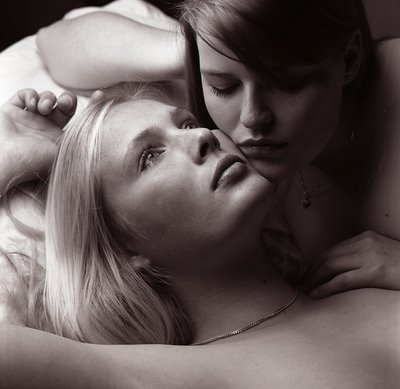
My liberal Catholic education allowed for Darwin's beliefs on where we came from. At the same time a reading of Teilhard de Chardin's The Phenomenon of Man gave me some glimpses on where me might be headed to.
At St. Ed's in Austin, Brother Edwin explained to us how a couple of apes at some point might have had that glimmer of thought which the Catholic Church would explain as a direct intervention of God. "I don't think those thinking apes would have been as pretty as the Adam and Eve portrayed in art." he explained to us. Brother Edwin’s explanation was no different from the one I had read in the books of Erich Fromm. I saw no conflict between the Church and Darwin. But Brother Edwin discussed another problem with us. He first went through the standard Aristotelian/Church progression from a rock to primitive cells and organisms, insects, birds, mammals, humans, angels and God. He explained that humans were a blend of body and spirit. That spirit was our soul. Angels were pure but imperfect spirits and God, then, was the pure and perfect spirit. Where we had a confusion and Brother Edwin left us (how intelligent he was) with it, was what kind of spirit a dog or ape would have. Could we call these spirits souls? We discussed what obvious traits made us different from animals. Brother Edwin told us that unlike animals (and I cannot now be sure of it) that we as Homo sapiens sapiens knew that we knew. We were aware of our being.
Since then humans have been defined as toolmakers and users of tools yet several animals including birds have been seen using primitive mechanical devices to open shells, etc. The difference between animals and humans has blurred even further. Soon the Vancouver Aquarium's sea otter and octopus will be considered so intelligent (they are) that nature lovers will force the aquarium to release them. The sea otters and the octopus will be the "new whale".
For the time being I live in the comfort that one difference between us and the "lower" orders is our ability to associate disparate things, events, memories and find links within them. It is far and beyond making a noise with a spoon and a tin of cat food to get the cats to come in. Our human ability to associate is far more elaborate. Or as my friend Les Wiseman reminded me only this week, "What can we do, where can we be transported to by dipping a madeleine into tea?"
Yesterday I Skyped Juan Manuel Sánchez in Buenos Aires. He told me that he was having radioactive tests (radioactive substances were being injected) to look for solutions to his health problems. Sanchez is 78. I made the comment that he probably glowed in the dark. I told him that I was going to nick-name him Polonio, Polonio Sánchez. The association is Borgesian and he caught on. Jorge Luís Borges had a great interest in a shadowy Argentine literary figure called Macedonio Fernández. Thus the association of Polonio Sanchez and Macedonio Fernández. Does this ability make us human?
Yesterday Rosemary and I watched a fine film My Summer of Love that features two young women of different backgrounds in Yorkshire who find each other. The two young girls become close and have a torrid affair (I don't think I will be seeing this film with Rebecca yet). I noted that wonderful closeness that they had which we men could not possibly achieve with our macho ideas of what is proper and what is not. I have had friends and have friends but there is always a sense of distance. I felt closeness to Juan Manuel Sanchez when he was in Vancouver. After a visit I would kiss him goodbye. We Argentine Latins can be a bit more expressive of our feelings in spite of our machismo.
The film made me re-live last Sunday in a different and far more glowing light. It all started last Saturday when the phone rang.
Rosemary passed me the phone and with a doubtful expression on her face told me, "They want pictures." The young woman on the phone had a thick German accent. "We want pictures," she asked. This kind of thing is not infrequent so I like to make sure the request is a serious one and that money will change hands (in my direction). The girl on the phone told me her name was Sina (that S was pronounced like a z) and that she and her friend Hanna had gone to Sears to enquire about having their pictures taken. They were told that Sears no longer had that service but the woman (a mystery to me as who she was) told them that there was someone who would. My name was mentioned. The two girls looked me up on the web and found me. They called. Sina told me that they lived in Agassiz but that they were in town for the weekend. "You mean you want me to take your pictures today or tomorrow?” Sina, said, "Yes." I mentioned to them that I was not cheap. I mentioned a sum and we agreed to meet at my studio the next morning at 11. I thought it all very strange.
Rosemary, who is often right, felt that this was either a joke or that the women were "Gypsies" who would rob me. To make matters worse that evening the clocks were going to change. Would the girls realize this? Would they show up on time?
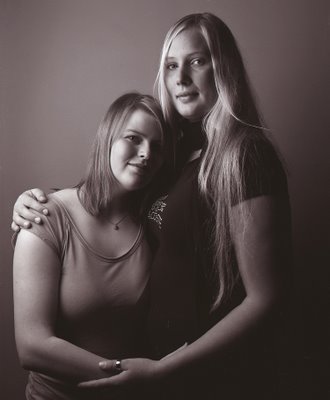
I arrived at the outside gate of my studio on Robson. It was 10:45. There were two women outside with bags. One of them had very blond straight hair down to her waist. She was well over 6 ft. I went up to them and told them, "You look German."
Up in the studio Sina (the tall one) told me that she was milk maid in an Agassiz dairy farm. She was here on an exchange program. Her friend Hanna was visiting from home, a small town in Schleswig-Holstein. Hanna was a chef's assistant. Both young girls were 20. "We want sexy pictures for our boyfriends."
I insisted in taking their pictures together first to celebrate their friendship. These pictures were easy to take. There was warmth between them that I was able to recognize yesterday while watching My Summer of Love. But I had to tell them exactly how to pose together. They soon warmed up to my instructions. We then took the sexy pictures for their boyfriends. I mentioned that the picture session must have arisen from some impulse that hit them while shopping in Sears. But both Hanna and Sina spoke a very limited English and they constantly chattered on in German. I had no idea what they were saying. I suspect they must have had fun.
With a few frames left in my camera Hanna suggested I photograph them together. Hanna looked at me while telling me this and then changed her mind. I insisted. It seems there was a level of discomfort. Perhaps she was thinking, "What will our boyfriends think of us?" I took two pictures of them together and they looked exactly like the two girls in the film we saw yesterday even if I wasn't to know that until yet.
But I did know last Sunday that I had captured something special- a bond between women, a bond that as a man, I can only but suspect of its wonders. Perhaps, those dogs, those birds and I have that flaw in common and women are that much more human.

I have lingered in Dubrovnik twice. The first time was in June 1985 (note the Yugoslavian visa in my Argentine passport) when Yugoslavia and Marshal Josip Broz Tito were indivisible. My journey to Yugoslavia was memorable before I even got there. Travel writer Garry Marchant had obtained a free trip for me on his fine literary coat tails. At the time he was the best travel writer in Canada.

I’m a collector. I collect countries.
I don’t just go to new places to add them to the list, though, despite accusations of some friends. I am genuinely interested in every country, curious about the most remote, unlikely places. I didn’t start out this way.
Garry Marchant
Marchant, by then, had traveled just about everywhere in the world and he was (rare in his profession) completely unglazed in the eyes. Every voyage was a trip into the unknown. Alex,” he told me, “do as I do and all will be well.” So by the time our Yugoslavian Airlines plane was queuing for take off during a busy Toronto Airport morning, we were drinking Champagne. Somewhere in between (on our way to Zagreb) I distinctly remember staring at a marvelous mural dedicated to Nikola Tesla in the partition bulkhead in front of me. My memory then slipped away. The alarm that woke me came in the form of the noise of our plane’s wheels and the subsequent brakes as we landed in Zagreb. In my right hand I had a glass of Champagne. Marchant had expertly taught me how to shorten long trips with inimitable class.
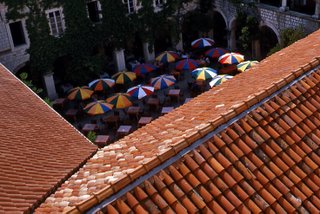
I’d discovered the gypsy in my genes,
the nomad in my soul. A few short
trips followed – to Mexico and the
Caribbean. When the chance came to
live in Japan, I abandoned university
forever and headed for the exotic East
– the long way.
Garry Marchant
Yugoslavia was a delight. I tried many versions of the great delicacy that is an uncooked ham that comes from the pig's neck. It varied in saltiness but it was always delicious. I ate it three-times a day while Marchant washed his down with slivovitz. At a restaurant in Split, it was a sidewalk evening affair with monstrously large peaked serviettes to mark our places, we sat down to enjoy the warm evening. Just as I was about to feast on ham, butter and bread, Marchant stood up suddenly and was gone like a light. He returned a half hour later with a grin on is face. “I spotted a young woman walking a Dalmatian. We are on the Dalmatian coast, aren’t we? ”
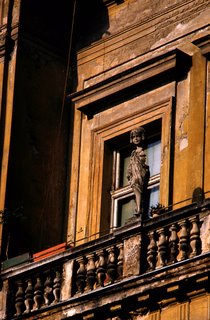
Although no longer a member, I
follow the criteria and the official list
of the California-based Travelers’ Cen-
tury Club (TCC), which requires that
applicants have visited 100 countries
to join. I do not count countries twice,
just because they change their name.
Haute Volta became Burkina Faso, but
I still only count it is as one country.
However, the former Czechoslovakia,
now the Czech Republic and Slovakia,
counts as two. That’s fair, as I’ve been
to both parts.
Garry Marchant
The rest of Yugoslavia was beautiful but there was almost no comparison to what awaited us in Croatia's port city of Dubrovnik, the old capital until 1918 of the city-state of Ragusa which for a while competed with Venice for fame, fortune and excellence in architecture.
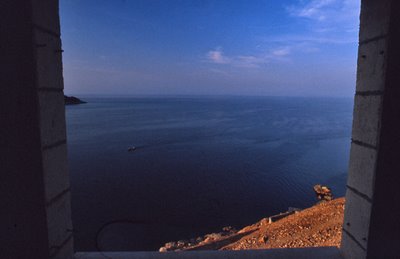
If I could only find and editor to take the story, I would love to visit Easter Island, to see those mysterious giant statues, faced resolutely inland. Although I’ve walked the dusty streets of such African towns as Ouagadougou and Bobo-Dialassou, I’ve yet to see Timbouktu – a major gap for a traveller. My collection includes a number of South Pacific Islands (Tonga,Samoa, Saipan,Tinian, Palau,Yap, Truk and many others),but I would gladly take the cruise from Tahiti to the Marquesas. It is a big, wonderful world out there, so many places, so many countries – 317 according to the TCC. Like all collectors, I want the full set.
Garry Marchant
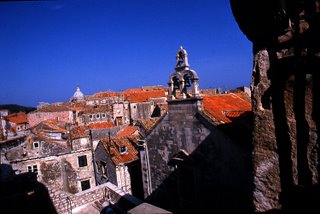
For a few years I felt disappointed that I never had the chance to photograph Karen Kain. Then I photographed Evelyn Hart and my disappointment faded. Unlike Rosemary I have never been in Venice. Every once in a while I have felt that Karen Kain loss. But then I remember that I have been in Toledo, Guanajuato and Dubrovnik. Those three beautiful cities are my geographical Evelyn Harts.
While in Dubrovnik, I sampled some startlingly white cherries, with some bread, butter and… in a nearby offshore island called Lokrum. There is the legend that when Richard the Lionhearted was returning from the crusades around 1192 his ship was almost wrecked there but was sheltered by the protective old Lokrum cove, Skalica. Thanking God for his survival he vowed to build a church in honour of the Virgin. According to old Dubrovnik chronicles, as soon as the people of Dubrovnik noticed the anchored ship, they sent a delegation, welcomed the king and brought him into the town. They honoured Richard with gifts and let him rest and recover. Coincidentally, at the same time, the Senate planned to erect a new church, so they succeeded in persuading the king to intend his votive present to the cathedral, and they would in return fulfill his vow by building the church on Lokrum. Afterwards, Richard sailed towards his destination on a Dubrovnik ship. We know he did not get to his destination and the rest, be it history or fantasy, (Robin Hood and Ivanhoe) is well known.
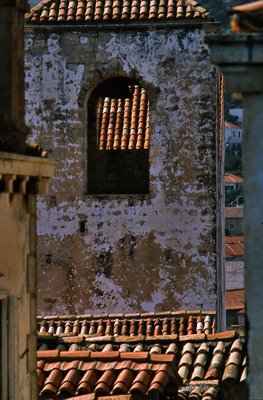
But it was the ash in an ashtray that really brought Lokrum into my heart that day. Our guide told us that Maximilian, Archduke of Austria, who became Emperor in Mexico, had lived and vacationed on the island. While he affirmed that the ash was from one of Maximilian’s cigars I doubted it but I was still overcome by how two far away places, Mexico and Dubrovnik (from my now native Vancouver) suddenly had a strange but beautiful bond. Our guide told us this story:

The Austrian ship Triton exploded in the Lokrum canal in 1859. There was but one survivor. He had been imprisoned in the war ship’s hold for some crime. The explosion expelled the man with remnants of the chain onto the shore, unharmed.. The Austrian Admiralty entrusted the investigation of the catastrophe to a commander of the imperial fleet - Maximilian. He fell in love with Lokrum, purchased it and started the wheel of fortune that led him to a firing squat on the Cerro de Las Campanas in Querétaro, Mexico, June 10, 1867. During his stay on Lokrum with his wife Carlota, the lovestruck Maximilian engraved a heart containing the first letters of his and Carlota’s name into a huge oak dating to the 14th century, located next to the palace he built for her. According to romantic legend, he thereby incurred hostility. It was a historical oak, under which the Dubrovnik Senate met frequently. A storm appeared before he returned to the shores of Lokrum. Lightning struck this oak tree and the engraved monograms disappeared, leaving only the heart. Before he faced his firing squad Carlota would plead to various European kings to intercede. They didn’t. Carlota slipped into insanity. Many suspect she never accepted her husband’s death.
For me what is most remarkable of this romantic tragedy is that Carlota lived on thinking she was the Empress of Mexico until 19 January 1927, modern times! To this day I marvel on how the ash of a cigar can transport us to places that are so unexpected and yet so historically logical but fantastic.
My second journey to Dubrovnik came Thursday night via four black gentlemen wearing white summer tuxedos in Freiberg, Germany.
A couple of years ago Rebecca had enjoyed dancing in our living room to the Prestige (7109) CD Bags Groove- Miles Davis with Sonny Rollins, Milt Jackson, Thelonius Monk, Horace Silver, Percy Heath and Kenny Clarke. I gently pushed some more jazz CDs in her direction and she genuinely developed a liking for Milt Jackson's Bags Groove in as many versions as I own. So for Christmas I gave her a DVD, The 35th Anniversary Tour - The Modern Jazz Quartet, John Lewis, piano, Milt Jackson, vibraphone, Percy Heath, bass and Connie Kay, drums. At dinner on Thursday night I noticed the DVD in a pile of film DVDs. I did not bother to ask her if she had ever seen it. I put it into my overcoat pocket and went home.
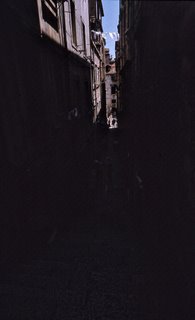
I watched the video. The concert includes many MJQ standards like Django and Rebecca's favourite Bags' Groove written by Milt Jackson. But it was the last number that floored me into Dubrovnik nostalgia. The quartet played an 18 minute long composition called A Day In Dubrovnik. I have a cassette tape version but it is a collaboration with The New York Chamber Symphony called Three Windows which many experts call an almost perfect melding of jazz and classical music. It is a beautiful tape. But it was nothing like this quartet version. All three movements Afternoon, Night and Morning (in that unusual order) are seamlessly joined.
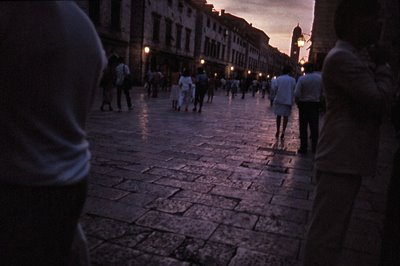
As John Lewis explained with a smile, the tourists arrive in their cruise ships in the afternoon, the city comes alive in the evening and by morning Dubrovnik is its busy normal self.
Dubrovnik, the first time.

Canada is so far away it hardly exists. Jorge Luis Borges
An architect friend of mine said to me last Saturday, “Guess where we are going to next week?” I couldn’t have possibly guessed knowing he and his partner go to places most exotic. So he said, “Bhutan.” Last year Rebecca, Lauren, Rosemary and I were dining at a delightful sea food restaurant in Qualicum called Fish Tales. At a table near us some elderly gentlemen and their wives were discussing a cruise ship vacation that took them to Peru and Machu Picchu. They were comparing notes. I suddenly felt sad knowing that if I ever got to Machu Picchu I would probably be their same age. Would I then be able to enjoy it? Or would I simply be doing Machu Picchu?
I have written here before that if I suddenly found myself in Venice for a few months I would soon feel nostalgic for Vancouver and I would go out in search of a lovely Canadian woman and convince her to pose for me undraped under an umbrella. I would feel nostalgia for Vancouver’s rain.
The concept of what is an exotic place is probably directly proportional to its distance from your place of origin. In the early 50s when I happened to go to the Buenos Aires airport at Ezeiza to receive a visiting relative I would stare with an unexplained longing at airplanes that had the logo of Canadian Pacific on their side. Now, that was exotic! Forget Bhutan! Forget the familiarity of a Cathay Pacific or Japan Airlines 747. Remote Canada was as exotic and far as any country could possibly be. I don’t think that idea of Canada's remoteness has ever gone away from me even though I now live here in Canada.
 "I don't even know what street Canada is on." Al Capone in 1931 when asked by a newspaper reporter if Canada was the main source of supply for his lucrative bootlegging empire.
"I don't even know what street Canada is on." Al Capone in 1931 when asked by a newspaper reporter if Canada was the main source of supply for his lucrative bootlegging empire.
Perhaps it is for that reason that after 35 years in Vancouver and in Canada I feel like a tourist, like an interloper. When I walk the streets of Vancouver and I look around I feel I am looking into a TV documentary on Canada. I used to tell my fine Argentine friend, Juan Manuel Sanchez, “You and I are penguins in the arctic.” He finally convinced himself that as a penguin he belonged in the Southern Hemisphere so he is back and living in his beloved Buenos Aires.
 "In Canada, for example, there are 2.6 persons per square mile; in other countries perhaps, 16, 18, 20 or 26 persons. Well, no matter how stupidly one manages one's affairs in such a country, a decent living would still be possible. " Adolf Hitler, 1940 in a speech in Berlin
"In Canada, for example, there are 2.6 persons per square mile; in other countries perhaps, 16, 18, 20 or 26 persons. Well, no matter how stupidly one manages one's affairs in such a country, a decent living would still be possible. " Adolf Hitler, 1940 in a speech in Berlin

Yesterday morning I walked to my bus stop on 41st and Granville to take an articulated B-Line to town. I was going to have lunch with friends Don Stewart (Macleod’s Books) and journalist and airplane enthusiast Sean Rossiter. It was cold and I was wearing my newish London Fog overcoat. As I was waiting for the bus I suddenly felt more than ever like that penguin. I looked at the cars and then at the cyan/blue sky over the North Shore mountains. It was all alien to me. I felt out of place, still a tourist in an exotic land.

Polaroids have been on my mind of late. I wrote about Polaroids here and today I had one more reason to think about them.
I was telling Rebecca about my excitement of being able to see Art Bergmann perform (in spite of the fact that he has not played his guitar in over 5 years because of terrible arthritis) this Thursday at Richards on Richards. I further explained to her that I had photographed Art many times through the years (at least 20) and that Art was going to pose for me in my studio on Wednesday.
I brought Rebecca to the computer and I played Hawaii. This version of the quintessential (and in my opinion the only Vancouver song) tune by Art Bergmann and performed by his band of 1979, The Young Canadians, is so much fun in so many ways. One of them has a direct connection to Rebecca. The beautiful go-go girl with the lovely legs in the video, is Modernettes' bassist Mary Jo Kopechne. To the left of my computer is a book case. From it I retrieved a Polaroid taken so many years ago. In it from left to right is Buck Cherry (John Armstrong) my daughter Ale, Mary Jo and to the right Rebecca's mother, Hilary who is my younger daughter. I had invited Buck and Mary for dinner one day and I took this Polaroid.
Art Bergmann's concert
Killer version of Hawaii
Hope And Glory On An Almost Perfect Sunday
Sunday, March 22, 2009

While watching John Boorman’s 1987 film Hope and Glory Sarah Miles as Grace, and her three sisters Faith, Hope and Charity play a string quartet. They entertain themselves and their family during the waning days of the London Blitz on a house on the Thames. Rebecca said to me, “They had to entertain themselves because they had no TV.”
As a little boy my parents used to take me to visit relatives. I remember one visit in particular because of the smells. We went to visit my father’s older brother Harry and his wife Winnie at their home in Acassuso in the outskirts of Buenos Aires. Uncle Harry drank a lot and he always smelled of whisky and tobacco. It was the Hayward smell. From my vantage point by the kitchen table (I remember really looking up so I must have been 8) I watched Uncle Harry prepare some Colman mustard from scratch. I remember my surprise at watching him put a spoonful of sugar into his mixture. “How odd, “I thought. After dinner Auntie Winnie served us tea in beautiful bone china and I noticed her twisted arthritic hands.
These visits were not as frequent as those where my relatives came to our house. This was so because we had a garden. Uncle Tony, his son Wenci and my Tía Sarita would come on Saturdays and Uncle Tony would bring his U-control airplanes that he would fly in the nearby GE Field. One weekend it might be a beautiful Curtiss P-40 with the shark face on the engine cowling, and a beautiful sky blue under body paint with the standard camouflage on the top. On another week it was Focke-Wulf FW 190 but my favourite was a big, black, Stuka Ju87. Uncle Tony once built it with an authentic bent wing instead of the usual U-control straight wing. The Stuka was so un-maneuverable that it soon crashed. Uncle Tony poured the engine fuel over the wreckage and ritually burn it. We would go home for lunch and he would tell us, with a smile on his face, that he would build and even more beautiful Stuka. Uncle Tony also had the habit of dumping his pets (he lived in an apartment) on us. That is how we inherited over the years a Collie, a giant brown poodle, many turtles and assorted cats.

I remember those days fondly as I was growing up. Uncle Tony had taught me that things were things and no matter how valuable they could always be replaced if lost. Somehow Uncle Harry had challenged my idea that salty was salty and sweet was sweet and they could never convivir.
Today was such a day. It was sunny and I was able to garden. In spite of so many dead roses and shrubs I shrugged it off as my Uncle Tony would have. Rebecca arrived for her piano lesson at noon and Lauren accompanied me in the garden as I sprinkled alfalfa meal and Epsom salts on my roses. When Lauren asked me why I told her, “Plants eat just like we do and the Epsom salts will help them eat better. The alfalfa will (and we don’t know exactly why) induce the roses, even the dead ones, perhaps, to send up new growth.”
For lunch we had angel hair pasta the way Rebecca likes it. I chop up half an onion, a put in a cup of frozen peas over the angel hair. Lauren helps to grate the Parmesan. This time we pleased Lauren and instead of having a fresh fruit shake we had ginger ale with grenadine.
After lunch I went to Videomatica to choose a film for the afternoon. I go straight to the British movie section. It is here where I always find something good. I find something that will entertain the children without boring us. I find something with special effects, violence and destruction. Of the latter today’s film had lots of it as it was John Boorman’s Hope and Glory. This is an autobiographical film he wrote, produced and directed. It is a perfect Sunday afternoon movie to watch with one’s grandchildren. We all laughed when the little boy’s father teaches the boy to bowl a googly (In cricket a googly, is a type of delivery bowled by a right-arm leg spin bowler.)
We had not finished the film when Rebecca and Lauren’s parents arrived. I had prepared a pork loin on the barbecue, saffron rice and Rosemary had taken care of the mixed salad. We drank a blender mix of papaya, mango and orange and for dessert we had cherry Jell-O with canned peaches (Lauren’s favourite and Island Farms Chocolate Mint Burst ice-cream (my favourite).
The only thing that marred the perfect day was that I forgot to spoon some sugar into my Colman’s mustard. It was odd to see myself in the moody grandfather of the film played by Ian Bannen and my visiting relatives as the ones in whom my plans for the day will become someday their fond (I hope) memories.
A Polaroid On My Fridge
Saturday, March 21, 2009

I recall a sunny day in Santa Fe, N.M.[1944], when my little daughter [Jennifer, 3] asked why she could not see at once the picture I had just taken of her. As I walked around the charming town I undertook the task of solving the puzzle she had set me. Within an hour, the camera, the film and the physical chemistry became so clear to me.
Edwin Herbert Land

When I look at pictures of Edwin Land he is to me the personification of the brilliant inventor who had a soft spot for the desires of a child. This picture was taken by art photographer Naomi Savage who was a model for Man Ray.
That excitement that I first felt when I bought my Poloroid Land SX-70 in the middle 70s and the further delight of buying a Polaroid back for my Mamiya RB-67 in the 80s is a thrill that has not been matched by the purchase of any other photographic equipment since. And more so now. I have been lent a Canon EOS 20D digital single lens reflex camera of a month. I stare at it and feel frustrated that I cannot seem to be able to set the shutter speed and f-stops to my liking without reading the thick manual I will have to download from the web. All the other camera features are mostly useless to me. The camera is innert like a rare gas. It does not affect me emotionally. I feel distanced to it.

But I do understand now that the little LCD screen on the back of the camera that shows the "just taken" image may one day have to replace the Polaroid I have used all these years. My Polaroids have helped me make my subjects relax while assuring me that my camera and studio lights are all working in unison and correctly. The box you see here is the last from my supply. The film is now discontinued and I will replace it with the Fuji version.

I always smiled when I read in my National Geographic how some explorer/writer in the middle of head-hunting tribe in darkest Borneo would save himself from the pot by handing over a Polaroid. Would it be the same to show the back of your camera? Can you keep that image? Of course Polaroid is marketing a digital camera that does just that. It will print a little picture from a built-in printer.
Until the advent of the digital camera one of the biggest users of Polaroid cameras and film where the continuity people in movies. They would photograph the set and the costumes of the actors at the end of the day so they would not make mistakes on the next. Those Polaroids were then stuck in the actors' trailers or in the makeup booths. For years I have been giving away my Polaroids telling my subjects to put them up on their fridge.

It seemed appropriate that my subjects after posing for me would somehow take something of me with them home. Not all their soul was left as a latent image on my film. It felt good. Alas, Polaroid is no more! Will I now call them Fujiroids or stick to Edwin Land's memory and vision and call them Polaroids?
These are SX-70 Polaroids that I took between 1975 and 1977. The first is Hilary at the door of an old school on Cambie that was demolished soon after. That's Rosemary at the Space Needle in Seattle in 1975 and Ale and Hilary pose in their Mexican tops outside our house in Burnaby in the late 70s. That's me taken with a Polaroid back on my Mamiya. I don't recall the date nor who pressed the shutter.

Jay Leno & Gilligan's Island
Friday, March 20, 2009

Rosemary not working any more in combination with a Toshiba laptop that she uses in bed has made her a different person (much more fun) from the one that I have known for the last 41 years.
Around 11:15 last night she told me from upstairs, “I want to watch Obama on that show. Is it called the Tonight Show? When does it start?” Neither Rosemary nor I have ever seen Jay Leno (the closest I ever go to Leno was in this picture I took of him in 1987 backstage at the Queen Elizabeth Theatre). And I do believe neither of us ever saw the Johnny Carson Show. Since we arrived in Canada in 1975 I never ever saw The Beachcombers. But I will proudly admit watching Gilligan’s Island with my two daughters. And prior to 1975 I was addicted to La Odisea del Espacio (Star Treck) in Mexico City.
Because of our TV illiteracy we never keep the TV magazine that comes with our Vancouver Sun. I told Rosemary to look up the Tonight Show on Google. We found the schedule. Our next problem was to figure out which Seattle TV channel on our box was NBC. With some back and forth flicking of the remote we did prevail and Rosemary got her wish.
If you have never seen a late night TV show, most of the concept is alien. It was for us. I particularly noticed Leno’s tacky desk and plants. The only class in the joint was the President himself.
But now both Rosemary and I can claim true passage into the 21st century. But perhaps not quite, “Alex what do they mean by network television?” she asked me. I did not consider her question all that relevant to our times so I gave her a perfunctory answer.
A Death In Venice
Thursday, March 19, 2009

Venice has been painted and described many thousands of times, and of all the cities of the world it is the easiest to visit without going there.
Italian Hours, Henry James
‘I'm starving,’ she said. ‘I’ll put the pasta water on.’
Zen followed her out to the kitchen. On the table a stoppered litre bottle of red wine, a packet of spaghetti, a fat clove of purple-skinned garlic, a small jar of oil which was the opaque green of bottle glass abraded by the sea, and a twist of paper containing three wrinkled chillis the colour of dried blood.
‘Aglio, olio e peperoncino,’ he said.
‘I told you it was nothing fancy.’
Dead Lagoon, Michael Dibdin
Rosemary and I sat in the den for lunch yesterday. I had made a gruyere, ham and fresh tomato omelette. Rosemary turned on the TV. My large plate felt hot on my lap. We will not admit to the realization that we sometimes watch TV while eating and we will not acknowledge this culinary aberration by resorting to a TV dinner tray. On CNN I saw that picture of Natasha Richardson and her husband Liam Neeson. It seems it’s the only image the media could rustle up in our age of the all-knowing and all seeing image bank, Getty or Corbis. I got up.

I went to a corner in the den where I had piled some books in a recent rearranging of my library. It was a pile of softcover books. From the pile I retrieved Ian McEwan’s second novel (1982) The Comfort of Strangers and I showed it to Rosemary. “Here is the Natasha Richardson they are talking about.” I had also seen this great little movie. The novel does not ever state nor confirm the reader’s suspicion that the novel is set in Venice.

For Mary the hard mattress, the unaccustomed heat, the barely explored city were combining to set loose in her a turmoil of noisy, argumentative dreams which, she complained, numbed her waking hours; and the fine old churches, the altar-pieces, the stone bridges over the canals, fell dully on her retina, as on a distant screen.
The film directed by Paul Schrader is firmly set in Venice. The only other film on Venice with the same pull on my memory, as good, scary and strange as Schrader's was Nicholas Roeg’s Don’t Look Now. The film was based on a Daphne du Maurier story, and cast Julie Christie and Donald Sutherland. The Comfort Of Strangers boasted an unusually excellent cast, Natasha Richardson, Rupert Everrett, Christopher Walken and Helen Mirren. Harold Pinter’s screenplay is the creamy icing on the cake.

In McEwan's 1990 novel The Innocent a man cuts up a body and quietly and calmly fits it into a suitcase. The almost unemotional McEwan style forces me to read his books in one sitting but not often. They are so cold and uninviting. The Comfort of Strangers is such a film. It is a film you can only see once even if you never forget it. In spite of the colourful Venice it is cold and gothic. But not as scary as the novella of the same name:

While they were out, and not only in the mornings, a maid came and tidied the beds, or removed the sheets, if she thought that was necessary. Unused to hotel life, they were inhibited by this intimacy with a stranger they rarely saw. The maid took away used paper tissues, she lined up their shoes in the cupboard in a tidy row, she folded their dirty clothes into a neat pile on a chair and arranged loose change into little stacks along the bedside table.

Rapidly, however, they came to depend on her and grew lazy with their possessions. They became incapable of looking after one another, incapable in this heat, of plumping their own pillows, or of bending down to retrieve a dropped towel. At the same time they had become less tolerant of disorder. One late morning they returned to their room to find it as they had left it, simply uninhabitable, and they had no choice but to go out again and wait until it had been dealt with.

Near the end of the novella McEwan writes:
‘Very well,’ Robert said and reached Colin’s arm, and turned his palms upward. ‘See how easy,’ he said, perhaps to himself, as he drew the razor lightly, almost, playfully, across Colin’s wrist, opening wide the artery. His armed jerked forward, and the rope he cast, orange in this light, fell short of Mary’s lap by several inches.

After I saw the film, Natasha Richardson was indelibly engraved in my brain as Mary in The Comfort of Stranger’s Colin and Mary and with two other films featuring pairs, Peter Yates’ 1969, John and Mary (Dustin Hoffman and Mia Farrow) and Frank Perry’s 1962 David and Lisa with Keir Dullea and Janet Margolin.

On further thought of the death of Natasha Richardson I scoured my library and found quite a few books on Venice. There are many more than I show here as I have all of Donna Leon’s Commisario Brunetti, all eight of them.

It was not too long ago that I decided to read a pocket book I used to prop up a bookcase. The cover was so terrible I decided the book was not worth reading. I can report that if I were to read it again perhaps my melancholy over the death of Mary (Natasha Richardson) might be dispelled just a bit.

But that will not happen. I will probably re read the best Venice novel in my library, Michael Dibdin's Aurelio Zen police procedural, Dead Lagoon. Set in a freezing Venetian winter it is gloomy and depressing. I can feel the decay of Aurelio Zen's city of birth in shivers during every reading. I have begun to understand that Henry James was correct. On the other hand I will have to correct my oversight in not having yet read Thomas Mann's Death in Venice.
And no Natasha Richardson did not die in Venice. It was in Manhattan but my memory of her will always live and die in Venice.



The Death Of William Shakespeare
Wednesday, March 18, 2009
 Long may thy worthiness thy name advance
Long may thy worthiness thy name advance Amongst the virtuous and deserving most,
Who herein hast forever happy proved:
In life thou lived'st, in death thou died'st beloved.
A Funeral Elegy for Master William Peter, William Shakespeare
If you don't garden you probably don't understand the concept of a perennial. These plants come back year after year. Some don't need proper care, others do. But with just a bit of garden knowledge perennials can return year after year. Hostas in particular are long-lived perennials and can please you for half a century. What is important to hardy perennials is that they get a winter rest. There are several types of hardy perennials. Some can thrive in Vancouver but die in Edmonton and Winnipeg. Perennials are given hardiness ratings so that those growing them in different areas of Canada will not suffer too many dissapointments. Perennials like humans need a period of rest to recoup energy. Hostas will not grow in Florida because they need a winter dormancy period. Smart Floridians still manage to grow hostas by popping their plants into the fridge for a couple of months. The cold signals the plants to go to dormancy.
Roses are shrubs or small trees and they follow, in most cases the, practice of dormancy. Roses in Vancouver will welcome cold Christmas and January weather as they sleep in preparation for a spring jump into botanical awareness. But if the weather should warm up in February the rose bushes will shift out of dormancy. This is what they did this year and then with our subsequent cold weather and snow roses were caught when they least expected it. I must report lots of dead or dying roses in my garden. The telltale sign is a cane top with lots of pink buds but as you look down the canes you notice the browning. As the canes die the buds whither. If there are no other healthy canes then the rose has gone to its maker. There are some possible (slime) Lazarus situations where come spring the "dead" rose will send up some new canes. I can only hope this will happen. I will help induce the moribund bushes by watering (as soon as it gets a bit warmer) the roses with a mixture of water and alfalfa meal. Alfalfa meals seem to jolt roses into action. My hard to grow but ever so beautiful Rosa 'Baron Girod De'Lain' had one remaining cane over the fall. It is dead. There are perhaps five or six more roses but the one whose death breaks my heart is Rosa 'William Shakespeare'. It wasn't an easy rose and it never really did all that well. But for years Rebecca has been growing up to enjoying in the garden with its deep crimson blooms that are extremely scented. The blooms themselves fade into glorious purples. It will be difficult to replace it as the rose was de-listed by David Austin and he launched an "improved" Rosa 'William Shakespeare 2000'. I will have to ask Rebecca if we should buy it or just glory in the memory of William Shakespeare, a plain William Shakespeare.
William Shakespeare
William Shakespeare again
Sister Icee & German Fruit Juice Bears
Tuesday, March 17, 2009
 But the man who comes back through the Door in the Wall will never be quite the same as the man who went out. He will be wiser but less cocksure, happier but less self-satisfied, humbler in acknowledging his ignorance yet better equipped to understand the relationship of words to things, of systematic reasoning to the unfathomable Mystery which it tries, forever, vainly, to comprehend.
But the man who comes back through the Door in the Wall will never be quite the same as the man who went out. He will be wiser but less cocksure, happier but less self-satisfied, humbler in acknowledging his ignorance yet better equipped to understand the relationship of words to things, of systematic reasoning to the unfathomable Mystery which it tries, forever, vainly, to comprehend.The Doors of Perception, Aldous Huxeley
La cucaracha, la cucaracha,
Ya no quieres caminar,
Porque no tienes,
Porque le falta,
Marihuana que fumar.
La Cucaracha
I have spent most of my life avoiding or turning down people who want to get me high, drunk or both. We all know that there is nothing worse than to tell a nervous person, "Why don't you learn to relax?" People have come up to me at parties and whispered in my ear, "Alex, just let go and you will see how much fun it is."
In the mid 80s Gary Taylor used to host battle of the bands contests at his Rock Room on Hornby. He invited me often to be one of the judges for a very good reason. I was a cheap judge. He kept me happy all night with free Perrier. The other judges indulged on hard liquor and white powders.
On my father's side of the family there has been an unusual incidence of alcoholism so I must have some built-in aversion to any addiction (except one I might as well confess right now, the German brand of fruit juice bears sold at London Drugs).
In my grade 11 at St. Ed's High School in Austin, my roommate, Maurice Badeaux went to town on a Saturday evening. I think we might have had a midnight curfew. While he was gone I decided to find out what it was like to get drunk and I emptied his bottle of bourbon. We were not supposed to have liquor in our rooms. When Badeaux returned I was oblivious to everything. He began to kick me, "How could you finish my personal bottle of Bourbon?" I felt no pain.
Sometime around 1982 another Maurice, Maurice Depas, lead singer of a Vancouver pop band, Maurice and the Clichés and I were on Wreck Beach soaking the sun in our birthday suits. "Alex I have this great hashish. You seem to be immune to all of the stuff. Give it a try." He put some in my beautiful Peterson Irish pipe (he ruined it forever) and lit it. After a few minutes he asked me to pass him the sun tan lotion. I realized I could not move. I was frozen solid. That was the first and last time I tried the stuff.
Some years before, my Yorkshire friend Andrew Taylor had purchased some peyote in a Mexico City herb market. We both had read Aldous Huxley's The Doors of Perception and Heaven And Hell. He came over to my house and persuaded me to try the stuff while he watched me with a stop watch. Nothing ever happened. Either I was immune to peyote or they had fooled him at the market.

On another occasion at Gary Taylor’s Rock Room a large woman came up to me. I had never seen her before in my life. She said, “Alex open the palm of your right hand. She then dumped a pile of white powder on it and watched me. I did what I was supposed to do. She returned a few minutes later and asked, “And, how was it?” My answer must have confused her even though I thought it was most accurate, “I felt like I was walking up the stairs from the hot and stuffy Buenos Aires subway in the middle of the summer and suddenly I was hit by a rush of fresh air.”
While teaching high school in Mexico City around 1974 my students asked me what my opinion on taking drug was. I told them a couple of stories. In 1967 I had gone to visit my friend Robert Hijar in San Francisco. He lived in the then most fashionably high neighbourhood of Haight-Ashbury. I stayed for a couple of months. My hair was extremely long and I wore an Army Surplus jacket ( peace sign button on the lapel)seae with a sewn-up bullet hole that must have rendered its previous owner impotent. For laughs I once went to the park to try a Digger's stew. At the time I was feeling very Argentine so I drank a lot of mate from my gourd. The hippies who lived below one day asked me what it was. Most of the time they were high on some substance but this time they looked fine. “This is an Argentine tea called mate. Want to try some?” They answered, “Not a chance it seems to be habit forming since you always have that thing in your hand.”
The second story involved my attendance of a concert of the Jefferson Airplane. In a darkish corner during the concert I spotted a beautiful girl with a Joan Baez long, dark and straight hair. She was huddled in a corner staring at a little glass of what must have been crème de menthe. She seemed to be fascinated by the colour.
I further explained that when Rosemary and visited my mother in Veracruz we would drive through the semi-tropical city of Xalapa (home of jalapeño peppers). The landscape was a strange pristine green that was the greenest green I had ever seen. “It was an absolute green. It was a green that would define and prove Plato’s idea that everything we ever see with our senses is imperfect, a mere shadow of the world of essences. Xalapa was glimpse into this world. The girl at the concert was staring at what she perceived to be absolute green.”

But I knew that I had to give my class an answer or I was in trouble. I told them that there were two ways to enjoy a tomato. One was to buy a greenish pale tomato in the super market and take it home. Then with a salt shaker, and a touch of MSG the tomato would be surprisingly delicious. The other way was to go to the garden, pick a ripe tomato and give it a big bite. “Both tomatoes are delicious. My preference is for the garden variety.”
In Mexico marijuana, in Spanish it has two allowed spellings, mariguana or marihuana, there is still a more obvious differences between social classes than in Canada. One who smokes marijuana is called a marihuano or mariguano. It can be used as an insult and its meaning is but a notch up in class from a zombie of the cannibal-in-the-mall variety.
The woman in the portrait is Shelley Francis a.k.a. Sister Icee who in 1998 owned and ran the Cannabis Café on West Hastings. I photographed her for an article, August 20, by Anthony De Palma for the New York Times.
The Rose - Science Versus Art
Monday, March 16, 2009

'She said that she would dance with me if I brought her red roses,' cried the young Student; 'but in all my garden there is no red rose.'
From her nest in the holm-oak tree the Nightingale heard him, and she looked out through the leaves, and wondered.
'No red rose in all my garden!' he cried, and his beautiful eyes filled with tears. 'Ah, on what little things does happiness depend! I have read all that the wise men have written, and all the secrets of philosophy are mine, yet for want of a red rose is my life made wretched.'
The Nightingale and the Rose
Oscar Wilde
'What a silly thing Love is,' said the Student as he walked away. 'It is not half as useful as Logic, for it does not prove anything, and it is always telling one of things that are not going to happen, and making one believe things that are not true. In fact, it is quite unpractical, and, as in this age to be practical is everything, I shall go back to Philosophy and study Metaphysics.'
So he returned to his room and pulled out a great dusty book, and began to read.
The Nightingale and the Rose
Oscar Wilde
The poor student in Oscar Wilde's story does manage to find a white rose with the help of the nightingale but to no avail as love does not triumph as the story finishes. The Nightingale and the Rose pits love versus philosphy and logic. In the end it would seem that philosophy and logic win.
In 1953 Texan born Charles L. Harness, a lawyer and patent attorney, wrote a famous science fiction novella, The Rose. It appeared first in Authentic Magazine in England but did not appear in book form until 1969 in the pocket book form I purchased in 1970. Both The Rose and Theodore Sturgeon's More Than Human (1953) were books of my youth that influenced me because part of being young is to be aware that one is walking potential and the future appears to be a blank and open book. Both novels explored the next step in man's potential, an evolution where the body stopped changing and it all shifted to the expansion of our mind. More Than Human was an easier read. The Rose was more complicated because Harness shifted Wilde's conflict between love and logic and philosophy to one between the arts and science. But I understood enough to understand with much excitement that some day soon we would have big huge heads containing brains like those aliens in This Island Earth. In youth I had some potential but I was naive, too!
One of the supporting characters in The Rose says: "‘I repeat,’ said Bell, ‘we are watching the germination of another Renaissance. The signs are unmistakable, and should be of great interest to practising sociologists and policemen.’" Charles L. Harness stresses the power of the opposition: not the scientists themselves, but the National Security/Governmental apparatus that hires them. He does not see science as a problem. The problem lies in that science is set up against the liberalism and individualism of art. Even though we must all be aware that you need some sort of education to appreciate art.

The message was lost to me in 1970. The Rose amazed me but I was left with little understanding as to why I had liked it. The nightingale is an ugly psychiatrist and ballerina and the student (no less ugly) represents art while being married to a scientist who is a beauty of perfection. The student and the ballerina manage to end (sort of) like a couple of ducklings turned swans.
Harness died in 2005 and I can only wonder what he would make of the new enemy of the arts as the world's economy declines and funding for the arts withers away. It was only some weeks ago that a member of my family said, "A liberal arts education is a waste of time now." Perhaps I shall place my copy of The Rose on a bedside table and see if that mind will change. After all youth is there and potential is at its fullest.
The red rose on the cover of my pocketbook is a Hybrid Tea. I do not have any red Hybrid Tea Roses in my garden. What you see here is the English Rose, Rosa 'L.D. Braithwaite'.
Sina & Hanna Together
Sunday, March 15, 2009

My liberal Catholic education allowed for Darwin's beliefs on where we came from. At the same time a reading of Teilhard de Chardin's The Phenomenon of Man gave me some glimpses on where me might be headed to.
At St. Ed's in Austin, Brother Edwin explained to us how a couple of apes at some point might have had that glimmer of thought which the Catholic Church would explain as a direct intervention of God. "I don't think those thinking apes would have been as pretty as the Adam and Eve portrayed in art." he explained to us. Brother Edwin’s explanation was no different from the one I had read in the books of Erich Fromm. I saw no conflict between the Church and Darwin. But Brother Edwin discussed another problem with us. He first went through the standard Aristotelian/Church progression from a rock to primitive cells and organisms, insects, birds, mammals, humans, angels and God. He explained that humans were a blend of body and spirit. That spirit was our soul. Angels were pure but imperfect spirits and God, then, was the pure and perfect spirit. Where we had a confusion and Brother Edwin left us (how intelligent he was) with it, was what kind of spirit a dog or ape would have. Could we call these spirits souls? We discussed what obvious traits made us different from animals. Brother Edwin told us that unlike animals (and I cannot now be sure of it) that we as Homo sapiens sapiens knew that we knew. We were aware of our being.
Since then humans have been defined as toolmakers and users of tools yet several animals including birds have been seen using primitive mechanical devices to open shells, etc. The difference between animals and humans has blurred even further. Soon the Vancouver Aquarium's sea otter and octopus will be considered so intelligent (they are) that nature lovers will force the aquarium to release them. The sea otters and the octopus will be the "new whale".
For the time being I live in the comfort that one difference between us and the "lower" orders is our ability to associate disparate things, events, memories and find links within them. It is far and beyond making a noise with a spoon and a tin of cat food to get the cats to come in. Our human ability to associate is far more elaborate. Or as my friend Les Wiseman reminded me only this week, "What can we do, where can we be transported to by dipping a madeleine into tea?"
Yesterday I Skyped Juan Manuel Sánchez in Buenos Aires. He told me that he was having radioactive tests (radioactive substances were being injected) to look for solutions to his health problems. Sanchez is 78. I made the comment that he probably glowed in the dark. I told him that I was going to nick-name him Polonio, Polonio Sánchez. The association is Borgesian and he caught on. Jorge Luís Borges had a great interest in a shadowy Argentine literary figure called Macedonio Fernández. Thus the association of Polonio Sanchez and Macedonio Fernández. Does this ability make us human?
Yesterday Rosemary and I watched a fine film My Summer of Love that features two young women of different backgrounds in Yorkshire who find each other. The two young girls become close and have a torrid affair (I don't think I will be seeing this film with Rebecca yet). I noted that wonderful closeness that they had which we men could not possibly achieve with our macho ideas of what is proper and what is not. I have had friends and have friends but there is always a sense of distance. I felt closeness to Juan Manuel Sanchez when he was in Vancouver. After a visit I would kiss him goodbye. We Argentine Latins can be a bit more expressive of our feelings in spite of our machismo.
The film made me re-live last Sunday in a different and far more glowing light. It all started last Saturday when the phone rang.
Rosemary passed me the phone and with a doubtful expression on her face told me, "They want pictures." The young woman on the phone had a thick German accent. "We want pictures," she asked. This kind of thing is not infrequent so I like to make sure the request is a serious one and that money will change hands (in my direction). The girl on the phone told me her name was Sina (that S was pronounced like a z) and that she and her friend Hanna had gone to Sears to enquire about having their pictures taken. They were told that Sears no longer had that service but the woman (a mystery to me as who she was) told them that there was someone who would. My name was mentioned. The two girls looked me up on the web and found me. They called. Sina told me that they lived in Agassiz but that they were in town for the weekend. "You mean you want me to take your pictures today or tomorrow?” Sina, said, "Yes." I mentioned to them that I was not cheap. I mentioned a sum and we agreed to meet at my studio the next morning at 11. I thought it all very strange.
Rosemary, who is often right, felt that this was either a joke or that the women were "Gypsies" who would rob me. To make matters worse that evening the clocks were going to change. Would the girls realize this? Would they show up on time?

I arrived at the outside gate of my studio on Robson. It was 10:45. There were two women outside with bags. One of them had very blond straight hair down to her waist. She was well over 6 ft. I went up to them and told them, "You look German."
Up in the studio Sina (the tall one) told me that she was milk maid in an Agassiz dairy farm. She was here on an exchange program. Her friend Hanna was visiting from home, a small town in Schleswig-Holstein. Hanna was a chef's assistant. Both young girls were 20. "We want sexy pictures for our boyfriends."
I insisted in taking their pictures together first to celebrate their friendship. These pictures were easy to take. There was warmth between them that I was able to recognize yesterday while watching My Summer of Love. But I had to tell them exactly how to pose together. They soon warmed up to my instructions. We then took the sexy pictures for their boyfriends. I mentioned that the picture session must have arisen from some impulse that hit them while shopping in Sears. But both Hanna and Sina spoke a very limited English and they constantly chattered on in German. I had no idea what they were saying. I suspect they must have had fun.
With a few frames left in my camera Hanna suggested I photograph them together. Hanna looked at me while telling me this and then changed her mind. I insisted. It seems there was a level of discomfort. Perhaps she was thinking, "What will our boyfriends think of us?" I took two pictures of them together and they looked exactly like the two girls in the film we saw yesterday even if I wasn't to know that until yet.
But I did know last Sunday that I had captured something special- a bond between women, a bond that as a man, I can only but suspect of its wonders. Perhaps, those dogs, those birds and I have that flaw in common and women are that much more human.
A Day In Dubrovnik - Twice
Saturday, March 14, 2009

I have lingered in Dubrovnik twice. The first time was in June 1985 (note the Yugoslavian visa in my Argentine passport) when Yugoslavia and Marshal Josip Broz Tito were indivisible. My journey to Yugoslavia was memorable before I even got there. Travel writer Garry Marchant had obtained a free trip for me on his fine literary coat tails. At the time he was the best travel writer in Canada.

I’m a collector. I collect countries.
I don’t just go to new places to add them to the list, though, despite accusations of some friends. I am genuinely interested in every country, curious about the most remote, unlikely places. I didn’t start out this way.
Garry Marchant
Marchant, by then, had traveled just about everywhere in the world and he was (rare in his profession) completely unglazed in the eyes. Every voyage was a trip into the unknown. Alex,” he told me, “do as I do and all will be well.” So by the time our Yugoslavian Airlines plane was queuing for take off during a busy Toronto Airport morning, we were drinking Champagne. Somewhere in between (on our way to Zagreb) I distinctly remember staring at a marvelous mural dedicated to Nikola Tesla in the partition bulkhead in front of me. My memory then slipped away. The alarm that woke me came in the form of the noise of our plane’s wheels and the subsequent brakes as we landed in Zagreb. In my right hand I had a glass of Champagne. Marchant had expertly taught me how to shorten long trips with inimitable class.

I’d discovered the gypsy in my genes,
the nomad in my soul. A few short
trips followed – to Mexico and the
Caribbean. When the chance came to
live in Japan, I abandoned university
forever and headed for the exotic East
– the long way.
Garry Marchant
Yugoslavia was a delight. I tried many versions of the great delicacy that is an uncooked ham that comes from the pig's neck. It varied in saltiness but it was always delicious. I ate it three-times a day while Marchant washed his down with slivovitz. At a restaurant in Split, it was a sidewalk evening affair with monstrously large peaked serviettes to mark our places, we sat down to enjoy the warm evening. Just as I was about to feast on ham, butter and bread, Marchant stood up suddenly and was gone like a light. He returned a half hour later with a grin on is face. “I spotted a young woman walking a Dalmatian. We are on the Dalmatian coast, aren’t we? ”

Although no longer a member, I
follow the criteria and the official list
of the California-based Travelers’ Cen-
tury Club (TCC), which requires that
applicants have visited 100 countries
to join. I do not count countries twice,
just because they change their name.
Haute Volta became Burkina Faso, but
I still only count it is as one country.
However, the former Czechoslovakia,
now the Czech Republic and Slovakia,
counts as two. That’s fair, as I’ve been
to both parts.
Garry Marchant
The rest of Yugoslavia was beautiful but there was almost no comparison to what awaited us in Croatia's port city of Dubrovnik, the old capital until 1918 of the city-state of Ragusa which for a while competed with Venice for fame, fortune and excellence in architecture.

If I could only find and editor to take the story, I would love to visit Easter Island, to see those mysterious giant statues, faced resolutely inland. Although I’ve walked the dusty streets of such African towns as Ouagadougou and Bobo-Dialassou, I’ve yet to see Timbouktu – a major gap for a traveller. My collection includes a number of South Pacific Islands (Tonga,Samoa, Saipan,Tinian, Palau,Yap, Truk and many others),but I would gladly take the cruise from Tahiti to the Marquesas. It is a big, wonderful world out there, so many places, so many countries – 317 according to the TCC. Like all collectors, I want the full set.
Garry Marchant

For a few years I felt disappointed that I never had the chance to photograph Karen Kain. Then I photographed Evelyn Hart and my disappointment faded. Unlike Rosemary I have never been in Venice. Every once in a while I have felt that Karen Kain loss. But then I remember that I have been in Toledo, Guanajuato and Dubrovnik. Those three beautiful cities are my geographical Evelyn Harts.
While in Dubrovnik, I sampled some startlingly white cherries, with some bread, butter and… in a nearby offshore island called Lokrum. There is the legend that when Richard the Lionhearted was returning from the crusades around 1192 his ship was almost wrecked there but was sheltered by the protective old Lokrum cove, Skalica. Thanking God for his survival he vowed to build a church in honour of the Virgin. According to old Dubrovnik chronicles, as soon as the people of Dubrovnik noticed the anchored ship, they sent a delegation, welcomed the king and brought him into the town. They honoured Richard with gifts and let him rest and recover. Coincidentally, at the same time, the Senate planned to erect a new church, so they succeeded in persuading the king to intend his votive present to the cathedral, and they would in return fulfill his vow by building the church on Lokrum. Afterwards, Richard sailed towards his destination on a Dubrovnik ship. We know he did not get to his destination and the rest, be it history or fantasy, (Robin Hood and Ivanhoe) is well known.

But it was the ash in an ashtray that really brought Lokrum into my heart that day. Our guide told us that Maximilian, Archduke of Austria, who became Emperor in Mexico, had lived and vacationed on the island. While he affirmed that the ash was from one of Maximilian’s cigars I doubted it but I was still overcome by how two far away places, Mexico and Dubrovnik (from my now native Vancouver) suddenly had a strange but beautiful bond. Our guide told us this story:

The Austrian ship Triton exploded in the Lokrum canal in 1859. There was but one survivor. He had been imprisoned in the war ship’s hold for some crime. The explosion expelled the man with remnants of the chain onto the shore, unharmed.. The Austrian Admiralty entrusted the investigation of the catastrophe to a commander of the imperial fleet - Maximilian. He fell in love with Lokrum, purchased it and started the wheel of fortune that led him to a firing squat on the Cerro de Las Campanas in Querétaro, Mexico, June 10, 1867. During his stay on Lokrum with his wife Carlota, the lovestruck Maximilian engraved a heart containing the first letters of his and Carlota’s name into a huge oak dating to the 14th century, located next to the palace he built for her. According to romantic legend, he thereby incurred hostility. It was a historical oak, under which the Dubrovnik Senate met frequently. A storm appeared before he returned to the shores of Lokrum. Lightning struck this oak tree and the engraved monograms disappeared, leaving only the heart. Before he faced his firing squad Carlota would plead to various European kings to intercede. They didn’t. Carlota slipped into insanity. Many suspect she never accepted her husband’s death.
For me what is most remarkable of this romantic tragedy is that Carlota lived on thinking she was the Empress of Mexico until 19 January 1927, modern times! To this day I marvel on how the ash of a cigar can transport us to places that are so unexpected and yet so historically logical but fantastic.
My second journey to Dubrovnik came Thursday night via four black gentlemen wearing white summer tuxedos in Freiberg, Germany.
A couple of years ago Rebecca had enjoyed dancing in our living room to the Prestige (7109) CD Bags Groove- Miles Davis with Sonny Rollins, Milt Jackson, Thelonius Monk, Horace Silver, Percy Heath and Kenny Clarke. I gently pushed some more jazz CDs in her direction and she genuinely developed a liking for Milt Jackson's Bags Groove in as many versions as I own. So for Christmas I gave her a DVD, The 35th Anniversary Tour - The Modern Jazz Quartet, John Lewis, piano, Milt Jackson, vibraphone, Percy Heath, bass and Connie Kay, drums. At dinner on Thursday night I noticed the DVD in a pile of film DVDs. I did not bother to ask her if she had ever seen it. I put it into my overcoat pocket and went home.

I watched the video. The concert includes many MJQ standards like Django and Rebecca's favourite Bags' Groove written by Milt Jackson. But it was the last number that floored me into Dubrovnik nostalgia. The quartet played an 18 minute long composition called A Day In Dubrovnik. I have a cassette tape version but it is a collaboration with The New York Chamber Symphony called Three Windows which many experts call an almost perfect melding of jazz and classical music. It is a beautiful tape. But it was nothing like this quartet version. All three movements Afternoon, Night and Morning (in that unusual order) are seamlessly joined.

As John Lewis explained with a smile, the tourists arrive in their cruise ships in the afternoon, the city comes alive in the evening and by morning Dubrovnik is its busy normal self.
Dubrovnik, the first time.
Exotic Canada, Jorge Luis Borges, Al Capone & Adolf Hitler
Friday, March 13, 2009

Canada is so far away it hardly exists. Jorge Luis Borges
An architect friend of mine said to me last Saturday, “Guess where we are going to next week?” I couldn’t have possibly guessed knowing he and his partner go to places most exotic. So he said, “Bhutan.” Last year Rebecca, Lauren, Rosemary and I were dining at a delightful sea food restaurant in Qualicum called Fish Tales. At a table near us some elderly gentlemen and their wives were discussing a cruise ship vacation that took them to Peru and Machu Picchu. They were comparing notes. I suddenly felt sad knowing that if I ever got to Machu Picchu I would probably be their same age. Would I then be able to enjoy it? Or would I simply be doing Machu Picchu?
I have written here before that if I suddenly found myself in Venice for a few months I would soon feel nostalgic for Vancouver and I would go out in search of a lovely Canadian woman and convince her to pose for me undraped under an umbrella. I would feel nostalgia for Vancouver’s rain.
The concept of what is an exotic place is probably directly proportional to its distance from your place of origin. In the early 50s when I happened to go to the Buenos Aires airport at Ezeiza to receive a visiting relative I would stare with an unexplained longing at airplanes that had the logo of Canadian Pacific on their side. Now, that was exotic! Forget Bhutan! Forget the familiarity of a Cathay Pacific or Japan Airlines 747. Remote Canada was as exotic and far as any country could possibly be. I don’t think that idea of Canada's remoteness has ever gone away from me even though I now live here in Canada.
 "I don't even know what street Canada is on." Al Capone in 1931 when asked by a newspaper reporter if Canada was the main source of supply for his lucrative bootlegging empire.
"I don't even know what street Canada is on." Al Capone in 1931 when asked by a newspaper reporter if Canada was the main source of supply for his lucrative bootlegging empire.Perhaps it is for that reason that after 35 years in Vancouver and in Canada I feel like a tourist, like an interloper. When I walk the streets of Vancouver and I look around I feel I am looking into a TV documentary on Canada. I used to tell my fine Argentine friend, Juan Manuel Sanchez, “You and I are penguins in the arctic.” He finally convinced himself that as a penguin he belonged in the Southern Hemisphere so he is back and living in his beloved Buenos Aires.
 "In Canada, for example, there are 2.6 persons per square mile; in other countries perhaps, 16, 18, 20 or 26 persons. Well, no matter how stupidly one manages one's affairs in such a country, a decent living would still be possible. " Adolf Hitler, 1940 in a speech in Berlin
"In Canada, for example, there are 2.6 persons per square mile; in other countries perhaps, 16, 18, 20 or 26 persons. Well, no matter how stupidly one manages one's affairs in such a country, a decent living would still be possible. " Adolf Hitler, 1940 in a speech in Berlin
Yesterday morning I walked to my bus stop on 41st and Granville to take an articulated B-Line to town. I was going to have lunch with friends Don Stewart (Macleod’s Books) and journalist and airplane enthusiast Sean Rossiter. It was cold and I was wearing my newish London Fog overcoat. As I was waiting for the bus I suddenly felt more than ever like that penguin. I looked at the cars and then at the cyan/blue sky over the North Shore mountains. It was all alien to me. I felt out of place, still a tourist in an exotic land.
Thursday, March 12, 2009
"Ah-smiled the colonel- to be a gringo in Mexico. That is better than suicide. That is what the Old Gringo used to say.
Gringo Viejo - Carlos Fuentes

One of Graham Greene's few books that I never managed to read until recently was his 1939 account of his trip to Mexico, The Lawless Roads. I had heard of this book and perhaps because he is so negative on Mexico I was never ever able to find a copy in Mexico during my years there. This last week I corrected my omission and bought a hardcover 1978 edition at MacLeod's Books on 455 West Pender.
There are many who assert that Greene traveled to Mexico to avoid being extradited for libel as Mexico lacked an extradition treaty with Great Britain.
Greene supplemented his novelist's income with freelance journalism, book and film reviews for The Spectator, and co-editing the magazine Night and Day, which folded in 1937 shortly after Greene's film review of Wee Willie Winkie , featuring nine-year-old Shirley Temple, cost the magazine a lost libel lawsuit. Greene's review claimed that Temple displayed "a certain adroit coquetry which appealed to middle-aged men". This statement is now considered one of the first criticisms of the sexualisation of children for entertainment. The criminal libel could have led to Greene's imprisonment, and its avoidance, according to Greene's friend Alberto Cavalcanti in an unpublished autobiography, was the motivation for the visit to Mexico which was to inspire The Power and the Glory.
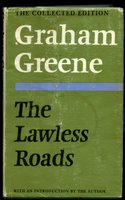
Mr. Tench went out to look for his ether cylinder, into the blazing Mexican sun and the bleaching dust. A few vultures looked down from the roof with shabby indifference: he wasn't carrion yet. A faint feeling of rebellion stirred in Mr. Tench's heart, and he wrenched up a piece of the road with splintering finger nails and tossed it feebly towards them. One rose and flapped across the town: over the tiny plaza, over the bust of the ex-president, ex-general, ex-human being, over two stalls which sold mineral water, towards the river and the sea. It wouldn't find anything there: the sharks looked after the carrion on that side. Mr. Tench went on across the plaza.
The Power and the Glory
So in Villahermosa there is nothing to do all the long Sundays that go on and on but sit in Victorian rocking chairs, swinging back and forth waiting for the sunset and the mosquitoes. The vultures group themselves on the roofs like pigeons: tiny moron heads, long necks, faces like Carnival masks, and dusty plumages, peering this way and that attentively for a death. I counted twenty one on the roof. They looked domesticated, as if they were going to lay an egg. And I suppose even a bird of prey does sometimes lay an egg.
The Lawless Roads
I went for a walk on shore; nothing to be seen but one little dusty plaza with fruit-drink stalls and a bust of Obregón on a pillar, two dentists' and a hairdresser's. The vultures squatted on the roofs. It was like a place besieged by scavengers - sharks in the river and vultures in the streets.
The Lawless Roads.
Greene picks the jungle isolated (more so in 1938) ruins of Palenque in the State of Chiapas as his "Holy Grail" excuse to venture into a country he spends much time describing his loathing for.
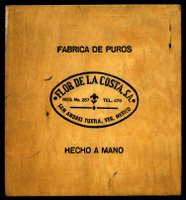
I had been in Palenque, too in the late 70s and it seems after reading Greene's description things had not changed much. The heat was almost unbearable. I was chain-smoking Flor de la Costa cigars from Veracruz to keep the mosquitoes at bay. The ruins were deserted, too. But unlike Green I experienced a fine and cooling tropical rain sheltered inside the Temple of the Inscriptions. When I rendered my photograph of it into a sepia colour I almost think it is much as Greene saw it.

Well, I had told people I was here in Chiapas to visit the ruins and I had visited them; but there was no compulsion to see them, and I hadn't the strength to climb more than two of the slopes and peer into two of the cold snaky chambers. I thought I was going to faint; I sat down on a stone and looked down - at trees, and nothing but trees, going on and on out of sight. It seemed to me that this wasn't a country to live in at all with the heat and the desolation; it was a country to die in and leave only ruins behind.
The Lawless Roads
When I happen to walk around Coal Harbour and other new condominium areas of Vancouver and I note the brand newness of everything, that metalic surgical clean, and the high technology entry systems I long for the humidity, the heat and even the "cold snaky chambers" of Palenque. I long for Mexico but unlike Greene, but like his journalist colleague Ambrose Bierce (as described beautifully in Carlos Fuentes' novel El Gringo Viejo), I would be prepared to die there.
Night and Day, October 28, 1937 The Films by Graham Greene
Wee Willie Winkie
The owners of a child star are like leaseholders — their property diminishes in value every year. Time's chariot is at their backs: before them acres of anonymity. What is Jackie Coogan now but a matrimonial squabble? Miss Shirley Temple's case, though, has peculiar interest: infancy with her is a disguise, her appeal is more secret and more adult. Already two years ago she was a fancy little piece — real childhood, I think, went out after The Littlest Rebel. In Captain January she wore trousers with the mature suggestiveness of a Dietrich: her neat and well-developed rump twisted in the tap-dance: her eyes had a sidelong searching coquetry. Now in Wee Willie Winkie, wearing short kilts, she is a complete totsy. Watch her swaggering stride across the Indian barrack-square: hear the gasp of excited expectation from her antique audience when the sergeant's palm is raised: watch the way she measures a man with agile studio eyes, with dimpled depravity. Adult emotions of love and grief glissade across the mask of childhood, a childhood skin-deep.
It is clever but it cannot last. Her admirers — middle aged men and clergymen — respond to her dubious coquetry, to the sight of her well-shaped and desirable little body, packed with enormous vitality, only because the safety curtain of story and dialogue drops between their intelligence and their desire. "Why are you making my Mummy cry?" - what could be purer than that? And the scene when dressed in a white nightdress she begs grandpa to take Mummy to a dance - what could be more virginal? On those lines in her new picture, made by John Ford, who directed The Informer, is horrifyingly competent. It isn't hard to stay to the last prattle and the last sob. The story — about an Afghan robber converted by Wee Willie Winkie to the British Raj — is a long way after Kipling. But we needn't be sour about that. Both stories are awful, but on the whole Hollywood's is the better.
In 1947 John Ford directed The Fugitive , a film based on Greene's Power and the Glory.
"Ah-smiled the colonel- to be a gringo in Mexico. That is better than suicide. That is what the Old Gringo used to say.
Gringo Viejo - Carlos Fuentes

One of Graham Greene's few books that I never managed to read until recently was his 1939 account of his trip to Mexico, The Lawless Roads. I had heard of this book and perhaps because he is so negative on Mexico I was never ever able to find a copy in Mexico during my years there. This last week I corrected my omission and bought a hardcover 1978 edition at MacLeod's Books on 455 West Pender.
There are many who assert that Greene traveled to Mexico to avoid being extradited for libel as Mexico lacked an extradition treaty with Great Britain.
Greene supplemented his novelist's income with freelance journalism, book and film reviews for The Spectator, and co-editing the magazine Night and Day, which folded in 1937 shortly after Greene's film review of Wee Willie Winkie , featuring nine-year-old Shirley Temple, cost the magazine a lost libel lawsuit. Greene's review claimed that Temple displayed "a certain adroit coquetry which appealed to middle-aged men". This statement is now considered one of the first criticisms of the sexualisation of children for entertainment. The criminal libel could have led to Greene's imprisonment, and its avoidance, according to Greene's friend Alberto Cavalcanti in an unpublished autobiography, was the motivation for the visit to Mexico which was to inspire The Power and the Glory.

Mr. Tench went out to look for his ether cylinder, into the blazing Mexican sun and the bleaching dust. A few vultures looked down from the roof with shabby indifference: he wasn't carrion yet. A faint feeling of rebellion stirred in Mr. Tench's heart, and he wrenched up a piece of the road with splintering finger nails and tossed it feebly towards them. One rose and flapped across the town: over the tiny plaza, over the bust of the ex-president, ex-general, ex-human being, over two stalls which sold mineral water, towards the river and the sea. It wouldn't find anything there: the sharks looked after the carrion on that side. Mr. Tench went on across the plaza.
The Power and the Glory
So in Villahermosa there is nothing to do all the long Sundays that go on and on but sit in Victorian rocking chairs, swinging back and forth waiting for the sunset and the mosquitoes. The vultures group themselves on the roofs like pigeons: tiny moron heads, long necks, faces like Carnival masks, and dusty plumages, peering this way and that attentively for a death. I counted twenty one on the roof. They looked domesticated, as if they were going to lay an egg. And I suppose even a bird of prey does sometimes lay an egg.
The Lawless Roads
I went for a walk on shore; nothing to be seen but one little dusty plaza with fruit-drink stalls and a bust of Obregón on a pillar, two dentists' and a hairdresser's. The vultures squatted on the roofs. It was like a place besieged by scavengers - sharks in the river and vultures in the streets.
The Lawless Roads.
Greene picks the jungle isolated (more so in 1938) ruins of Palenque in the State of Chiapas as his "Holy Grail" excuse to venture into a country he spends much time describing his loathing for.

I had been in Palenque, too in the late 70s and it seems after reading Greene's description things had not changed much. The heat was almost unbearable. I was chain-smoking Flor de la Costa cigars from Veracruz to keep the mosquitoes at bay. The ruins were deserted, too. But unlike Green I experienced a fine and cooling tropical rain sheltered inside the Temple of the Inscriptions. When I rendered my photograph of it into a sepia colour I almost think it is much as Greene saw it.

Well, I had told people I was here in Chiapas to visit the ruins and I had visited them; but there was no compulsion to see them, and I hadn't the strength to climb more than two of the slopes and peer into two of the cold snaky chambers. I thought I was going to faint; I sat down on a stone and looked down - at trees, and nothing but trees, going on and on out of sight. It seemed to me that this wasn't a country to live in at all with the heat and the desolation; it was a country to die in and leave only ruins behind.
The Lawless Roads
When I happen to walk around Coal Harbour and other new condominium areas of Vancouver and I note the brand newness of everything, that metalic surgical clean, and the high technology entry systems I long for the humidity, the heat and even the "cold snaky chambers" of Palenque. I long for Mexico but unlike Greene, but like his journalist colleague Ambrose Bierce (as described beautifully in Carlos Fuentes' novel El Gringo Viejo), I would be prepared to die there.
Night and Day, October 28, 1937 The Films by Graham Greene
Wee Willie Winkie
The owners of a child star are like leaseholders — their property diminishes in value every year. Time's chariot is at their backs: before them acres of anonymity. What is Jackie Coogan now but a matrimonial squabble? Miss Shirley Temple's case, though, has peculiar interest: infancy with her is a disguise, her appeal is more secret and more adult. Already two years ago she was a fancy little piece — real childhood, I think, went out after The Littlest Rebel. In Captain January she wore trousers with the mature suggestiveness of a Dietrich: her neat and well-developed rump twisted in the tap-dance: her eyes had a sidelong searching coquetry. Now in Wee Willie Winkie, wearing short kilts, she is a complete totsy. Watch her swaggering stride across the Indian barrack-square: hear the gasp of excited expectation from her antique audience when the sergeant's palm is raised: watch the way she measures a man with agile studio eyes, with dimpled depravity. Adult emotions of love and grief glissade across the mask of childhood, a childhood skin-deep.
It is clever but it cannot last. Her admirers — middle aged men and clergymen — respond to her dubious coquetry, to the sight of her well-shaped and desirable little body, packed with enormous vitality, only because the safety curtain of story and dialogue drops between their intelligence and their desire. "Why are you making my Mummy cry?" - what could be purer than that? And the scene when dressed in a white nightdress she begs grandpa to take Mummy to a dance - what could be more virginal? On those lines in her new picture, made by John Ford, who directed The Informer, is horrifyingly competent. It isn't hard to stay to the last prattle and the last sob. The story — about an Afghan robber converted by Wee Willie Winkie to the British Raj — is a long way after Kipling. But we needn't be sour about that. Both stories are awful, but on the whole Hollywood's is the better.
In 1947 John Ford directed The Fugitive , a film based on Greene's Power and the Glory.
Wednesday, March 11, 2009
José Verstappen, below left, the Executive Director of Early Music Vancouver has patiently nurtured a relationship with great baroque orchestras of the world and virtuoso performers while balancing it all by hiring and featuring local orchestras. It is because of this that he is giving Vancouver (and me!) the oportunity to listen to all six of Bach's Brandenburg Concertos played by one of the finest Baroque ensembles of the world, The Academy of Ancient Music. This is not an event that happens with any kind of frequency.
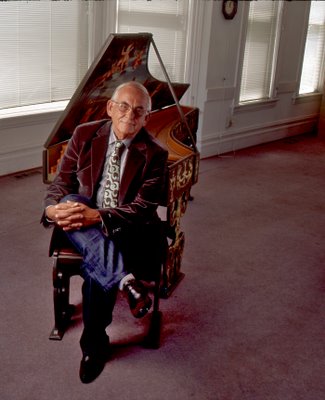
I don't as yet have the ambition of sitting down to watch Richard Wagner's Der Ring des Nibelungen. As my Argentine nephews would so crassly point out, "You would not want the line between your buttocks to disappear." My musical ambitions to listen to complete or rare pieces of live music are slightly more restrained but probably less likely to occur in one's lifetime.
Yet, 2008 and 2009, so far, have been excellent years for fulfilling these musical rights of passage. That they have happened or will happen in Vancouver is most extraordinary. I have my doubts that Toronto or Montreal and perhaps not even New York City could have mounted these three performances in a 5 month period. Consider:
November 29, 2008: Olivier Messiaen’s The Quartet for the End of Time performed by The Turning Point Ensemble.
February 15, 2009: Erik Satie’s Relâche performed by the Turning Point Ensemble.
March 11 (today), 2009 Bach’s The Six Brandenburg Concertos performed by The Ancient Academy of Music
In Mexico City I was lucky enough to listen to 5 of the 6 Brandenburg Concertos. The second one, in F major, was not performed as the impossibly difficult valveless trumpet, the clarino, part is even more difficult to play in Mexico City's rarified air.
Tonight I will be sitting with my friend Graham Walker at the Orpheum and we will delight at listening to all 6. The Orpheum's plush seats will keep the parting of that which we sit with intact.
Without any other factors to consider it would be enough for me to attend the concert knowing that The Academy of Ancient Music (its modern incarnation started when it was founded by Christopher Hogwood in 1973) had its beginnings in 1726 and that some of its concerts featured the then new music of Handel and his physical presence!
Furthermore after having gone to numerous Early Music Vancouver concerts in the past that featured harpsichordist Richard Egarr (now musical director of the Academy) I would not miss this concert knowing that this unassuming virtuso with a penchant for loud ties and socks will be in town again to lead in a performance of these works by a small ensemble of solo instruments. Scholars believe that the Brandenburgs were never intended for large orchestras.
When I sit with Graham Walker tonight my mother will be with me in spirit. She always told me that her desert island music could only be the complete Brandenburgs. "I would not need to listen to anything else. I would never grow bored of them."
But there are other interesting facts about the Brandenburgs, named after the Margrave of Brandenburg, who commissioned Bach to compose them. Bach was too busy to compose from scratch. So he assembled his more-or-less recent work and sent it off with the appropriate humble dedication. Musical gossip loves tales of genius unappreciated, so it has often been told that the Margrave didn't think much of the package and never bothered to have any of it performed. Perhaps the real reason that these concerti were not performed is that they were much too difficult for the Margrave's orchestra to play. They are written in the Italian style, three movements: fast, slow, fast, except for Brandenburg No 1 which has four. And if you are at the concert tonight listen to that trumpet in the Number 2 Concerto in F Major to find out what difficult and fast is.
My two favourites are the one with the high-pitched instruments, Number 2 and Number 5 in D Major, which features an extraordinary harpsichord cadenza where the player is given room to improvise. I will be sure to take my binoculars to check on Egarr's socks.
A few months back I listened to the Pacific Baroque Orchestra play Bach's Concerto in D Minor for Two Violins. I noticed some similarity to the Brandenburgs. So I asked an expert, violinist Marc Destrubé, below, centre, for an explanation. This was his answer:

I would say that what all of Bach's concertos have in common is a particular style (inspired very much from Italian models, Vivaldi in particular). The so-called 'joy-motive' I've referred to in rehearsal was first remarked on by Albert Schweitzer I believe, a three note figure which you hear repeated 5 times at the beginning of the Third Brandenburg concerto, for example. Once you've identified it, then you'll notice it all over the place (like noticing all the Audis on the road if you own one yourself), including in the opening of the last movement of the double violin concerto (although in this case it doesn't stop and repeat but is propelled forward); same with the opening movement of the E Major violin partita (No. 3). Which is also an organ prelude, and also used in a cantata.
In fact, once you start to explore this stuff in Bach you quickly get overwhelmed by the wonder of it all, particularly in the cantatas, virtually every page of which contains some magic stroke of musical symbolism (eg. the one alto aria in Tuesday's cantata concert has a transformation of tempo - from a leisurely minuet to a quick Allegro -just before the word 'verwechselt' (transforms) appears.
What a guy!
And it was Marc Destrubé in his years as founder and musical director of the Pacific Baroque Orchestra that he decided on an interesting experiment. The Pacific Baroque Orchestra would include in its program Brandenburg Concerto Number 3 in G Major and while commissioning Vancouver new music composer Bradshaw Pack to compose something inspired by it which he called Arioso Distante. When I attended the performance some years ago I spotted a beaming Pack in the back row. After the performance he told me, "Alex, only one person walked off!"
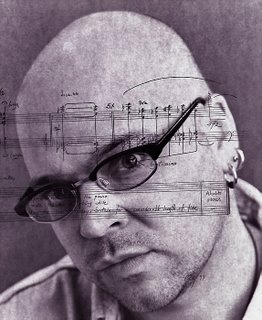
I asked Destrubé for a bit of background on this. Here is his answer:
Bradshaw's piece was commissioned for inclusion on a program with the 3rd Brandenburg concerto, suggesting that he use the same unusual (unique?) instrumentation: 3 violins/3 violas/3 cellos and basso (in Bach's case basso continuo being whatever combination of bass instruments might fit; in Bradshaw's case just a violone if I remember correctly - I'm at a French provincial airport after having celebrated my mother's 90th birthday).
I hope that helps.
Marc
An obscure fact. One of the musical selections chosen to represent the cultural self-image of the planet earth on the Voyager rockets in 1977 was an excerpt of one of the Brandenburgs, the first movement of the second concerto, on a sixteen and two third r.p.m.
José Verstappen, below left, the Executive Director of Early Music Vancouver has patiently nurtured a relationship with great baroque orchestras of the world and virtuoso performers while balancing it all by hiring and featuring local orchestras. It is because of this that he is giving Vancouver (and me!) the oportunity to listen to all six of Bach's Brandenburg Concertos played by one of the finest Baroque ensembles of the world, The Academy of Ancient Music. This is not an event that happens with any kind of frequency.

I don't as yet have the ambition of sitting down to watch Richard Wagner's Der Ring des Nibelungen. As my Argentine nephews would so crassly point out, "You would not want the line between your buttocks to disappear." My musical ambitions to listen to complete or rare pieces of live music are slightly more restrained but probably less likely to occur in one's lifetime.
Yet, 2008 and 2009, so far, have been excellent years for fulfilling these musical rights of passage. That they have happened or will happen in Vancouver is most extraordinary. I have my doubts that Toronto or Montreal and perhaps not even New York City could have mounted these three performances in a 5 month period. Consider:
November 29, 2008: Olivier Messiaen’s The Quartet for the End of Time performed by The Turning Point Ensemble.
February 15, 2009: Erik Satie’s Relâche performed by the Turning Point Ensemble.
March 11 (today), 2009 Bach’s The Six Brandenburg Concertos performed by The Ancient Academy of Music
In Mexico City I was lucky enough to listen to 5 of the 6 Brandenburg Concertos. The second one, in F major, was not performed as the impossibly difficult valveless trumpet, the clarino, part is even more difficult to play in Mexico City's rarified air.
Tonight I will be sitting with my friend Graham Walker at the Orpheum and we will delight at listening to all 6. The Orpheum's plush seats will keep the parting of that which we sit with intact.
Without any other factors to consider it would be enough for me to attend the concert knowing that The Academy of Ancient Music (its modern incarnation started when it was founded by Christopher Hogwood in 1973) had its beginnings in 1726 and that some of its concerts featured the then new music of Handel and his physical presence!
Furthermore after having gone to numerous Early Music Vancouver concerts in the past that featured harpsichordist Richard Egarr (now musical director of the Academy) I would not miss this concert knowing that this unassuming virtuso with a penchant for loud ties and socks will be in town again to lead in a performance of these works by a small ensemble of solo instruments. Scholars believe that the Brandenburgs were never intended for large orchestras.
When I sit with Graham Walker tonight my mother will be with me in spirit. She always told me that her desert island music could only be the complete Brandenburgs. "I would not need to listen to anything else. I would never grow bored of them."
But there are other interesting facts about the Brandenburgs, named after the Margrave of Brandenburg, who commissioned Bach to compose them. Bach was too busy to compose from scratch. So he assembled his more-or-less recent work and sent it off with the appropriate humble dedication. Musical gossip loves tales of genius unappreciated, so it has often been told that the Margrave didn't think much of the package and never bothered to have any of it performed. Perhaps the real reason that these concerti were not performed is that they were much too difficult for the Margrave's orchestra to play. They are written in the Italian style, three movements: fast, slow, fast, except for Brandenburg No 1 which has four. And if you are at the concert tonight listen to that trumpet in the Number 2 Concerto in F Major to find out what difficult and fast is.
My two favourites are the one with the high-pitched instruments, Number 2 and Number 5 in D Major, which features an extraordinary harpsichord cadenza where the player is given room to improvise. I will be sure to take my binoculars to check on Egarr's socks.
A few months back I listened to the Pacific Baroque Orchestra play Bach's Concerto in D Minor for Two Violins. I noticed some similarity to the Brandenburgs. So I asked an expert, violinist Marc Destrubé, below, centre, for an explanation. This was his answer:

I would say that what all of Bach's concertos have in common is a particular style (inspired very much from Italian models, Vivaldi in particular). The so-called 'joy-motive' I've referred to in rehearsal was first remarked on by Albert Schweitzer I believe, a three note figure which you hear repeated 5 times at the beginning of the Third Brandenburg concerto, for example. Once you've identified it, then you'll notice it all over the place (like noticing all the Audis on the road if you own one yourself), including in the opening of the last movement of the double violin concerto (although in this case it doesn't stop and repeat but is propelled forward); same with the opening movement of the E Major violin partita (No. 3). Which is also an organ prelude, and also used in a cantata.
In fact, once you start to explore this stuff in Bach you quickly get overwhelmed by the wonder of it all, particularly in the cantatas, virtually every page of which contains some magic stroke of musical symbolism (eg. the one alto aria in Tuesday's cantata concert has a transformation of tempo - from a leisurely minuet to a quick Allegro -just before the word 'verwechselt' (transforms) appears.
What a guy!
And it was Marc Destrubé in his years as founder and musical director of the Pacific Baroque Orchestra that he decided on an interesting experiment. The Pacific Baroque Orchestra would include in its program Brandenburg Concerto Number 3 in G Major and while commissioning Vancouver new music composer Bradshaw Pack to compose something inspired by it which he called Arioso Distante. When I attended the performance some years ago I spotted a beaming Pack in the back row. After the performance he told me, "Alex, only one person walked off!"

I asked Destrubé for a bit of background on this. Here is his answer:
Bradshaw's piece was commissioned for inclusion on a program with the 3rd Brandenburg concerto, suggesting that he use the same unusual (unique?) instrumentation: 3 violins/3 violas/3 cellos and basso (in Bach's case basso continuo being whatever combination of bass instruments might fit; in Bradshaw's case just a violone if I remember correctly - I'm at a French provincial airport after having celebrated my mother's 90th birthday).
I hope that helps.
Marc
An obscure fact. One of the musical selections chosen to represent the cultural self-image of the planet earth on the Voyager rockets in 1977 was an excerpt of one of the Brandenburgs, the first movement of the second concerto, on a sixteen and two third r.p.m.
Tuesday, March 10, 2009
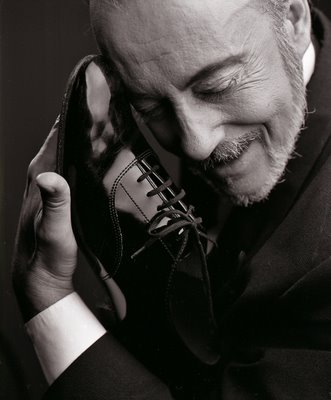
On Monday night I watched Carlos Saura's film Tango. I had first seen it when it came to Vancouver in 2002. Rosemary stayed upstairs. She knew I would be suffering from nostalgia and longing. Nostalgia and longing are not the same. Nostalgia is to want to experience something you had at one time. Longing involves knowing that it is a loss that is irreparable. Nostalgia is pleasant. To long for is to despair.
In November 2001 I danced the tango with 78 year-old Dolly at the Club Banco de la Nación Argentina at Vicente Lopez, an outskirt of Buenos Aires. I danced for almost two hours and nobody noticed me.
Me quité la espina (or to remove that thorn from myself) is a an expression in Spanish about satisfying a mild desire to eat ice-cream or in my case to get rid of an obsession to dance the Argentine tango. I removed that thorn on that Saturday evening at Vicente Lopez.
Before that, I was never able to dance the tango or dance at all because my father was such a good tango dancer. I grew up with a block about ever being able to dance anything. But it was around 1997 that I finally decided that my internal obsession for the tango (a thorn in my side!) had to be satisfied or exorcised.
That first and best teacher of mine right here in Vancouver, Argentine Carlos Loyola, (below left with partner) watched me stumble and said to me, “I will teach you to dance the tango as well as your father danced.” He almost delivered but then I must have been a lost cause. While Carlos Loyola inspired and pushed me to perfection, my lack of it made him angry and I soon was almost afraid. It was a second Carlos, the great Argentine tango dancer Carlos Gavito who taught me to accept what I did with resignation and contentment.
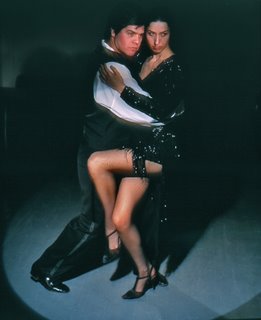
It all began at a March 1997 performance of Forever Tango at the Vogue on Granville. The performance made me realize I had been repressing my Argentine heritage. I decided to learn the tango. I think I was so inclined because I watched Carlos Gavito dance in what looked like a simple (no quick and fancy steps) performance with his sultry red-headed partner, Marcela Durán. The slightly paunchy, bearded man with a receding hairline got the attention of my wife. She though he was sexy. That had me worried as the “old” man, I found out later was a couple of years younger than I was.
While other dancers impressed us with leg ballistics, Gavito’s style was slow motion, with a particular step of his. Marcela Durán, her legs crossed at her ankles, was suddenly put at a 45 degree angle to the floor and Gavito would deftly swing her around like a merry-go-round while having her lean on his paunch. Because of the resemblance to a tent the step is called la carpa . Then and there I decided I had to learn the tango, and la carpa.

I had waited so long to commit. After all, I fell in love with Grace Kelley in 1956 when I was 14, watching her waltz with Louis Jordan in The Swan. Her marriage to Prince Rainier and my inability to dance made me a sad wallflower at the Catholic boarding school in Austin, Texas. To my classmates I was the Monk. If you didn’t dance you didn’t meet girls.
For some years the Monk showed up religiously with his wife Rosemary for weekly Tuesday and Friday practices the the Polish Community Centre on Fraser Street. There, because the tango is the tango, the Monk (giving somebody rabbit ears, is in picture below on the right side) was expected to dance with many partners. And because the tango is the tango when the Monk failed to glue his chest to his partner’s (in some cases and absolute stranger) I was chastised for not dancing properly. “Alex, unless you are close to your partner, “my instructor, Carlos Loyola would drum into me, “you will never learn to tango.” I had observed that when Loyola danced with women, he danced very close. One of the regulars in my class had once said, “He dances with her as if she were his suit.”
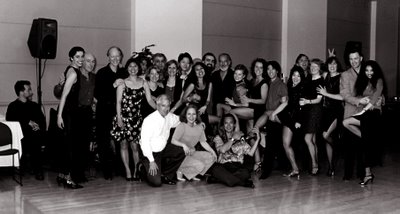
From Carlos Gavito, the legendary master from Avellaneda, I learned other truths about the tango. In a weekend beginner’s class he taught not moves, so much, as when not to move. He taught me la pausa. In tango the woman reacts to the man’s subtle indications of his right hand or body signs. Much like Prince Phillip follows the Queen, a few steps back, a good female tango dancer is always on her toes in a state of controlled imbalance, ready to swing in whatever direction the man chooses. When there are mood or tempo changes in the music, Gavito indicated to me, that is the moment when a man can simply stop, gather his thoughts, and only then might he move again.
Gavito who had been know to have given private classes to the tango obsessed Robert Duval when not tutoring the Monk or others taught me one more tango truth. “The tango does not come from here,” he said, placing his middle finger on his brow. He then placed his fingers on his heart. “…but from here. Tango," he stressed in his perfect Argentine-accented English, “is not steps. It is not tango or anything, if it does no come from the heart.”
I was elated when not only did nobody notice me dancing the tango in the old tango club but that my godmother and first cousin, Inesita O’Reilly Kuker and her daughter Marinés had not laughed at me. They had insisted on organizing the whole thing when I boasted to them that I had learned to dance the tango. “ Alexander,” my godmother and first cousin told me, “We are going to buy a bottle of Champagne and we are going to laugh at you.” They didn’t laugh at me. Nobody noticed me. I fit in. Finally that thorn on the side was gone. I was free. That thorn was in my head, not my heart. I should have known. Gavito had told me.

The story on how I came to take the above left photograph of Carlos Gavito is an interesting one. When I watched Gavito dance that March 1997 I had an idea.
"Do you want me to bring my partner?" Gavito asked me when I proposed a session in my studio. His partner, Marcela Durán was extremely beautiful but I said, "No I want you alone." I was to meet him outside the Vogue Theatre at 8:20 during the intermission. I was to have no more than 20 minutes.
Walking to my nearby studio people looked at us oddly. With his stage makup and dark Argentine suit Gavito looked like a vampire. On a rain slicked Granville Street it almost felt like we were strolling Avenida Corrientes in Buenos Aires.
I took a few tight portraits and showed him the Polaroids. Then I posed to him the problem, "A face is so far from the shoe. How is one to bring them together unless..." Gavito looked at me, then down at his charol (patent leather) shoes. He promptly removed one and brought it up to his face, "Una caricia (caress) por favor, "I asked.
Carlos Gavito died July 1, 2005

It was around midnight in November of 2004 when Rebecca, Rosemary and I sat down at a sidewalk table of Pizzería Burgio on Avenida Cabildo in Buenos Aires for a pizza. Rebecca sipped some of my ice-cold moscato, It was hot and deliciously muggy as it felt like we were in the tropics. Buses were running in both directions on the 10-lane wide Cabildo and there were so many passersby on the sidewalk that it seemed like it was noon during an eclipse. On one of the corners I could spy Cine General Paz where so many years before, 1949 or 1950 I had seen Beau Geste with my father and mother.
At my age I have condensed some of the important events of my life into a few. Beau Geste with my parents is one. It seems that I first thought of death in that film as dead soldiers stand guard on the crenellated ramparts of Fort Zinderneuf. How can I possibly forget the exciting naval battle in the beginning of the film, at the lily pond of Brandon Abbas when Beau Geste (a young boy Geste) and his band float two ships of the line, the British one and the French one and the canon of the latter accidentally fires on Beau’s younger brother John. John is taken care by the band.
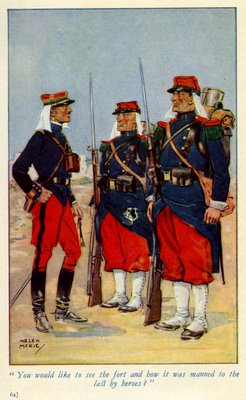
Blood oozed from the neat blue hole, and Faithful Hound uttered a dog-like howl of woe and horror. Claudia asked to be informed exactly how it felt. “Just like being shot,” I replied, and added: “I am going to be sick.”
“Do it in the pond then,” requested the Captain [Beau], producing his pocket-knife and a box of matches. “Going to cauterize the wound and prevent its turning sceptic?” enquired the Lieutenant [ Digby, Beau’s twin brother] as the Captain struck a match, and held the point of the small blade in the flame. “No,” replied the Captain. “Naval surgery without aesthetics…Cut out the cannon-ball.” “Now,” continued he, turning to me as I sat wondering whether I should shortly had a wooden leg, “will you be gagged or chew on a bullet? I don’t want to be disturbed by your beastly yells.” “I shall not yell Captain, “I replied with dignity, and a faint hope that I spoke the truth.”
Beau Geste, Percival Christopher Wren
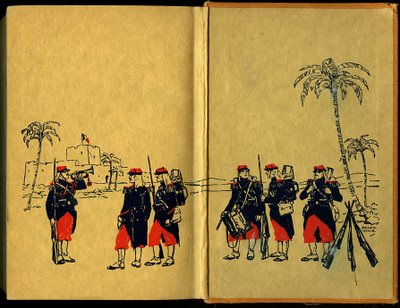
And of course in honour for his valour John Geste is given a Viking funeral and the French ship is sacrificed, or as Percival Christopher Wren writes, On this occasion, the offending French ship was dedicated to these ocean obsequies.
A specially selected lead soldier was solemnly endowed with the name and attributes of The Viking Eorl, John Geste, laid upon a matchbox filled with explosives, a pyre of matches built round him on the deck of the ship (the ship drenched with paraffin) his horse laid at the head of the pyre, and a small (China) dog at his feet.
All being ready, we bared our heads, Michael [Beau] with raised hand, solemnly uttered the beautiful words “Ashes to ashes, dust to dust, if God won’t have you the devil must,” and applying a match to the pyre, shoved the long-ship (late French battleship) well into the middle of the lily pond.
As any Beau Geste fan knows it is here where the honoured John promises his older Brother Beau a Viking Funeral should he ever fall in battle. I wasn’t to read the above words until many years later but Gary Cooper and company did a good job to amaze, to set my imagination free into somehow loving nautical novels, paradoxically in a film about the desert and the French Foreign Legion. And it is when young brother John finds himself in the middle of that Sahara Desert with the body of his older brother Beau that he is forced to consider carrying out his promise of the Viking Funeral.
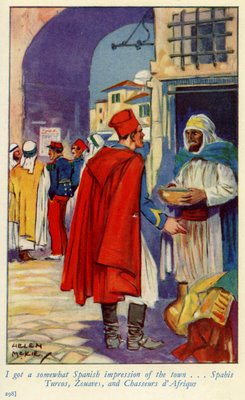
I have been delaying that moment of transfer that I have imposed on myself to pass on to Rebecca. I want her to have that same right of passage that I had as a boy. But is she ready? Is the film much too complicated or sophisticated in comparison with modern fare? Am I on the wrong track with this film that probably means nothing to our present generation? I thought so until Saturday afternoon.
When we get Rebecca and Lauren for a weekend sleepover I go through the pleasure of planning a film afternoon on our TV. I go to Videomatica to pick a couple of films that will entertain us all. I was intrigued by Spanish director Imanol Uribe's film and I noticed it had won much acclaim. How would Rebecca understand the concept of a little 12-year-old girl accompanying her mother to live in a small town in Spain during the Spanish Civil War. Would Rebecca understand when I explained that the little gir's father was an American pilot in the Lincoln Brigade and was fighting for the Spanish Republic with help from Communist Russia. Would she understand that the monarchists under Francisco Franco were really fascists backed by Nazi Germany?
In the end we had a most pleasant afternoon. At the dinner table Rebecca asked me about the justification for dropping the atom bomb over Hiroshima. We talked of Guernica, of Dresden of London and of Hamburg. I feel confident that any day now I will rent Beau Geste and all will be well with my world and Rebecca's.
Lauren at 6 seems to have a very good attention span and she was as fascinated as we were in watching the superb performance of Claro Lago who played Carol in the film. In my next viewing of Beau Geste I think I will have two little girls for company. I have a garden pond. I can get a couple of ships and...

Listening to a relatively obscure Brahms piano sonata on the radio while driving, some years ago, made me stop the car. I parked it. I had never heard it before. It was exquisite. I found the need to call someone who understood. I called my VSO pianist friend Linda Lee Thomas. Her husband, Vancouver Chamber Orchestra director, Jon Washburn answered the phone. So I told him of my sonic "on my road to Damascus" adventure. He commented:
"Ah, Alex, I envy you for being able to listen to something for the first time."
I had a similar sonic (but also visual) experience of the sort last night. I was invited by my friend Abraham Rogatnick to a performance at PAL last night. PAL stands for Performing Arts Lodge, (see below). It is a beautiful new building with a roof garden that sits not far from the Bayshore Hotel on Cardero. The lodge houses many of BC's finest retired actors and musicians. They have started a series called Solo Series where one actor or actress gives a performance in PAL's intimate and small theatre while one drinks good wines and eats well in a most civilized manner.

In one of those strange circumstances where although I have photographed many prominent BC actors and actresses I had never photographed Nicola Cavendish. And I am ashamed (but also delighted, read on!) to admit I had never seen her in performance until last night. I had never seen her in Willie Russell's Shirley Valentine. I was perplexed that they were serving us Greek food. It was Rogatnick who explained that the play had a lot to do with Greece.
The play, as it was explained to us by the delightful Cavendish, usually features actual cooking in a real kitchen. In this production she made the gestures of cooking eggs and chips. It was after her remarkable performance that she confessed, "There are so many things happening in this play but here, for the first time, I have been left alone with all the words. And what words..."
Shirley Valentine has become a signature play for Cavendish and she has finally, as she told us, "Let it go." But she made an exception for us last night and I felt again as if I were listening to that Brahms piano sonata for the first time. What a wonder! What a delight! And what despair as I thought that could not write about it here. I have no picture of Cavendish. But it was Cavendish who gave me a pleasant solution when:
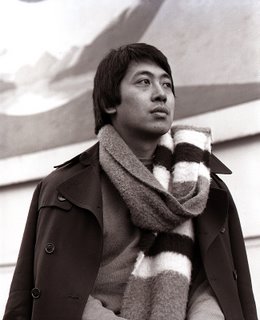
She mentioned that her first acting teacher had been the gracious Joy Coghill (PAL resident and advisor to the Solo Series). Some 15 years ago I had photographed Coghill (above, left) for a brochure for that years's YWCA Women of Distinction. Another PAL resident is David Y. H. Lui (left) founder of Ballet British Columbia. He was a dashing young man when I photographed him by the wall of the old Grayhound Bus Station.
The next in the Solo Series is on Friday April 17 and Saturday April 18. It will feature Rosy Fire-Dryden in her tour de force performance of Martin Sherman's Rose - A moving journey through 20th Century Jewish life. To reserve: solo @shaw.ca
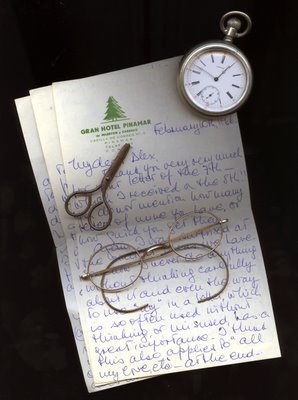
Seeing the lovely evocative still life pictures, in the newspapers, containing some of Mahatma Gandhi’s personal items that went up for auction this past week reinforced my concern about my wife telling me a few weeks ago that, “I was no longer for this world,” as I thought too much about the past. Rosemary increasingly feels that I don’t fit much in my present. Jokingly asking Hilary (at the dinner table) last Monday if she could obtain a large bottle of sleeping pills for me was not taken as a joke and I was received with ice-cold silence. Even Rebecca caught on.
The pictures of Gandhi, his pocket watch and glasses made me think of my past (and yes Rosemary) about my mother. In that hazy era of my life in the late 40s when I was under 10 my mother had introduced me to evil when she had noted that when my hair fell over my eyes I looked like Hitler. “Who is Hitler, “I had asked. “He was an evil man, “she answered. And I first heard of goodness from her, too. Often when I misbehaved she would tell me that I should try to be good like Mahatma Gandhi. I have visions of b+w newsreels showing the British leaving India. As soon as the Indians opened their embassy in Buenos Aires my father did translation work for them. He even had the audacity to invite some of his Indian friends home to sample his curry.
During the middle ages and the renaissance, painters and sculptors worked on commission. Their portraits and sculptures were for wealthy patrons or purchased to decorate the churches of a wealthy Catholic church. It is only with war that these paintings and sculptures changed hands. Napoleon looted the treasures of Venice and Egytp, the Spaniards looted the Lower Countries and the works of art then changed hands from the Spanish kings to the Prado Museum. The British looted the treasures of Greece and other parts of their farflung empire. The idea of seeing a work of art on a gallery wall is a relatively modern phenomenon. The few paintings that remained in private hands (after museums secured most of them) have changed hands in the latter part of the 20th century and in the beginning of this one for huge sums of money. When paintings just about disappeared, auction houses “discovered” the works of photographers and as an example, the photographs of American Edward Steichen. One of his prints sold for millions recently. With so many rich people in the world, exclusivity and power are the only ways to rise from wealthy anonymity. With few paintings, sculptures and exotic cars like Duisenbergs left, people with money now achieve exclusivity by collecting fame or infamy. Fame, Gandhi’s glasses, infamy a Hitler watercolour. O.J. Simpson’s white Ford Bronco will surely be snapped up for lots of money in a not-so-distant future.
This trend to collect the trappings of fame is no different from the medieval one to secure the bodies or parts thereof saints. The Venetians in 828 ‘kidnapped” St. Matthew’s body from under the eyes of Egyptians in Alexandria.
The trend to search for fame has brought us all those homes and hotels with signs that say, “Martha Washington slept here,” “Alexander von Humboldt wrote here," "Oscar Wilde was caught in the act of ...here," and the like.
Our memory for history is certainly longer than for the history of our own lives. In the early 70s Rosemary asked my mother to write (with a white pen) the names of her relatives and my father’s with dates in our photo album. Death to me has always been staring at me from the pages of my family album. If some of those faces have not been identified by my mother I do not know who they are. Therefore they are finally dead. They are dead in the vacuum of our memory. I expect my picture to stare back at some descendant of mine in a near future (two generations is all it takes) who will stare back and draw a blank.
In the still life here I have placed on my scanner a letter I received from my girlfriend Susy in February 1966 who was vacationing in the resort town of Pinamar. We got to know each other through these letters and finally managed to get a weekend at the Naval Ministry off and I hitchhiked to Pinamar where we met on the beach. So romantic, so long ago it was. Susy is dead and I have a few of her letters and some memories. Would anybody care to read the letters now? I don’t think so. Will Rebecca and Lauren find them fascinating when they are older? I doubt it. Should I keep them? I do because I don’t have the heart to throw them away or to burn them. The little scissors and the gold eyeglasses belonged to Rosemary's grandmother. The Longines watch I won at cards in the late 60s. They have an intrisic value to Rosmary, to me, now.
Ultimately the difference between ordinary mortals and celebrities like Gandhi is time. Time in the end brings us all an oblivion we all democratically share. Meanwhile as we get older and we are surrounded by all these objects of our past, parting with them is an anguish almost too terrible to bear.

In the fall of 2008 I had the good fortune to photograph two very good Vancouver theatre directors who happen to be friends. I photographed Bill Millerd, Artistic Managing Director of the Arts Club Theatre Company with his counterpart of Bard on the Beach, Christopher Gaze. I told them both of my excitement of also having to photograph another of my favourite directors, Kim Collier of the Electric Theatre Company. I had seen her direction, an Electric Theatre Company production of Jean Paul Sartre’s No Exit. My wife Rosemary is rarely pleased by anything and she thought No Exit was terrific. At that point Millerd told me that his company had commissioned Collier and her company to work on a project for him. Not to be left without saying anything, Gaze told me, “And we also have another talented young female director, besides Collier in our Titus Andronicus. Meg roe is doing The Tempest for us. She is extraordinary.” With Gaze’s diction and voice I was already awed.
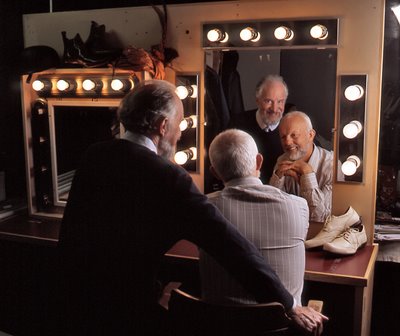
But not as awed as I was last night when Rosemary and I went to see the Joan Macleod play Toronto, Mississippi, a Playhouse Theatre Company production directed by Dean Paul Gibson, another director and actor who has paid his dues in full for both Bard On the Beach and the Arts Club Theatre Company. I have seen this funny actor direct dead serious plays and funny plays but I had never seen him direct a dead serious & funny play. It is almost superfluous for me to mention that Rosemary thinks Dean Paul Gibson is fantastic and even pointed out his spiffy new attire, (so English!) that he was wearing last night at the intermission. “And he has even lost weight, “she duly informed me. It would seem to me that he probably lost 15 pounds just in the rehearsals of this terrific play and shows that he has a gentle and non intruding touch when necessary. After all he had three very good actors, Alessandro Juliani, (Bill) William MacDonald (King) and Colleen Wheeler (Maddie) at his disposal. It was the fourth, Meg Roe who delivered fully in spades.
I wonder how Gibson managed to coax (Was that indeed the case?) that performance (It could not possibly have been only that, could it?) from Meg Roe?
My first impression was (I had not read the program as I like to be surprised and like the challenge of figuring out a play on my own) that the actress on stage was autistic. Maddie (Colleen Wheeler) her mother erroneously speculates that it was caused by oxygen deprivation at birth. It took me a while to understand that I was watching a performance that only (and only perhaps ) someone like Sissy Spacek, her look-alike, could have delivered.
It is not often that as I watch a play I forget that an actor is acting. The other three actors were very good (in particular Alessandro Juliani's believable warmth and understanding of a young girl's mental deffects) they were actors acting. Meg Roe was Jhana. I have a feeling that Dean Paul Gibson must have just given her the floor to do as she pleased.
As I watched Alessandro Juliani I thought of a friend, novelist and writer John Lekich. He, like, Meg Roe’s Jhana, may have suffered oxygen deprivation at birth. Rosemary asked me, at the end of the play, “What must it be like for a parent to have a girl like that? How would they take coming to a play like this? ” I said nothing as I was thinking of Lekich and his admiration for Alessandro’s father John whom I never had the luck to photograph. I can see the physical resemblance. When John Juliani was alive he was Vancouver's most handsome man.
I wonder if Lekich will have the curiousity and courage to go to this play should he read this?

If Meg Roe does not receive a Jessie Richardson for her performance I am sure that Jessie Richardson, right, might just stop smiling for a while. As we left I ran into actor Marco Soriano and I commented, "Meg Roe can act and direct." Soriano countered, "And sound design, too!"
Toronto, Mississippi continues until March 21 at the Playhouse.
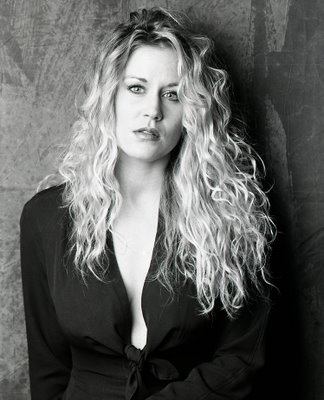
A few months ago a good client of mine, a criminal law firm called me up for a job. It was an important job and when the lawyer decided on the pictures and gave me a call I went to look for the file. I could not find the pictures which were 6x7 cm transparencies. I looked everywhere an in particular those piles that the paperless digital revolution reneged on. My next step was to go to my diary and see what other jobs I may have done at the same time and perhaps I had inadvertently inserted the law firm’s pictures with them. That got me nowhere. By this point I was desperate. I told Rosemary, “If these guys choose to sue me we are going to be in serious trouble. They are very good.”
I went into the living room (where I keep my computer on a fine Edwardian desk overlooking my garden). Then I looked at a pile of big heavy books on a table. I have run out of space for books in my bookshelves so I put books on tables and place them (as neatly as I can) on piles on the floor. I rushed to the big heavy books as I remembered what I had done with the transparencies. Of late my film processor, the Lab has been having problems with film curl. It does not happen with Japanese films but it seems to plague Kodak Ektachrome and one faithful user. That’s me. In order for me to scan these transparencies I must place them under heavy books for a day or two to flatten them.
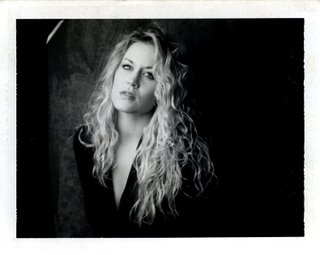
Today the scenario repeated itself but this time I have no magic bullet and my memory fails me as I have looked for the pictures of another law firm (personal injury). I took them a year and a half ago. I kept the high resolution scan files in my computer until about two months ago. Then I purged them knowing I have the originals safely filed. That is not the case. I have spent long hours going through all the different kinds of misspellings and variants to the firm’s name. It would take many weeks to look into every file (about 12 four-drawer filing cabinets full of stuff).
While looking for the pictures in those files on the floor (I always seem to be behind in my filing) I found a Polaroid of a luscious blond. I thought and thought of her name but my memory was frazzled. It finally came. I remember the day some years ago. It has to be at least 15 years since the background is a hand painted brown canvas backdrop. They had been in vogue in those days although by then their popularity was in decline. Tony Ricci had called me one day. “Alex I want you to do me a favour. I want you to photograph a girl I know. She has a young daughter. She is a bit lost. Maybe she can model. Please take her picture for me. Her name is Haven.”

I did. In my files under Haven I found exactly 9 b+w images. I don't recall why it is that I took so few. Nine pictures and one Polaroid, that's all there is of Haven.
I called her weeks later and delivered my contacts to her. At the time she was working as a hairdresser in a very nice downtown salon. I never heard from her again.
Today Haven made my day.
Addendum
Late today Thursday with my mind relaxed after gazing at the calm beauty of Haven I can report that I have found the lost transparencies.
 When I visit Alleyne and Barbara Cook’s North Vancouver garden in June I automatically rush to gaze and smell a Damask rose called ‘Ispahan’. It was brought to Europe in the XIII century. Named after the ancient city in Iran this wonderful rose transports me into the exotic times, and places of the stories of Scheherazade. The last thought in my mind as I take in the wonderful fragrance of this pink rose is a huge building with thousands of spinning centrifuges enriching uranium to atomic bomb grade.
When I visit Alleyne and Barbara Cook’s North Vancouver garden in June I automatically rush to gaze and smell a Damask rose called ‘Ispahan’. It was brought to Europe in the XIII century. Named after the ancient city in Iran this wonderful rose transports me into the exotic times, and places of the stories of Scheherazade. The last thought in my mind as I take in the wonderful fragrance of this pink rose is a huge building with thousands of spinning centrifuges enriching uranium to atomic bomb grade.
In the late 50s and even into the 60s I would often take a look at the bottom plate of my Pentacon F 35mm SLR and read with wonder, embossed on the strip of real black leather, Made In USSR Occupied Zone. It wasn’t too long ago that if I spotted a clunky Russian Lada I would stop and stare and examine its metal as if steel from the USSR were as exotic as the rings of Saturn.
My vision of Mexico in the 50s was of Aztec priests ripping open the chests of beautiful dark Tlaxcalan virgins with an obsidian knife and tearing out the still palpitating hearts that were then offered to that nasty and blood-thirsty war god Huitzilopochtli. I had no vision of white sandy beaches and piña coladas.
Before you could order chili-avocado sushi at a Tacubaya Starbucks in Mexico City, the exotic for me was the remote, the romantic and the unknown. The world for me was a plate of roast beef, mashed potatoes and salad on one plate, but all in their separate sector. I was careful that the gravy would not spread in the direction of the salad. As the world has become more the same in a globalized blend there is little left that is exotic.

In 1999 I was assigned to photograph five female Native Canadian filmmakers. Alas, the one I knew, Dana Claxton was a no show. The four that showed up at my studio (on separate days) were like Ispahan roses. I was an awe of them. I had never been this close to a Native Canadian except for a few snaps of Chief Dan George many years before at a CBC variety show.
When Loretta Todd opened a box that contained a turquoise necklace, its colour made me think that I was on acid (an experience of my imagination since I never touched the stuff).
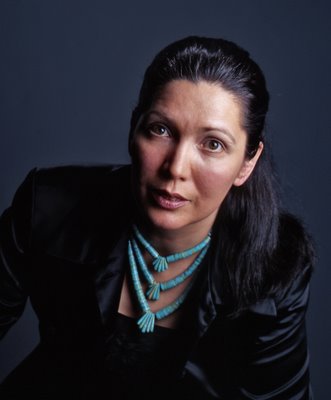
But it was when Arlene Bowman, a Dine (Navajo) from Phoenix, Arizona came into my studio that I thought I was staring at a living and breathing Edward S. Curtis photogravure. I had to photograph her in profile. I was magically transported back in time.
Now in the year of 2009 I search for the wonder of the exotic. Should I run into a blank, June is around the corner and Rosa ‘Ispahan’ beckons as I think of sipping cool pomegranate juice while being told wondrous stories by a beautiful veiled maiden.
Native Canadian Princesses
Photogravure
More Photogravures
My Pentacon F

On Monday night I watched Carlos Saura's film Tango. I had first seen it when it came to Vancouver in 2002. Rosemary stayed upstairs. She knew I would be suffering from nostalgia and longing. Nostalgia and longing are not the same. Nostalgia is to want to experience something you had at one time. Longing involves knowing that it is a loss that is irreparable. Nostalgia is pleasant. To long for is to despair.
In November 2001 I danced the tango with 78 year-old Dolly at the Club Banco de la Nación Argentina at Vicente Lopez, an outskirt of Buenos Aires. I danced for almost two hours and nobody noticed me.
Me quité la espina (or to remove that thorn from myself) is a an expression in Spanish about satisfying a mild desire to eat ice-cream or in my case to get rid of an obsession to dance the Argentine tango. I removed that thorn on that Saturday evening at Vicente Lopez.
Before that, I was never able to dance the tango or dance at all because my father was such a good tango dancer. I grew up with a block about ever being able to dance anything. But it was around 1997 that I finally decided that my internal obsession for the tango (a thorn in my side!) had to be satisfied or exorcised.
That first and best teacher of mine right here in Vancouver, Argentine Carlos Loyola, (below left with partner) watched me stumble and said to me, “I will teach you to dance the tango as well as your father danced.” He almost delivered but then I must have been a lost cause. While Carlos Loyola inspired and pushed me to perfection, my lack of it made him angry and I soon was almost afraid. It was a second Carlos, the great Argentine tango dancer Carlos Gavito who taught me to accept what I did with resignation and contentment.

It all began at a March 1997 performance of Forever Tango at the Vogue on Granville. The performance made me realize I had been repressing my Argentine heritage. I decided to learn the tango. I think I was so inclined because I watched Carlos Gavito dance in what looked like a simple (no quick and fancy steps) performance with his sultry red-headed partner, Marcela Durán. The slightly paunchy, bearded man with a receding hairline got the attention of my wife. She though he was sexy. That had me worried as the “old” man, I found out later was a couple of years younger than I was.
While other dancers impressed us with leg ballistics, Gavito’s style was slow motion, with a particular step of his. Marcela Durán, her legs crossed at her ankles, was suddenly put at a 45 degree angle to the floor and Gavito would deftly swing her around like a merry-go-round while having her lean on his paunch. Because of the resemblance to a tent the step is called la carpa . Then and there I decided I had to learn the tango, and la carpa.

I had waited so long to commit. After all, I fell in love with Grace Kelley in 1956 when I was 14, watching her waltz with Louis Jordan in The Swan. Her marriage to Prince Rainier and my inability to dance made me a sad wallflower at the Catholic boarding school in Austin, Texas. To my classmates I was the Monk. If you didn’t dance you didn’t meet girls.
For some years the Monk showed up religiously with his wife Rosemary for weekly Tuesday and Friday practices the the Polish Community Centre on Fraser Street. There, because the tango is the tango, the Monk (giving somebody rabbit ears, is in picture below on the right side) was expected to dance with many partners. And because the tango is the tango when the Monk failed to glue his chest to his partner’s (in some cases and absolute stranger) I was chastised for not dancing properly. “Alex, unless you are close to your partner, “my instructor, Carlos Loyola would drum into me, “you will never learn to tango.” I had observed that when Loyola danced with women, he danced very close. One of the regulars in my class had once said, “He dances with her as if she were his suit.”

From Carlos Gavito, the legendary master from Avellaneda, I learned other truths about the tango. In a weekend beginner’s class he taught not moves, so much, as when not to move. He taught me la pausa. In tango the woman reacts to the man’s subtle indications of his right hand or body signs. Much like Prince Phillip follows the Queen, a few steps back, a good female tango dancer is always on her toes in a state of controlled imbalance, ready to swing in whatever direction the man chooses. When there are mood or tempo changes in the music, Gavito indicated to me, that is the moment when a man can simply stop, gather his thoughts, and only then might he move again.
Gavito who had been know to have given private classes to the tango obsessed Robert Duval when not tutoring the Monk or others taught me one more tango truth. “The tango does not come from here,” he said, placing his middle finger on his brow. He then placed his fingers on his heart. “…but from here. Tango," he stressed in his perfect Argentine-accented English, “is not steps. It is not tango or anything, if it does no come from the heart.”
I was elated when not only did nobody notice me dancing the tango in the old tango club but that my godmother and first cousin, Inesita O’Reilly Kuker and her daughter Marinés had not laughed at me. They had insisted on organizing the whole thing when I boasted to them that I had learned to dance the tango. “ Alexander,” my godmother and first cousin told me, “We are going to buy a bottle of Champagne and we are going to laugh at you.” They didn’t laugh at me. Nobody noticed me. I fit in. Finally that thorn on the side was gone. I was free. That thorn was in my head, not my heart. I should have known. Gavito had told me.

The story on how I came to take the above left photograph of Carlos Gavito is an interesting one. When I watched Gavito dance that March 1997 I had an idea.
"Do you want me to bring my partner?" Gavito asked me when I proposed a session in my studio. His partner, Marcela Durán was extremely beautiful but I said, "No I want you alone." I was to meet him outside the Vogue Theatre at 8:20 during the intermission. I was to have no more than 20 minutes.
Walking to my nearby studio people looked at us oddly. With his stage makup and dark Argentine suit Gavito looked like a vampire. On a rain slicked Granville Street it almost felt like we were strolling Avenida Corrientes in Buenos Aires.
I took a few tight portraits and showed him the Polaroids. Then I posed to him the problem, "A face is so far from the shoe. How is one to bring them together unless..." Gavito looked at me, then down at his charol (patent leather) shoes. He promptly removed one and brought it up to his face, "Una caricia (caress) por favor, "I asked.
Carlos Gavito died July 1, 2005
Rebecca Sips Moscato - Beau Geste & A Viking Funeral
Monday, March 09, 2009

It was around midnight in November of 2004 when Rebecca, Rosemary and I sat down at a sidewalk table of Pizzería Burgio on Avenida Cabildo in Buenos Aires for a pizza. Rebecca sipped some of my ice-cold moscato, It was hot and deliciously muggy as it felt like we were in the tropics. Buses were running in both directions on the 10-lane wide Cabildo and there were so many passersby on the sidewalk that it seemed like it was noon during an eclipse. On one of the corners I could spy Cine General Paz where so many years before, 1949 or 1950 I had seen Beau Geste with my father and mother.
At my age I have condensed some of the important events of my life into a few. Beau Geste with my parents is one. It seems that I first thought of death in that film as dead soldiers stand guard on the crenellated ramparts of Fort Zinderneuf. How can I possibly forget the exciting naval battle in the beginning of the film, at the lily pond of Brandon Abbas when Beau Geste (a young boy Geste) and his band float two ships of the line, the British one and the French one and the canon of the latter accidentally fires on Beau’s younger brother John. John is taken care by the band.

Blood oozed from the neat blue hole, and Faithful Hound uttered a dog-like howl of woe and horror. Claudia asked to be informed exactly how it felt. “Just like being shot,” I replied, and added: “I am going to be sick.”
“Do it in the pond then,” requested the Captain [Beau], producing his pocket-knife and a box of matches. “Going to cauterize the wound and prevent its turning sceptic?” enquired the Lieutenant [ Digby, Beau’s twin brother] as the Captain struck a match, and held the point of the small blade in the flame. “No,” replied the Captain. “Naval surgery without aesthetics…Cut out the cannon-ball.” “Now,” continued he, turning to me as I sat wondering whether I should shortly had a wooden leg, “will you be gagged or chew on a bullet? I don’t want to be disturbed by your beastly yells.” “I shall not yell Captain, “I replied with dignity, and a faint hope that I spoke the truth.”
Beau Geste, Percival Christopher Wren

And of course in honour for his valour John Geste is given a Viking funeral and the French ship is sacrificed, or as Percival Christopher Wren writes, On this occasion, the offending French ship was dedicated to these ocean obsequies.
A specially selected lead soldier was solemnly endowed with the name and attributes of The Viking Eorl, John Geste, laid upon a matchbox filled with explosives, a pyre of matches built round him on the deck of the ship (the ship drenched with paraffin) his horse laid at the head of the pyre, and a small (China) dog at his feet.
All being ready, we bared our heads, Michael [Beau] with raised hand, solemnly uttered the beautiful words “Ashes to ashes, dust to dust, if God won’t have you the devil must,” and applying a match to the pyre, shoved the long-ship (late French battleship) well into the middle of the lily pond.
As any Beau Geste fan knows it is here where the honoured John promises his older Brother Beau a Viking Funeral should he ever fall in battle. I wasn’t to read the above words until many years later but Gary Cooper and company did a good job to amaze, to set my imagination free into somehow loving nautical novels, paradoxically in a film about the desert and the French Foreign Legion. And it is when young brother John finds himself in the middle of that Sahara Desert with the body of his older brother Beau that he is forced to consider carrying out his promise of the Viking Funeral.

I have been delaying that moment of transfer that I have imposed on myself to pass on to Rebecca. I want her to have that same right of passage that I had as a boy. But is she ready? Is the film much too complicated or sophisticated in comparison with modern fare? Am I on the wrong track with this film that probably means nothing to our present generation? I thought so until Saturday afternoon.
When we get Rebecca and Lauren for a weekend sleepover I go through the pleasure of planning a film afternoon on our TV. I go to Videomatica to pick a couple of films that will entertain us all. I was intrigued by Spanish director Imanol Uribe's film and I noticed it had won much acclaim. How would Rebecca understand the concept of a little 12-year-old girl accompanying her mother to live in a small town in Spain during the Spanish Civil War. Would Rebecca understand when I explained that the little gir's father was an American pilot in the Lincoln Brigade and was fighting for the Spanish Republic with help from Communist Russia. Would she understand that the monarchists under Francisco Franco were really fascists backed by Nazi Germany?
In the end we had a most pleasant afternoon. At the dinner table Rebecca asked me about the justification for dropping the atom bomb over Hiroshima. We talked of Guernica, of Dresden of London and of Hamburg. I feel confident that any day now I will rent Beau Geste and all will be well with my world and Rebecca's.
Lauren at 6 seems to have a very good attention span and she was as fascinated as we were in watching the superb performance of Claro Lago who played Carol in the film. In my next viewing of Beau Geste I think I will have two little girls for company. I have a garden pond. I can get a couple of ships and...
Nicola Cavendish & My First Valentine With Joy
Sunday, March 08, 2009

Listening to a relatively obscure Brahms piano sonata on the radio while driving, some years ago, made me stop the car. I parked it. I had never heard it before. It was exquisite. I found the need to call someone who understood. I called my VSO pianist friend Linda Lee Thomas. Her husband, Vancouver Chamber Orchestra director, Jon Washburn answered the phone. So I told him of my sonic "on my road to Damascus" adventure. He commented:
"Ah, Alex, I envy you for being able to listen to something for the first time."
I had a similar sonic (but also visual) experience of the sort last night. I was invited by my friend Abraham Rogatnick to a performance at PAL last night. PAL stands for Performing Arts Lodge, (see below). It is a beautiful new building with a roof garden that sits not far from the Bayshore Hotel on Cardero. The lodge houses many of BC's finest retired actors and musicians. They have started a series called Solo Series where one actor or actress gives a performance in PAL's intimate and small theatre while one drinks good wines and eats well in a most civilized manner.

In one of those strange circumstances where although I have photographed many prominent BC actors and actresses I had never photographed Nicola Cavendish. And I am ashamed (but also delighted, read on!) to admit I had never seen her in performance until last night. I had never seen her in Willie Russell's Shirley Valentine. I was perplexed that they were serving us Greek food. It was Rogatnick who explained that the play had a lot to do with Greece.
The play, as it was explained to us by the delightful Cavendish, usually features actual cooking in a real kitchen. In this production she made the gestures of cooking eggs and chips. It was after her remarkable performance that she confessed, "There are so many things happening in this play but here, for the first time, I have been left alone with all the words. And what words..."
Shirley Valentine has become a signature play for Cavendish and she has finally, as she told us, "Let it go." But she made an exception for us last night and I felt again as if I were listening to that Brahms piano sonata for the first time. What a wonder! What a delight! And what despair as I thought that could not write about it here. I have no picture of Cavendish. But it was Cavendish who gave me a pleasant solution when:

She mentioned that her first acting teacher had been the gracious Joy Coghill (PAL resident and advisor to the Solo Series). Some 15 years ago I had photographed Coghill (above, left) for a brochure for that years's YWCA Women of Distinction. Another PAL resident is David Y. H. Lui (left) founder of Ballet British Columbia. He was a dashing young man when I photographed him by the wall of the old Grayhound Bus Station.
The next in the Solo Series is on Friday April 17 and Saturday April 18. It will feature Rosy Fire-Dryden in her tour de force performance of Martin Sherman's Rose - A moving journey through 20th Century Jewish life. To reserve: solo @shaw.ca
Gandhi & Hitler - Goodness & Evil In My Memory
Saturday, March 07, 2009

Seeing the lovely evocative still life pictures, in the newspapers, containing some of Mahatma Gandhi’s personal items that went up for auction this past week reinforced my concern about my wife telling me a few weeks ago that, “I was no longer for this world,” as I thought too much about the past. Rosemary increasingly feels that I don’t fit much in my present. Jokingly asking Hilary (at the dinner table) last Monday if she could obtain a large bottle of sleeping pills for me was not taken as a joke and I was received with ice-cold silence. Even Rebecca caught on.
The pictures of Gandhi, his pocket watch and glasses made me think of my past (and yes Rosemary) about my mother. In that hazy era of my life in the late 40s when I was under 10 my mother had introduced me to evil when she had noted that when my hair fell over my eyes I looked like Hitler. “Who is Hitler, “I had asked. “He was an evil man, “she answered. And I first heard of goodness from her, too. Often when I misbehaved she would tell me that I should try to be good like Mahatma Gandhi. I have visions of b+w newsreels showing the British leaving India. As soon as the Indians opened their embassy in Buenos Aires my father did translation work for them. He even had the audacity to invite some of his Indian friends home to sample his curry.
During the middle ages and the renaissance, painters and sculptors worked on commission. Their portraits and sculptures were for wealthy patrons or purchased to decorate the churches of a wealthy Catholic church. It is only with war that these paintings and sculptures changed hands. Napoleon looted the treasures of Venice and Egytp, the Spaniards looted the Lower Countries and the works of art then changed hands from the Spanish kings to the Prado Museum. The British looted the treasures of Greece and other parts of their farflung empire. The idea of seeing a work of art on a gallery wall is a relatively modern phenomenon. The few paintings that remained in private hands (after museums secured most of them) have changed hands in the latter part of the 20th century and in the beginning of this one for huge sums of money. When paintings just about disappeared, auction houses “discovered” the works of photographers and as an example, the photographs of American Edward Steichen. One of his prints sold for millions recently. With so many rich people in the world, exclusivity and power are the only ways to rise from wealthy anonymity. With few paintings, sculptures and exotic cars like Duisenbergs left, people with money now achieve exclusivity by collecting fame or infamy. Fame, Gandhi’s glasses, infamy a Hitler watercolour. O.J. Simpson’s white Ford Bronco will surely be snapped up for lots of money in a not-so-distant future.
This trend to collect the trappings of fame is no different from the medieval one to secure the bodies or parts thereof saints. The Venetians in 828 ‘kidnapped” St. Matthew’s body from under the eyes of Egyptians in Alexandria.
The trend to search for fame has brought us all those homes and hotels with signs that say, “Martha Washington slept here,” “Alexander von Humboldt wrote here," "Oscar Wilde was caught in the act of ...here," and the like.
Our memory for history is certainly longer than for the history of our own lives. In the early 70s Rosemary asked my mother to write (with a white pen) the names of her relatives and my father’s with dates in our photo album. Death to me has always been staring at me from the pages of my family album. If some of those faces have not been identified by my mother I do not know who they are. Therefore they are finally dead. They are dead in the vacuum of our memory. I expect my picture to stare back at some descendant of mine in a near future (two generations is all it takes) who will stare back and draw a blank.
In the still life here I have placed on my scanner a letter I received from my girlfriend Susy in February 1966 who was vacationing in the resort town of Pinamar. We got to know each other through these letters and finally managed to get a weekend at the Naval Ministry off and I hitchhiked to Pinamar where we met on the beach. So romantic, so long ago it was. Susy is dead and I have a few of her letters and some memories. Would anybody care to read the letters now? I don’t think so. Will Rebecca and Lauren find them fascinating when they are older? I doubt it. Should I keep them? I do because I don’t have the heart to throw them away or to burn them. The little scissors and the gold eyeglasses belonged to Rosemary's grandmother. The Longines watch I won at cards in the late 60s. They have an intrisic value to Rosmary, to me, now.
Ultimately the difference between ordinary mortals and celebrities like Gandhi is time. Time in the end brings us all an oblivion we all democratically share. Meanwhile as we get older and we are surrounded by all these objects of our past, parting with them is an anguish almost too terrible to bear.
A Serious Dean Paul Gibson Makes Jessie Richardson Smile
Friday, March 06, 2009

In the fall of 2008 I had the good fortune to photograph two very good Vancouver theatre directors who happen to be friends. I photographed Bill Millerd, Artistic Managing Director of the Arts Club Theatre Company with his counterpart of Bard on the Beach, Christopher Gaze. I told them both of my excitement of also having to photograph another of my favourite directors, Kim Collier of the Electric Theatre Company. I had seen her direction, an Electric Theatre Company production of Jean Paul Sartre’s No Exit. My wife Rosemary is rarely pleased by anything and she thought No Exit was terrific. At that point Millerd told me that his company had commissioned Collier and her company to work on a project for him. Not to be left without saying anything, Gaze told me, “And we also have another talented young female director, besides Collier in our Titus Andronicus. Meg roe is doing The Tempest for us. She is extraordinary.” With Gaze’s diction and voice I was already awed.

But not as awed as I was last night when Rosemary and I went to see the Joan Macleod play Toronto, Mississippi, a Playhouse Theatre Company production directed by Dean Paul Gibson, another director and actor who has paid his dues in full for both Bard On the Beach and the Arts Club Theatre Company. I have seen this funny actor direct dead serious plays and funny plays but I had never seen him direct a dead serious & funny play. It is almost superfluous for me to mention that Rosemary thinks Dean Paul Gibson is fantastic and even pointed out his spiffy new attire, (so English!) that he was wearing last night at the intermission. “And he has even lost weight, “she duly informed me. It would seem to me that he probably lost 15 pounds just in the rehearsals of this terrific play and shows that he has a gentle and non intruding touch when necessary. After all he had three very good actors, Alessandro Juliani, (Bill) William MacDonald (King) and Colleen Wheeler (Maddie) at his disposal. It was the fourth, Meg Roe who delivered fully in spades.
I wonder how Gibson managed to coax (Was that indeed the case?) that performance (It could not possibly have been only that, could it?) from Meg Roe?
My first impression was (I had not read the program as I like to be surprised and like the challenge of figuring out a play on my own) that the actress on stage was autistic. Maddie (Colleen Wheeler) her mother erroneously speculates that it was caused by oxygen deprivation at birth. It took me a while to understand that I was watching a performance that only (and only perhaps ) someone like Sissy Spacek, her look-alike, could have delivered.
It is not often that as I watch a play I forget that an actor is acting. The other three actors were very good (in particular Alessandro Juliani's believable warmth and understanding of a young girl's mental deffects) they were actors acting. Meg Roe was Jhana. I have a feeling that Dean Paul Gibson must have just given her the floor to do as she pleased.
As I watched Alessandro Juliani I thought of a friend, novelist and writer John Lekich. He, like, Meg Roe’s Jhana, may have suffered oxygen deprivation at birth. Rosemary asked me, at the end of the play, “What must it be like for a parent to have a girl like that? How would they take coming to a play like this? ” I said nothing as I was thinking of Lekich and his admiration for Alessandro’s father John whom I never had the luck to photograph. I can see the physical resemblance. When John Juliani was alive he was Vancouver's most handsome man.
I wonder if Lekich will have the curiousity and courage to go to this play should he read this?

If Meg Roe does not receive a Jessie Richardson for her performance I am sure that Jessie Richardson, right, might just stop smiling for a while. As we left I ran into actor Marco Soriano and I commented, "Meg Roe can act and direct." Soriano countered, "And sound design, too!"
Toronto, Mississippi continues until March 21 at the Playhouse.
Haven Saves A Loss
Thursday, March 05, 2009

A few months ago a good client of mine, a criminal law firm called me up for a job. It was an important job and when the lawyer decided on the pictures and gave me a call I went to look for the file. I could not find the pictures which were 6x7 cm transparencies. I looked everywhere an in particular those piles that the paperless digital revolution reneged on. My next step was to go to my diary and see what other jobs I may have done at the same time and perhaps I had inadvertently inserted the law firm’s pictures with them. That got me nowhere. By this point I was desperate. I told Rosemary, “If these guys choose to sue me we are going to be in serious trouble. They are very good.”
I went into the living room (where I keep my computer on a fine Edwardian desk overlooking my garden). Then I looked at a pile of big heavy books on a table. I have run out of space for books in my bookshelves so I put books on tables and place them (as neatly as I can) on piles on the floor. I rushed to the big heavy books as I remembered what I had done with the transparencies. Of late my film processor, the Lab has been having problems with film curl. It does not happen with Japanese films but it seems to plague Kodak Ektachrome and one faithful user. That’s me. In order for me to scan these transparencies I must place them under heavy books for a day or two to flatten them.

Today the scenario repeated itself but this time I have no magic bullet and my memory fails me as I have looked for the pictures of another law firm (personal injury). I took them a year and a half ago. I kept the high resolution scan files in my computer until about two months ago. Then I purged them knowing I have the originals safely filed. That is not the case. I have spent long hours going through all the different kinds of misspellings and variants to the firm’s name. It would take many weeks to look into every file (about 12 four-drawer filing cabinets full of stuff).
While looking for the pictures in those files on the floor (I always seem to be behind in my filing) I found a Polaroid of a luscious blond. I thought and thought of her name but my memory was frazzled. It finally came. I remember the day some years ago. It has to be at least 15 years since the background is a hand painted brown canvas backdrop. They had been in vogue in those days although by then their popularity was in decline. Tony Ricci had called me one day. “Alex I want you to do me a favour. I want you to photograph a girl I know. She has a young daughter. She is a bit lost. Maybe she can model. Please take her picture for me. Her name is Haven.”

I did. In my files under Haven I found exactly 9 b+w images. I don't recall why it is that I took so few. Nine pictures and one Polaroid, that's all there is of Haven.
I called her weeks later and delivered my contacts to her. At the time she was working as a hairdresser in a very nice downtown salon. I never heard from her again.
Today Haven made my day.
Addendum
Late today Thursday with my mind relaxed after gazing at the calm beauty of Haven I can report that I have found the lost transparencies.
Exotic Russian Ladas & Living Edward S. Curtis Photogravures
Wednesday, March 04, 2009
 When I visit Alleyne and Barbara Cook’s North Vancouver garden in June I automatically rush to gaze and smell a Damask rose called ‘Ispahan’. It was brought to Europe in the XIII century. Named after the ancient city in Iran this wonderful rose transports me into the exotic times, and places of the stories of Scheherazade. The last thought in my mind as I take in the wonderful fragrance of this pink rose is a huge building with thousands of spinning centrifuges enriching uranium to atomic bomb grade.
When I visit Alleyne and Barbara Cook’s North Vancouver garden in June I automatically rush to gaze and smell a Damask rose called ‘Ispahan’. It was brought to Europe in the XIII century. Named after the ancient city in Iran this wonderful rose transports me into the exotic times, and places of the stories of Scheherazade. The last thought in my mind as I take in the wonderful fragrance of this pink rose is a huge building with thousands of spinning centrifuges enriching uranium to atomic bomb grade.In the late 50s and even into the 60s I would often take a look at the bottom plate of my Pentacon F 35mm SLR and read with wonder, embossed on the strip of real black leather, Made In USSR Occupied Zone. It wasn’t too long ago that if I spotted a clunky Russian Lada I would stop and stare and examine its metal as if steel from the USSR were as exotic as the rings of Saturn.
My vision of Mexico in the 50s was of Aztec priests ripping open the chests of beautiful dark Tlaxcalan virgins with an obsidian knife and tearing out the still palpitating hearts that were then offered to that nasty and blood-thirsty war god Huitzilopochtli. I had no vision of white sandy beaches and piña coladas.
Before you could order chili-avocado sushi at a Tacubaya Starbucks in Mexico City, the exotic for me was the remote, the romantic and the unknown. The world for me was a plate of roast beef, mashed potatoes and salad on one plate, but all in their separate sector. I was careful that the gravy would not spread in the direction of the salad. As the world has become more the same in a globalized blend there is little left that is exotic.

In 1999 I was assigned to photograph five female Native Canadian filmmakers. Alas, the one I knew, Dana Claxton was a no show. The four that showed up at my studio (on separate days) were like Ispahan roses. I was an awe of them. I had never been this close to a Native Canadian except for a few snaps of Chief Dan George many years before at a CBC variety show.
When Loretta Todd opened a box that contained a turquoise necklace, its colour made me think that I was on acid (an experience of my imagination since I never touched the stuff).

But it was when Arlene Bowman, a Dine (Navajo) from Phoenix, Arizona came into my studio that I thought I was staring at a living and breathing Edward S. Curtis photogravure. I had to photograph her in profile. I was magically transported back in time.
Now in the year of 2009 I search for the wonder of the exotic. Should I run into a blank, June is around the corner and Rosa ‘Ispahan’ beckons as I think of sipping cool pomegranate juice while being told wondrous stories by a beautiful veiled maiden.
Native Canadian Princesses
Photogravure
More Photogravures
My Pentacon F
Tuesday, March 03, 2009
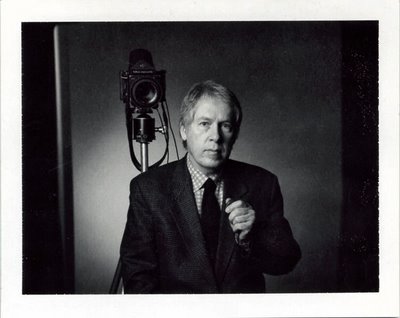
I received a polite notification yesterday from VLM/myvancouver editor/art director/publisher Bob Mercer (left) that he was ceasing publication of his magazine just about when the third incarnation of myvancouver was to appear on selected Vancouver doorsteps.
From my initial collaboration with Mercer in March 2007 I grew to like a man who had a vision to dream against all odds. I kept thinking to myself, "What does this man know about magazines that in my 35 years of working for them I don't know?" Had he really asked for my advice I would have told him, "Don't mortgage your house, don't launch this magazine. You will not succeed." I was critical of his efforts, but only marginally so as I wanted to keep my ability to dream. With Mercer's VLM I could dream about anything and somehow find a way of getting his positive nod, my execution of the assignment as both a written and photographic piece, and then anticipate the days until I would see that dream on the cover of VLM or prominently displayed inside with an elegant design and exquisite reproduction of my images.
While I was dreaming I was silently telling myself, "Mercer, you are a fool to hope that Vancouverites will embrace a good magazine in an age of aggregators that compile bad blogs about boring issues that are regurgitated from a declining media base that is replacing professional journalists with amateurs."
Ours is not an age of citizen journalism but one I would better call amateur journalism. The word amateur as used by the British of the 19th century denoted men (mostly men) and women who eschewed profit to embark on causes such as archeology, anthropology, botany, exploration, etc with a deep reverence and passion. These amateurs are a far cry from the amateurs of today who give us opinions on anything just because they can press and send.
"And even if you are a fool, Mercer," I kept thinking, "don't quit now. Give me room to dream. Give me room to think of people I would like to photograph and write about. Give me the opportunity to photograph Vancouver's most beautiful woman, Gloria Macarenko, give me the opportunity to photograph my friend Sean Rossiter with one of his model airplanes, give me the chance to photograph those wondrous ballet boys from Arts Umbrella and explore why they have a passion for dance." Mercer was foolish enough to keep his magazine going while I dreamt and dreamt to my heart's content.
With VLM/myvancouver gone, my capacity to see my dreams as real (the very reason why as fourth kind of fool I chose 35 years ago to become an editorial photographer) has now been diminished to just about zero. My only comfort is that Mercer, in spite of being a fool, had a great capacity to dream.
Mercer may have failed (he vows he will return in the fall) but I wonder if failure in such things is not amply compensated by that long run of dreams?
Three Fools & Gloria Macarenko
Monday, March 05, 2007
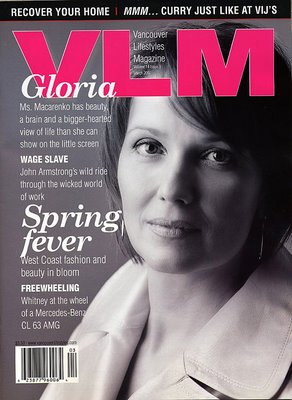
I have observed three fools in action over the years and when they finally give up there are many more of the type to occupy their place. These fools have the ambition to:
1. Publish and or edit a magazine, tabloid or newspaper.
2. Start an art gallery.
3. Open a restaurant.
It was quite a few years ago that Urban Peasant, James Barber had to withdraw from his Commercial Drive restaurant venture Arriva. He was losing his shirt. But he went on the record in a magazine article, how the experience had not turned him off. He asserted that when the opportunity rose he would start a restaurant again.
Dianne Farris once told me that she had not only mortgaged her house away to keep her gallery going but that she was also painting herself into a plumbing corner as the bathrooms did not work. But she was going to press on with her dream.
I think it is the dream that keeps these three "fools" going. You have an idea, and reality (with its instant satisfaction) can be quick in coming if you publish a weekly or a daily. I have been privy to conversations between publishers and editors where the former would swear a no inteference policy so as to keep an editorial independence. And I have seen these promises disappear as "service" peaces became the norm for keeping a magazine afloat.
As a photographer I have been promised more times than I can possibly remember, "This is a new magazine and we can only afford this much, but as soon as we become more successful we will pay you what you are really worth." I have seen young photographers, illustrators and freelance writers be given "photo" or "writing" credits instead of hard cash. I have never had the heart or the gumption to tell them that money will never come and photo credits are not proper collateral at the bank.
But would be gallery owners, restauranteurs and publisher/editors keep passing by my horizon and for the latter I am almost never able to say, "No," when asked to help out for little or no money.
Could it be that I am a dreamer, too?
The prospect of seeing a magazine with my cover photo has always been an exciting delight. My latest effort is no less a delight. It was about a month ago that experienced editor/art director Bob Mercer told me he had the project to re-brand the most horrible (my word) magazine in Vancouver.
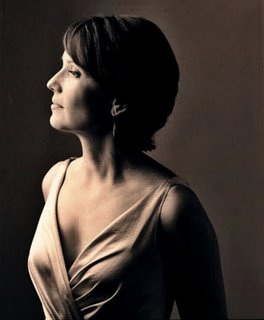
He said he wanted to turn around Vancouver Lifestyles Magazine (now called VLM)and wanted bold b+w covers. Best of all (this is how he lured me in) he wanted me to suggest who was the person I would want to photograph the most.
My answer was an easy one. I photographed the luminous Gloria Macarenko assisted by my secret weapon of so many years, stylist Maureen Willick.
When the magazine appeared last week I could not believe, that just for once, the spread looked better than I had imagined it.
I can only hope that editor/art director Bob Mercer's dream comes true.
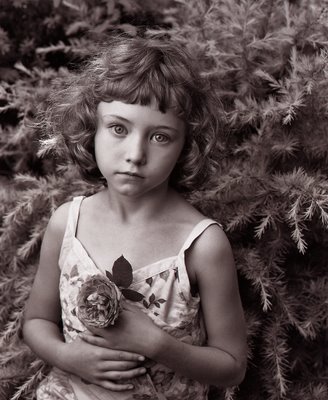
As the change in how the world and in particular those in Vancouver view photography, its purpose and its attraction I find that what I do is no different from re-gapping sparkplugs. It seems to me that my portrait photography is as obsolete as that skill (I was pretty good at it) of adjusting the gaps of the four sparkplugs of my Mexican VW beetle. After cleaning them and adjusting that gap with my precision gap tool I would take the VW up a hill and listen for engine hesitation. I would stop to rotate the distributor a bit in one direction or the other until the engine sounded just right.
For the 11 years that I have been taking portraits of my granddaughter Rebecca I have been criticized by the family for not making her smile. The first picture here, one that I took in 2004, is my favourite portrait of Rebecca. I have a beautiful 16x20 inch print, nicely framed on the wall next to my bed. When I wake up in the morning or before I turn off my reading light at nignt I look at it and my heart aches at her beauty and that look on her face.
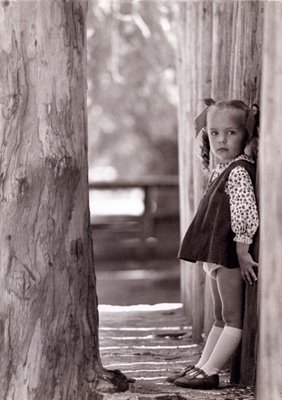
On my first year at the Catholic boarding school in Austin, St Eds (1957) there was a curious Catholic brother, curious because he could alternate friendliness with a cold, almost nasty seriousness. I was scared of him. His name was Brother Stanley Repucci CSC. Our nickname for him was “The Fat Sh..”. Brother Stanley had a fondness for pizza and he would go by all the school dormitories on Friday or Saturday evenings recruiting boys who might want to accompany him for pizza. In those days pizza joints came with red and white checkered table cloths with wicker Chianti bottles with candles. When I had the money, this was infrequent, I would tag along. Brother Stanley taught me to crave pizza at all times.
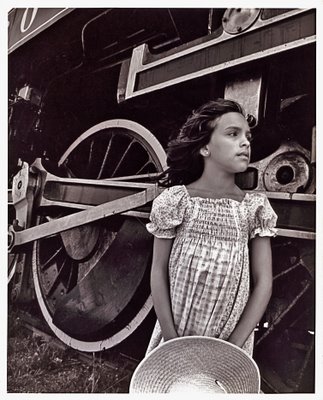
Brother Stanley taught physics and biology. He had a busy schedule as he headed the school’s rifle, bowling team and the Boy Scouts. He was always surrounded by young boys as he was in charge of the Cubs that were in the 8th grade.
Brother Stanley was tough and he never ever had any kind of discipline problems. It was Brother Stanley who concocted ways of making us excel in his classes promoting competition in unusual ways. Once, in our biology class, he asked us to open up some frogs and sew them back together. The boy, whose frog survived, would get a prize. More often than not the prize was a box of cigars. I think that because of it few of us ever smoked. Brother Stanley understood the mind of boys.

In our innocence and naivety we never thought that Brother Stanley had any kind of ulterior motives for his interest in us. In fact in my four years of boarding I was never aware of any scandal of any kind. Even in those days when we talked to prefects and our Brother teachers in their rooms the doors were kept open.
Brother Stanley died some years ago and his picture in the school web site lists him as Mr. Stanley Repucci. I found that odd and I wondered. But my fellow classmate and distinguished law professor at St. Mary’s University at San Antonio, Lee Lytton III and I both agreed on the reason. Brother Stanley left the order, got married and had children of his own.

There are many who think that the Reverend Charles Lutwidge Dodgson (Lewis Carol) may have had an unhealthy relationship with Alice Liddell. Both Lytton and I believe that Dodgson and Brother Stanley had a healthy love of children. They loved to inspire, entertain and nurture them. Brother Stanley and the Reverend Dodgson treated children as adults. In this century we are too rapid to judge and think the worse of people. The idea of a healthy love for children that is not a motherly or fatherly one is suspect. I guess I am almost safe when I take pictures of Rebecca as an adult because I am the grandfather.
The most useful advice (it felt brutal at the time) I have ever received from anyone came via Brother Stanley. I had decided to drop his physics class. It was too difficult and I did not want a low grade in the course to affect my high average. With that scary face of his (when he was serious) he looked at me squarely in the eye and told me, “It is hard to quit. It is hard for you to quit now. But you will find that it becomes easier when you practice. One day you will be an expert quitter.” I have never forgotten and when possible I have stuck to my guns.
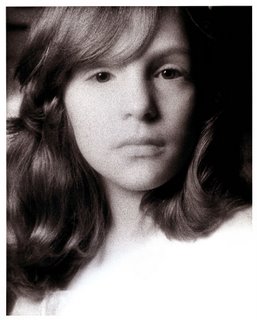
I don’t think I ever baby talked to Rebecca and when she faced my camera I gave her no instruction. I respected her for what she was and is, a little adult. I have taken her to ballet and dance with somewhat adult material and I have spoken to her candidly about stuff that would have shocked her other grandmother. But I feel that Brother Stanley’s guidance is the correct way to educate a young person.
When my daughter Alexandra was 14 she was going through some rebellion. She was sometimes rude and uncommunicative. I decided that I needed to make a father and son road trip, even if she were my daughter and not my son. I had a, bright yellow Fiat X-19 mid-engine sports car. I bought Bruce Springsteen’s The River, removed the top from the car and headed with Ale to San Francisco via the coast highway. On our first night we arrived somewhere in Oregon (note the picture of Ale by the Oregon coast, below). We went into a motel and the man behind the desk looked at us in disgust. It suddenly occurred to me what the man thought. How could I correct the situation? I knew how. I loudly told Ale, “Call your mother, if not she is going to worry.” The man looked at me with derision and threw the room keys at me. It was only then that I began to understand that people think the worst and that an extension of this would be my unsettling (to them) portraits of Rebecca not acting like the child that people perceive her to be. The world needs cameras that are pre-programmed to sense big smiles. That need has been recently filled.
Rebecca’s mother, my younger daughter Hilary is most often smiling. A great many of the pictures that I took of her through the years find her smiling, smiling with my mother’s and my crooked smile. But the pictures of her sister are another matter. There are many pictures that seem to be precursors of a style that I would learn to hone with Rebecca.
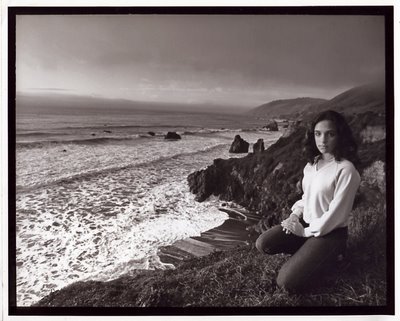
I think of Brother Stanley and how serious he was but how he could also be jovial. If he were to look at my pictures of Rebecca I am sure he would seriously hand me a box of cigars. And he would then smile.
Alexandra Elizabeth's Happy Melancholy
The Serious Ones

I received a polite notification yesterday from VLM/myvancouver editor/art director/publisher Bob Mercer (left) that he was ceasing publication of his magazine just about when the third incarnation of myvancouver was to appear on selected Vancouver doorsteps.
From my initial collaboration with Mercer in March 2007 I grew to like a man who had a vision to dream against all odds. I kept thinking to myself, "What does this man know about magazines that in my 35 years of working for them I don't know?" Had he really asked for my advice I would have told him, "Don't mortgage your house, don't launch this magazine. You will not succeed." I was critical of his efforts, but only marginally so as I wanted to keep my ability to dream. With Mercer's VLM I could dream about anything and somehow find a way of getting his positive nod, my execution of the assignment as both a written and photographic piece, and then anticipate the days until I would see that dream on the cover of VLM or prominently displayed inside with an elegant design and exquisite reproduction of my images.
While I was dreaming I was silently telling myself, "Mercer, you are a fool to hope that Vancouverites will embrace a good magazine in an age of aggregators that compile bad blogs about boring issues that are regurgitated from a declining media base that is replacing professional journalists with amateurs."
Ours is not an age of citizen journalism but one I would better call amateur journalism. The word amateur as used by the British of the 19th century denoted men (mostly men) and women who eschewed profit to embark on causes such as archeology, anthropology, botany, exploration, etc with a deep reverence and passion. These amateurs are a far cry from the amateurs of today who give us opinions on anything just because they can press and send.
"And even if you are a fool, Mercer," I kept thinking, "don't quit now. Give me room to dream. Give me room to think of people I would like to photograph and write about. Give me the opportunity to photograph Vancouver's most beautiful woman, Gloria Macarenko, give me the opportunity to photograph my friend Sean Rossiter with one of his model airplanes, give me the chance to photograph those wondrous ballet boys from Arts Umbrella and explore why they have a passion for dance." Mercer was foolish enough to keep his magazine going while I dreamt and dreamt to my heart's content.
With VLM/myvancouver gone, my capacity to see my dreams as real (the very reason why as fourth kind of fool I chose 35 years ago to become an editorial photographer) has now been diminished to just about zero. My only comfort is that Mercer, in spite of being a fool, had a great capacity to dream.
Mercer may have failed (he vows he will return in the fall) but I wonder if failure in such things is not amply compensated by that long run of dreams?
Three Fools & Gloria Macarenko
Monday, March 05, 2007

I have observed three fools in action over the years and when they finally give up there are many more of the type to occupy their place. These fools have the ambition to:
1. Publish and or edit a magazine, tabloid or newspaper.
2. Start an art gallery.
3. Open a restaurant.
It was quite a few years ago that Urban Peasant, James Barber had to withdraw from his Commercial Drive restaurant venture Arriva. He was losing his shirt. But he went on the record in a magazine article, how the experience had not turned him off. He asserted that when the opportunity rose he would start a restaurant again.
Dianne Farris once told me that she had not only mortgaged her house away to keep her gallery going but that she was also painting herself into a plumbing corner as the bathrooms did not work. But she was going to press on with her dream.
I think it is the dream that keeps these three "fools" going. You have an idea, and reality (with its instant satisfaction) can be quick in coming if you publish a weekly or a daily. I have been privy to conversations between publishers and editors where the former would swear a no inteference policy so as to keep an editorial independence. And I have seen these promises disappear as "service" peaces became the norm for keeping a magazine afloat.
As a photographer I have been promised more times than I can possibly remember, "This is a new magazine and we can only afford this much, but as soon as we become more successful we will pay you what you are really worth." I have seen young photographers, illustrators and freelance writers be given "photo" or "writing" credits instead of hard cash. I have never had the heart or the gumption to tell them that money will never come and photo credits are not proper collateral at the bank.
But would be gallery owners, restauranteurs and publisher/editors keep passing by my horizon and for the latter I am almost never able to say, "No," when asked to help out for little or no money.
Could it be that I am a dreamer, too?
The prospect of seeing a magazine with my cover photo has always been an exciting delight. My latest effort is no less a delight. It was about a month ago that experienced editor/art director Bob Mercer told me he had the project to re-brand the most horrible (my word) magazine in Vancouver.

He said he wanted to turn around Vancouver Lifestyles Magazine (now called VLM)and wanted bold b+w covers. Best of all (this is how he lured me in) he wanted me to suggest who was the person I would want to photograph the most.
My answer was an easy one. I photographed the luminous Gloria Macarenko assisted by my secret weapon of so many years, stylist Maureen Willick.
When the magazine appeared last week I could not believe, that just for once, the spread looked better than I had imagined it.
I can only hope that editor/art director Bob Mercer's dream comes true.
No Smiles For The Reverend Dodgson Or Brother Stanley Repucci
Monday, March 02, 2009

As the change in how the world and in particular those in Vancouver view photography, its purpose and its attraction I find that what I do is no different from re-gapping sparkplugs. It seems to me that my portrait photography is as obsolete as that skill (I was pretty good at it) of adjusting the gaps of the four sparkplugs of my Mexican VW beetle. After cleaning them and adjusting that gap with my precision gap tool I would take the VW up a hill and listen for engine hesitation. I would stop to rotate the distributor a bit in one direction or the other until the engine sounded just right.
For the 11 years that I have been taking portraits of my granddaughter Rebecca I have been criticized by the family for not making her smile. The first picture here, one that I took in 2004, is my favourite portrait of Rebecca. I have a beautiful 16x20 inch print, nicely framed on the wall next to my bed. When I wake up in the morning or before I turn off my reading light at nignt I look at it and my heart aches at her beauty and that look on her face.

On my first year at the Catholic boarding school in Austin, St Eds (1957) there was a curious Catholic brother, curious because he could alternate friendliness with a cold, almost nasty seriousness. I was scared of him. His name was Brother Stanley Repucci CSC. Our nickname for him was “The Fat Sh..”. Brother Stanley had a fondness for pizza and he would go by all the school dormitories on Friday or Saturday evenings recruiting boys who might want to accompany him for pizza. In those days pizza joints came with red and white checkered table cloths with wicker Chianti bottles with candles. When I had the money, this was infrequent, I would tag along. Brother Stanley taught me to crave pizza at all times.

Brother Stanley taught physics and biology. He had a busy schedule as he headed the school’s rifle, bowling team and the Boy Scouts. He was always surrounded by young boys as he was in charge of the Cubs that were in the 8th grade.
Brother Stanley was tough and he never ever had any kind of discipline problems. It was Brother Stanley who concocted ways of making us excel in his classes promoting competition in unusual ways. Once, in our biology class, he asked us to open up some frogs and sew them back together. The boy, whose frog survived, would get a prize. More often than not the prize was a box of cigars. I think that because of it few of us ever smoked. Brother Stanley understood the mind of boys.

In our innocence and naivety we never thought that Brother Stanley had any kind of ulterior motives for his interest in us. In fact in my four years of boarding I was never aware of any scandal of any kind. Even in those days when we talked to prefects and our Brother teachers in their rooms the doors were kept open.
Brother Stanley died some years ago and his picture in the school web site lists him as Mr. Stanley Repucci. I found that odd and I wondered. But my fellow classmate and distinguished law professor at St. Mary’s University at San Antonio, Lee Lytton III and I both agreed on the reason. Brother Stanley left the order, got married and had children of his own.

There are many who think that the Reverend Charles Lutwidge Dodgson (Lewis Carol) may have had an unhealthy relationship with Alice Liddell. Both Lytton and I believe that Dodgson and Brother Stanley had a healthy love of children. They loved to inspire, entertain and nurture them. Brother Stanley and the Reverend Dodgson treated children as adults. In this century we are too rapid to judge and think the worse of people. The idea of a healthy love for children that is not a motherly or fatherly one is suspect. I guess I am almost safe when I take pictures of Rebecca as an adult because I am the grandfather.
The most useful advice (it felt brutal at the time) I have ever received from anyone came via Brother Stanley. I had decided to drop his physics class. It was too difficult and I did not want a low grade in the course to affect my high average. With that scary face of his (when he was serious) he looked at me squarely in the eye and told me, “It is hard to quit. It is hard for you to quit now. But you will find that it becomes easier when you practice. One day you will be an expert quitter.” I have never forgotten and when possible I have stuck to my guns.

I don’t think I ever baby talked to Rebecca and when she faced my camera I gave her no instruction. I respected her for what she was and is, a little adult. I have taken her to ballet and dance with somewhat adult material and I have spoken to her candidly about stuff that would have shocked her other grandmother. But I feel that Brother Stanley’s guidance is the correct way to educate a young person.
When my daughter Alexandra was 14 she was going through some rebellion. She was sometimes rude and uncommunicative. I decided that I needed to make a father and son road trip, even if she were my daughter and not my son. I had a, bright yellow Fiat X-19 mid-engine sports car. I bought Bruce Springsteen’s The River, removed the top from the car and headed with Ale to San Francisco via the coast highway. On our first night we arrived somewhere in Oregon (note the picture of Ale by the Oregon coast, below). We went into a motel and the man behind the desk looked at us in disgust. It suddenly occurred to me what the man thought. How could I correct the situation? I knew how. I loudly told Ale, “Call your mother, if not she is going to worry.” The man looked at me with derision and threw the room keys at me. It was only then that I began to understand that people think the worst and that an extension of this would be my unsettling (to them) portraits of Rebecca not acting like the child that people perceive her to be. The world needs cameras that are pre-programmed to sense big smiles. That need has been recently filled.
Rebecca’s mother, my younger daughter Hilary is most often smiling. A great many of the pictures that I took of her through the years find her smiling, smiling with my mother’s and my crooked smile. But the pictures of her sister are another matter. There are many pictures that seem to be precursors of a style that I would learn to hone with Rebecca.

I think of Brother Stanley and how serious he was but how he could also be jovial. If he were to look at my pictures of Rebecca I am sure he would seriously hand me a box of cigars. And he would then smile.
Alexandra Elizabeth's Happy Melancholy
The Serious Ones
Sunday, March 01, 2009
1869
The Personal History And
Experience Of
David Copperfield The Younger
Chapter 1
I am Born
Whether I shall turn out to be the hero of my own life, or whether
that station will be held by anybody else, these pages must show.
To begin my life with the beginning of my life, I record that I was
born (as I have been informed and believe) on a Friday, at twelve
o'clock at night. It was remarked that the clock began to strike,
and I began to cry, simultaneously.
Charles Dickens
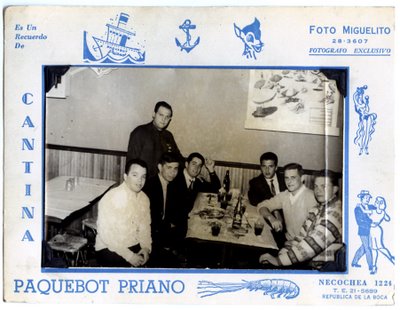
One of the most enthralling short stories I have ever read is Alejo Carpentier y Valmont’s Viaje a La Semilla (Journey Back To The Source) (1943). I have found the complete story in Spanish in many sites including here but the only copy in English that I can secure is residing at the UBC Library where they have all of this Cuban author’s output both in English and in Spanish. My $100 annual fee has lapsed so whoever wants to read this delightful story written with time going backwards, will have to do so in Spanish. The story ends with the nails of a brigantine anchored in a Cuban port, zooming away to the iron mines from whose ore they were extracted and the ship's oak planks flying away to a distant forest from whence they came.
Time has been on my mind of late and in particular my abhorrence for linear time. We moved to our present home in 1986 and our bed is exactly where it was then. I remember our first night after I placed our recently purchased French antique clock on the fireplace mantle of the den (then called the smoking room as I smoked pipes there). I could hear the clock striking the hour (I forget but it was late) and bent my head back to look out of the window. I remember telling Rosemary that I could not believe that we had moved to such a beautiful house. It was quiet and no long-haired neighbours would suddenly rush in next door (as they had so often done in our old strata title home in Burnaby) with cartons of beer and sing along to Creedence Clearwater Revival into the wee hours of the morning.
Time has passed, 23 years. But I still turn my head and look out of the window and marvel at it all.

It was yesterday that Rosemary made an astonishing statement in my direction. “You are not long for this world. You live in the past. You tell me what your mother (her watch given to her by my father, right) would have done. Everything was perfect then. It is all wanting now. You are most unhappy now. There is no sense for you to go on in such a state.” I was left speechless. I thought about it quietly. I thought about the past and about time.
It was around 1984 that I wanted to begin to write when I received a most important piece of advice from my friend and writer Les Wiseman. He told me, “You never begin a story from the beginning. You start somewhere in the middle and then work yourself both ways." This has served me well as it seems that most people wanting to tell a story and put it on paper invariably begin at the beginning. Time for them, as it is for most of us, is linear.
Without wishing to tell Rosemary that she is entirely wrong about my scrutiny into my past, I would like to clarify if not correct that my concern is a constant back and forth assessment on how the past put me into the present and how a backward glance might just reveal a forward path.
I do believe that as a human I like to maintain a sense of order. I want to know where things came from and where they are going. If I had a friend who disappeared in my past and almost in my memory I would like to pin my friend down, analyze why we are no longer friends (distance, physical separation). I try to locate my erstwhile friend, renew the friendship if possible or at the very least be able to neatly close the drawer.
It was sometime around 1988 when I went to Buenos Aires for the first time since I had left in 1966 that I was able to ring the bell at the home of Susy, an ex-girlfriend I had last seen in 1966 (was madly in love with her) and managed to survive her instruction, "Alex aren't you going to kiss me?" When she died of cancer a few years back I closed her drawer even though memories persist and are there to call back on demand.

Going to my St. Ed's High School reunion this June will put me into the same mode of looking back and pushing forward at the same time. I will study the bond my classmates shared for those four years we boarded in the great neo-Gothic building. Perhaps I will not have anything in common with the dentist, the lawyers, the funeral director, the adobe brick factory owner, the rice farmer, the bean counter who denies ever to have worked for the CIA, the contractor who profits from Texas coast hurricanes, the cowboy rancher who raises quarter horses, the NASA physicist, the PHD in nuclear energy, and the memory of my friend who in a Catholic school had the audacity to proclaim his belief in no God.
If nothing arises from the reunion I will at least be able to again enjoy when I chat with my ex-religion and saxophone teacher, Brother Edwin Reggio CSC, the unlikely occurrence that back in 1959 I would have never considered (had I looked into the future as my Rosemary suggests I do more often) that some day he, Brother Edwin, and my 10-year-old granddaughter Rebecca would sit next to each other and bite into a huge plate of Texas barbecue.
Time plays a curious game when we temporarily lose our sense of linearity. I had first learned about Einsteinian time in 1963 when my physics professor Chicurel told us the story of the two trains going in the same direction. In 1964 in my train leaving from the Retiro station in downtown Buenos Aires, I happened to glance out of the window and noticed that another train was leaving in the same direction. For a while it looked like both trains were not moving even though I could feel the vibration under my feet and hear the clickety-clack of the wheels. Then the other train accelerated and it seemed we were going backwards. I was amused as I considered that time was not what it seemed.
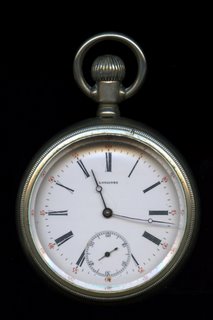
Since I was lucky enough to not be assigned to an Argentine naval base it meant that I had to pay for my lodgings in the Beccar (a suburb of Buenos Aires) home of a retired Nazi officer. The food was good, the price was right and I kept to myself. Knowing I needed funds one of my sailor mates, Victor Corrales (standing behind me in the photo above, asked me if I were willing to work with him as a waiter weekends in a cantina (bar that served food and had musical entertainment) in the legendary area of Buenos Aires, La Boca. The joint was called Paquebot Priano. The picture shows three of my Argentine Navy sailor mates, all dressed in black and three US Marines who worked with us at the Senior US Naval Advisory Group. It was after working until the wee hours of the morning that I would ride the train back to Beccar. One day, I will never forget, I fell asleep on the bed I was so tired. When I woke up it was late afternoon of the next day. It was six o'clock. I felt a bit tired but ultimately after a coffee I was refreshed. It all vanished when I noticed that the light was acting strangely. It was getting lighter not darker. That's when I knew it was six o'clock in the morning and that I had only slept at the most two hours.
Time (its ravages) is most evident when I go into my photo files and noticing how some of my photographs are stained (bad fixing and time accelerates the staining) or how I must labour at getting the colour right when I scan old colour negatives. But time seems strange when Rosemary and I file old family photographs, "Alex they will appreciate it when we are gone."
What that really means, and I will not mention it at all to Rosemary, is that we will be helping our daughters and granddaughters to explore their past, our past and what remains of our future.
The Magical Filipino Timex

Marking Time
Astern there was a closed door that he had never breached. From that place now came, very loud, a ticking, multiple and unsynchronized...After much hesitation, he made up his mind. He used the butt of his musket, broke the lock and entered...Clocks. Water clocks, sand clocks, solar clocks propped against the walls, but especially mechanical clocks arrayed on various shelves and chests, clocks moved by the slow descent of weights and counterweights, by wheels that bit into other wheels....
It may seem incredible - to you who read this with detachment - but imagine a castaway, amid the fumes of aqua vitae, on an unhabited vessel, finding a hundred clocks almost all in unison telling the tale of his interminable time; he must think of the tale before thinking of its author. And this is what Roberto did as he examined those toys one by one....The clocks were functioning, thus someone must have set them in motion, even if their winding had been designed to last a long time. And if they had been wound before his arrival, he would have heard them already, passing by that door.
...On the ship an intruder did exist.
He had entered the room and had wound the mechanisms. Why he had done so was the first but less urgent question. The second was where had he then taken refuge.
From "The Island of the Day Before", Umberto Eco, 1994
1869
The Personal History And
Experience Of
David Copperfield The Younger
Chapter 1
I am Born
Whether I shall turn out to be the hero of my own life, or whether
that station will be held by anybody else, these pages must show.
To begin my life with the beginning of my life, I record that I was
born (as I have been informed and believe) on a Friday, at twelve
o'clock at night. It was remarked that the clock began to strike,
and I began to cry, simultaneously.
Charles Dickens

One of the most enthralling short stories I have ever read is Alejo Carpentier y Valmont’s Viaje a La Semilla (Journey Back To The Source) (1943). I have found the complete story in Spanish in many sites including here but the only copy in English that I can secure is residing at the UBC Library where they have all of this Cuban author’s output both in English and in Spanish. My $100 annual fee has lapsed so whoever wants to read this delightful story written with time going backwards, will have to do so in Spanish. The story ends with the nails of a brigantine anchored in a Cuban port, zooming away to the iron mines from whose ore they were extracted and the ship's oak planks flying away to a distant forest from whence they came.
Time has been on my mind of late and in particular my abhorrence for linear time. We moved to our present home in 1986 and our bed is exactly where it was then. I remember our first night after I placed our recently purchased French antique clock on the fireplace mantle of the den (then called the smoking room as I smoked pipes there). I could hear the clock striking the hour (I forget but it was late) and bent my head back to look out of the window. I remember telling Rosemary that I could not believe that we had moved to such a beautiful house. It was quiet and no long-haired neighbours would suddenly rush in next door (as they had so often done in our old strata title home in Burnaby) with cartons of beer and sing along to Creedence Clearwater Revival into the wee hours of the morning.
Time has passed, 23 years. But I still turn my head and look out of the window and marvel at it all.

It was yesterday that Rosemary made an astonishing statement in my direction. “You are not long for this world. You live in the past. You tell me what your mother (her watch given to her by my father, right) would have done. Everything was perfect then. It is all wanting now. You are most unhappy now. There is no sense for you to go on in such a state.” I was left speechless. I thought about it quietly. I thought about the past and about time.
It was around 1984 that I wanted to begin to write when I received a most important piece of advice from my friend and writer Les Wiseman. He told me, “You never begin a story from the beginning. You start somewhere in the middle and then work yourself both ways." This has served me well as it seems that most people wanting to tell a story and put it on paper invariably begin at the beginning. Time for them, as it is for most of us, is linear.
Without wishing to tell Rosemary that she is entirely wrong about my scrutiny into my past, I would like to clarify if not correct that my concern is a constant back and forth assessment on how the past put me into the present and how a backward glance might just reveal a forward path.
I do believe that as a human I like to maintain a sense of order. I want to know where things came from and where they are going. If I had a friend who disappeared in my past and almost in my memory I would like to pin my friend down, analyze why we are no longer friends (distance, physical separation). I try to locate my erstwhile friend, renew the friendship if possible or at the very least be able to neatly close the drawer.
It was sometime around 1988 when I went to Buenos Aires for the first time since I had left in 1966 that I was able to ring the bell at the home of Susy, an ex-girlfriend I had last seen in 1966 (was madly in love with her) and managed to survive her instruction, "Alex aren't you going to kiss me?" When she died of cancer a few years back I closed her drawer even though memories persist and are there to call back on demand.

Going to my St. Ed's High School reunion this June will put me into the same mode of looking back and pushing forward at the same time. I will study the bond my classmates shared for those four years we boarded in the great neo-Gothic building. Perhaps I will not have anything in common with the dentist, the lawyers, the funeral director, the adobe brick factory owner, the rice farmer, the bean counter who denies ever to have worked for the CIA, the contractor who profits from Texas coast hurricanes, the cowboy rancher who raises quarter horses, the NASA physicist, the PHD in nuclear energy, and the memory of my friend who in a Catholic school had the audacity to proclaim his belief in no God.
If nothing arises from the reunion I will at least be able to again enjoy when I chat with my ex-religion and saxophone teacher, Brother Edwin Reggio CSC, the unlikely occurrence that back in 1959 I would have never considered (had I looked into the future as my Rosemary suggests I do more often) that some day he, Brother Edwin, and my 10-year-old granddaughter Rebecca would sit next to each other and bite into a huge plate of Texas barbecue.
Time plays a curious game when we temporarily lose our sense of linearity. I had first learned about Einsteinian time in 1963 when my physics professor Chicurel told us the story of the two trains going in the same direction. In 1964 in my train leaving from the Retiro station in downtown Buenos Aires, I happened to glance out of the window and noticed that another train was leaving in the same direction. For a while it looked like both trains were not moving even though I could feel the vibration under my feet and hear the clickety-clack of the wheels. Then the other train accelerated and it seemed we were going backwards. I was amused as I considered that time was not what it seemed.

Since I was lucky enough to not be assigned to an Argentine naval base it meant that I had to pay for my lodgings in the Beccar (a suburb of Buenos Aires) home of a retired Nazi officer. The food was good, the price was right and I kept to myself. Knowing I needed funds one of my sailor mates, Victor Corrales (standing behind me in the photo above, asked me if I were willing to work with him as a waiter weekends in a cantina (bar that served food and had musical entertainment) in the legendary area of Buenos Aires, La Boca. The joint was called Paquebot Priano. The picture shows three of my Argentine Navy sailor mates, all dressed in black and three US Marines who worked with us at the Senior US Naval Advisory Group. It was after working until the wee hours of the morning that I would ride the train back to Beccar. One day, I will never forget, I fell asleep on the bed I was so tired. When I woke up it was late afternoon of the next day. It was six o'clock. I felt a bit tired but ultimately after a coffee I was refreshed. It all vanished when I noticed that the light was acting strangely. It was getting lighter not darker. That's when I knew it was six o'clock in the morning and that I had only slept at the most two hours.
Time (its ravages) is most evident when I go into my photo files and noticing how some of my photographs are stained (bad fixing and time accelerates the staining) or how I must labour at getting the colour right when I scan old colour negatives. But time seems strange when Rosemary and I file old family photographs, "Alex they will appreciate it when we are gone."
What that really means, and I will not mention it at all to Rosemary, is that we will be helping our daughters and granddaughters to explore their past, our past and what remains of our future.
The Magical Filipino Timex

Marking Time
Astern there was a closed door that he had never breached. From that place now came, very loud, a ticking, multiple and unsynchronized...After much hesitation, he made up his mind. He used the butt of his musket, broke the lock and entered...Clocks. Water clocks, sand clocks, solar clocks propped against the walls, but especially mechanical clocks arrayed on various shelves and chests, clocks moved by the slow descent of weights and counterweights, by wheels that bit into other wheels....
It may seem incredible - to you who read this with detachment - but imagine a castaway, amid the fumes of aqua vitae, on an unhabited vessel, finding a hundred clocks almost all in unison telling the tale of his interminable time; he must think of the tale before thinking of its author. And this is what Roberto did as he examined those toys one by one....The clocks were functioning, thus someone must have set them in motion, even if their winding had been designed to last a long time. And if they had been wound before his arrival, he would have heard them already, passing by that door.
...On the ship an intruder did exist.
He had entered the room and had wound the mechanisms. Why he had done so was the first but less urgent question. The second was where had he then taken refuge.
From "The Island of the Day Before", Umberto Eco, 1994






